


2022 Issue 03
New Opportunities for Operator Transformation
Whether it is leading the digital transformation of traditional industries or guiding cross-sector innovation, the door to the future is wide open for telecom operators! This issue of Huawei Tech deep dives into new business opportunities waiting to be explored.

How Carriers Can Boost Revenues with All-scenario FWA
As more nations deploy 5G, the potential for growth in home, enterprise, and IoT scenarios can offer carriers higher ARPU, better pipe monetization opportunities, and a superior user experience if they implement optimum strategies.
FWA: From copper lines to optical fiber
Unconstrained by physical lines, wireless connections are more flexible and easier to use than wired connections. The rapid evolution of wireless technologies has boosted the capacity of FWA from satisfying basic connectivity needs to replacing copper lines with even higher speeds. FWA has great potential to compete with FTTx, with the peak rate of a 5G site at a single frequency band already comparable to wired 10G PON.
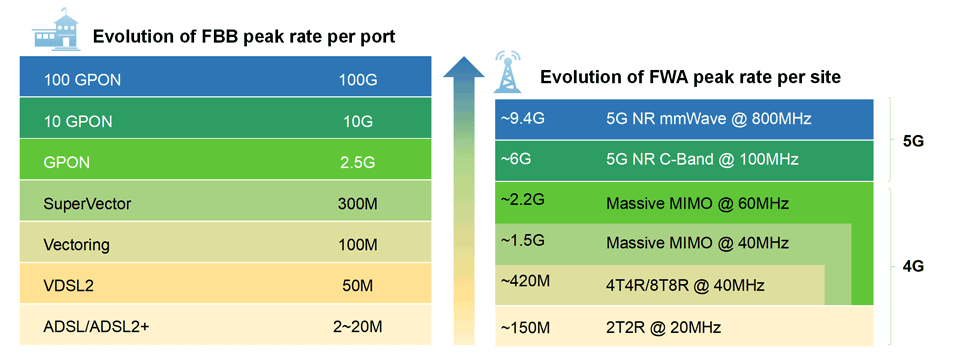
Figure 1: Peak capacity evolution of FBB and FWA cells
If carriers use 60% of the resources in 2.3 GHz and 3.5 GHz bands to develop FWA, the peak FWA capacity of a single site can reach 8.6 Gbit/s. TDD spectrum distribution for continuous high bandwidth is a common approach taken in many countries that enables 5G FWA capacity to be comparable to that of wired 10G PON.
FWA development at scale depends on what home broadband users need. In China, the 100 Mbit/s fixed network home broadband package in a tier-1 city in China provides a good example. Excluding IPTV, 8 Mbit/s is sufficient to meet home user needs, as mainstream home services are 480p and 720p OTT videos. For the next three to five years, 100 Mbit/s will be sufficient to meet the needs of most households.
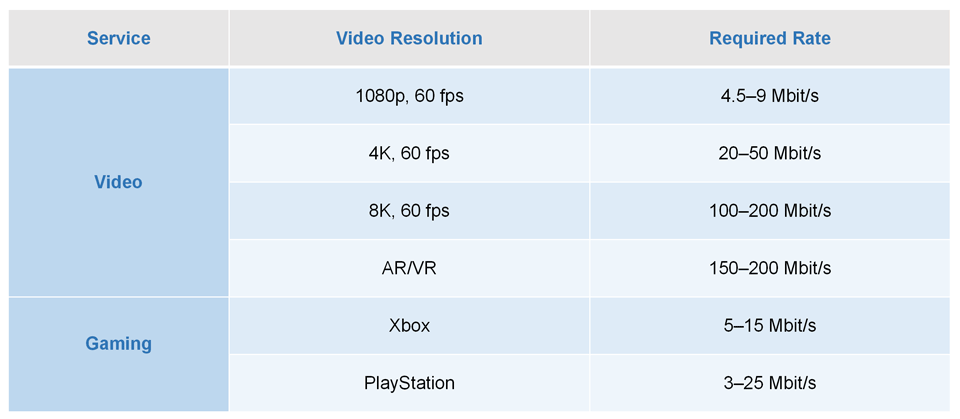
Figure 2: Bandwidth requirements of services
FWA services should be provisioned and planned based on user needs and wireless service characteristics. The number of households for which FWA services can be provisioned by a single site depends on the capacity of a wireless site, FWA traffic model, and the service rates users need.
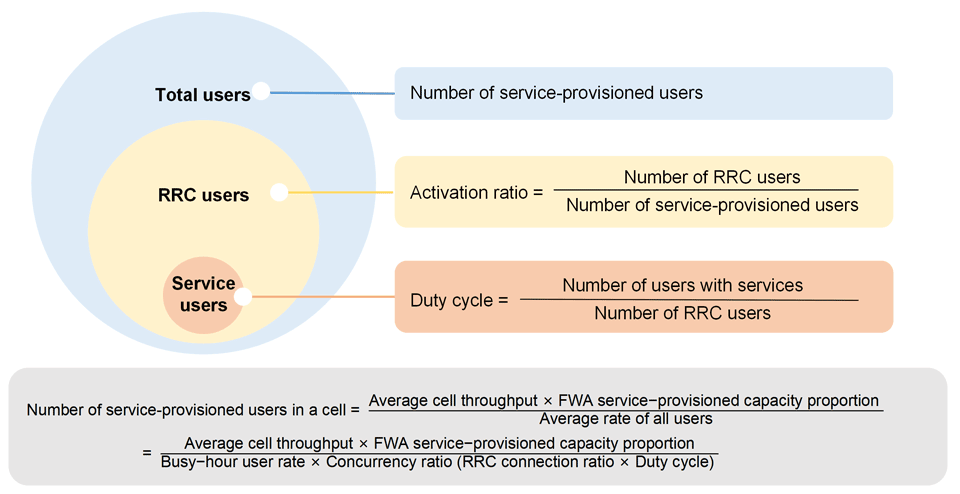
Figure 3: Model of the number of users for which wireless FWA service can be provisioned
According to an FWA traffic model data in different regions worldwide, assuming the rate that FWA users need is 50 Mbit/s when the FWA capacity is 8.6 Gbit/s per site, the activation ratio and duty cycle are 50% and 20%, respectively, maximum of 1,720 users can be provisioned in one site. This addresses the urban household density and home broadband rate requirements in most countries.
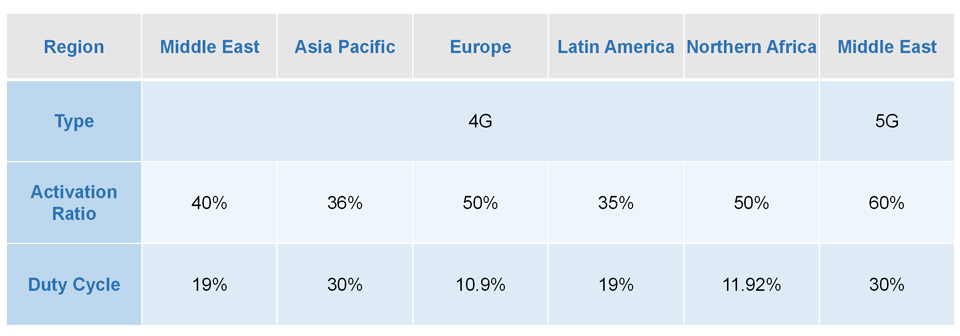
Figure 4: Typical FWA traffic models in different regions worldwide
FWA packages are mainly speed-based or volume-based with larger-data packages, with prices per GB lower than 5GtoC packages. In the early stages of 5G development, mobile broadband (MBB) networks were generally light load due to the low penetration rate of user devices. In addition, MBB's consumption of wireless resources is unbalanced in terms of time and space, and the busy hours of eMBB and FWA do not overlap. Efficient use of MBB resources during off-peak hours to develop FWA brings more benefits with quicker ROI. FWA is clearly a more efficient means of monetizing pipes.
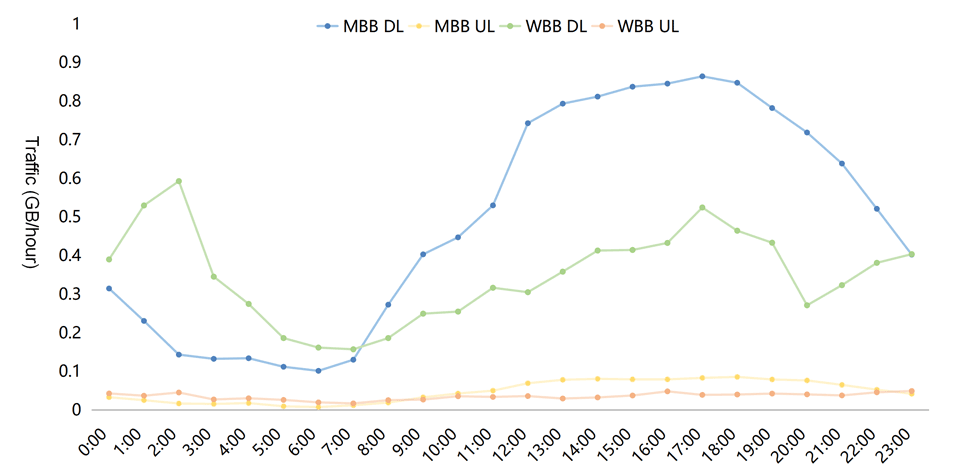
Figure 5: Traffic distribution of FWA and MBB at different times
The Future of FWA: 20% CAGR of users and significant market share outside China
By the end of 2021, the number of 4G/5G FWA users worldwide exceeded 65 million, with 4G FWA users accounting for 95% of the total. 5G FWA users are expected to account for 27% of all users by 2025. As 5G capacity increases exponentially, FWA has become mainstream.
In the Middle East, more than 1 million 5G FWA home broadband users provide carriers with 30-80% higher ARPU than 4G FWA. In western Europe, 5G FWA has been applied in many scenarios, including SMEs and RVs.
The FWA development experience of leading carriers worldwide shows that while 5G FWA improves perceived speeds, providing diverse bundled services is key. According to Huawei data, more than 80% of carriers that provide commercial 5G FWA offer packages that bundle Wi-Fi mesh, video, and gaming services. Huawei's recommendation for such carriers is the 1+1+X strategy, which means one high-performance air interface that improves the home broadband rate, one seamless Wi-Fi coverage solution, and a variety of home services such as 4K OTT video and cloud gaming.
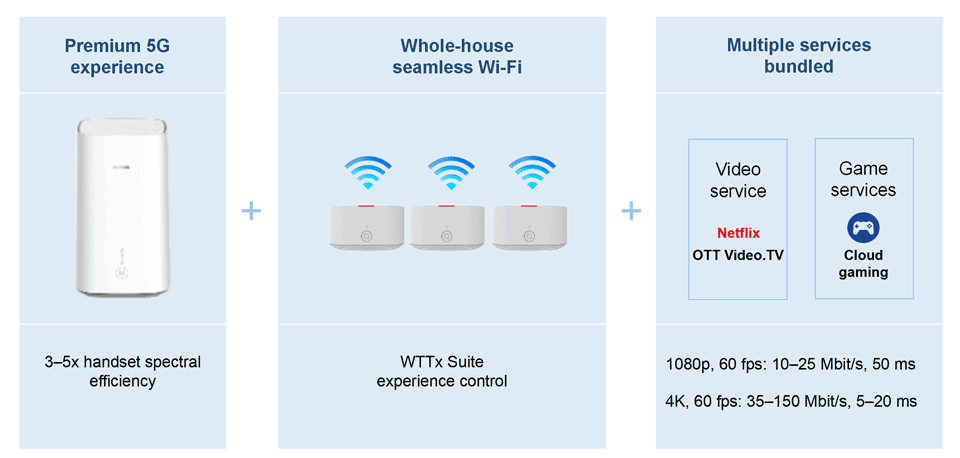
Figure 6: 1+1+X wireless FWA service development strategy
The development of FWA services at scale creates requirements for CPE prices. Developed markets are less sensitive to CPE costs, and so business model design is more important. In markets with fair credit systems, such as North America, the Middle East, and Europe, CPE costs can be dispersed through leasing or installment. In developing markets sensitive to CPE prices, 4G and 5G coordination is needed. To generate higher ARPU, carriers can develop entry-level users through 4G CPE with competitive pricing, and high-end users with 5G CPE with similar pricing to optical fiber solutions.
Understanding broadband IoT from the FWA perspective
The advent of 5G has clearly helped FWA expand from homes to enterprises. For example, work from anywhere is an FWA business scenario for SMEs that provides guaranteed connectivity, as well as work suites, including online meeting software, telephony services, and 24/7 assurance services. The core of these services is to go beyond connectivity and provide micro-integrated, differentiated capabilities. Based on its expertise gained from around the world, Huawei has summarized 12 private line use cases, including SME private line and mobile banking, which are differentiated product portfolios based on FWA connectivity. By July 2021, 27 carriers had worked with Huawei to launch 5G FWA Business services.
FWA can connect homes, enterprises, and everything. The parcel lockers and vending machines that can be found everywhere are all based on Cat4 broadband connections. Broadband connectivity integrates both narrowband IoT (NB-IoT) and high-bandwidth 5G NR. In terms of IoT, the value of connectivity for NB-IoT generally accounts for less than 10% across the industry value chain. Most of the value lies in devices, platforms, and applications. This conclusion is in line with the need for FWA enterprise connectivity to move upstream by providing micro-integration. Carriers should consider developing integration capabilities that match value distribution along the industry value chain.
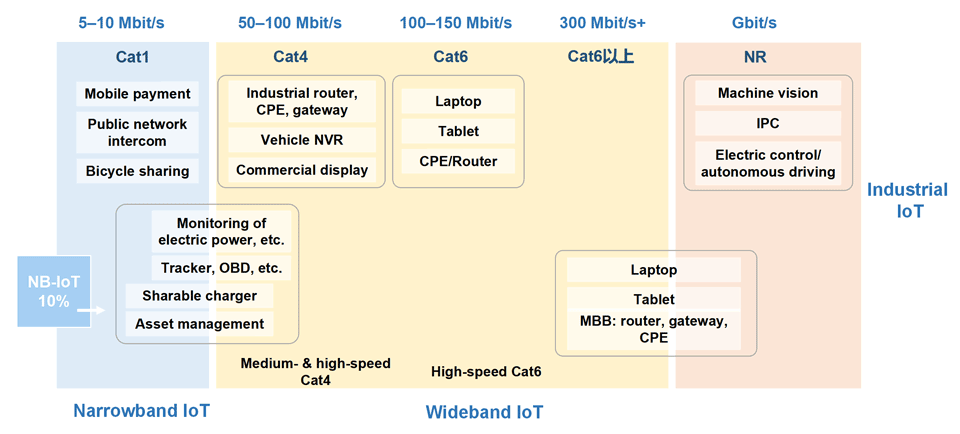
Figure 7: Broadband IoT application scenarios and required rates
5G's main advantage over 4G is support for ultra-low latency and ultra-high bandwidth, which enables two types of high-value IoT toB scenarios: Critical IoT and industrial automation IoT. These scenarios require high reliability and low latency, as well as support for features such as 5G LAN and clock synchronization. Massive IoT and broadband IoT are essentially a continuation of 4G connectivity.
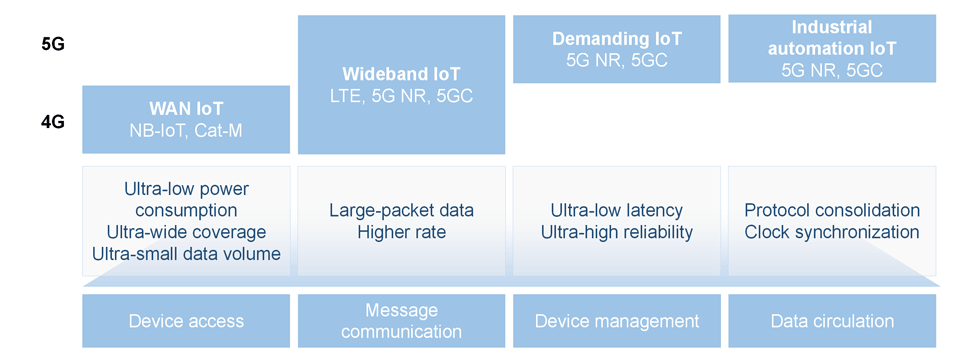
Figure 8: Four types of IoT connectivity scenarios
Regarding the connectivity scenarios and their value, the following conclusions can be drawn:
- ToC services connect people, and have a large number of users and high value.
- FWA home connectivity is a type of broadband IoT with a massive user market. Carriers must design services based on wireless characteristics, and the core of these services is to adapt busy-hour rates to users' service needs.
- The business model for most Massive IoT services, including NB-IoT and Cat1/Cat4 connectivity, is retailing SIM cards and charging by traffic, which generates low ARPU.
- As a type of broadband IoT, FWA enterprise connectivity is a high-ARPU scenario. Carriers have started to incubate this scenario at scale, but they must be able to integrate and provide differentiated services. For business model design, carriers can use fixed private lines as a reference, but must adapt it to wireless features. Currently, enterprise services with high symmetric uplink and downlink rates (≤50 Mbit/s) are not recommended.
- Critical IoT and industrial IoT are both high-value scenarios. They are differentiated 5G capabilities superior to 4G and are key capabilities for application in vertical industries. They can contribute to the high-value monetization of connectivity.
Unlimited value of network slicing: WAN toB from the FWA perspective
From a geographical point of view, connectivity can be divided into WANs and LANs. WAN connectivity is based on MBB networks with nationwide coverage, whereas LAN connectivity is based on local area networks. FWA falls within the scope of WAN connectivity. While the biggest challenge facing WAN FWA is the impact of multi-service networks on the toC service experience, the biggest challenge for WAN toB services is balancing the impact of multi-service networks on the toC service experience.
How does FWA balance the experience of multiple services and reduce the impact on the toC service experience? The solution is to use the FWA Suite tool to perform evaluation before service provisioning by evaluating signal quality in real time where the services are provisioned, and calculating the required resources based on the spectral efficiency of the air interface. QoS resource scheduling can set the upper limit of resources usable by FWA. The toC service experience can be ensured using priority-based scheduling during congestion. Given the limited air interface capabilities, the essence of this solution is to allocate resources appropriately and achieve basic slicing of air interface resources.
The recommended method to balancing the multi-service experience on a WAN is as follows: If resources are limited, split the limited resources for toC, toH, and toB services. Then deploy and optimize wireless pipes to accommodate multiple services. If spectrum resources are sufficient and user development is expected to be positive, dedicated networks can be deployed for new services. For example, TDD spectrum can be used to deploy FWA toH/toB dedicated networks.
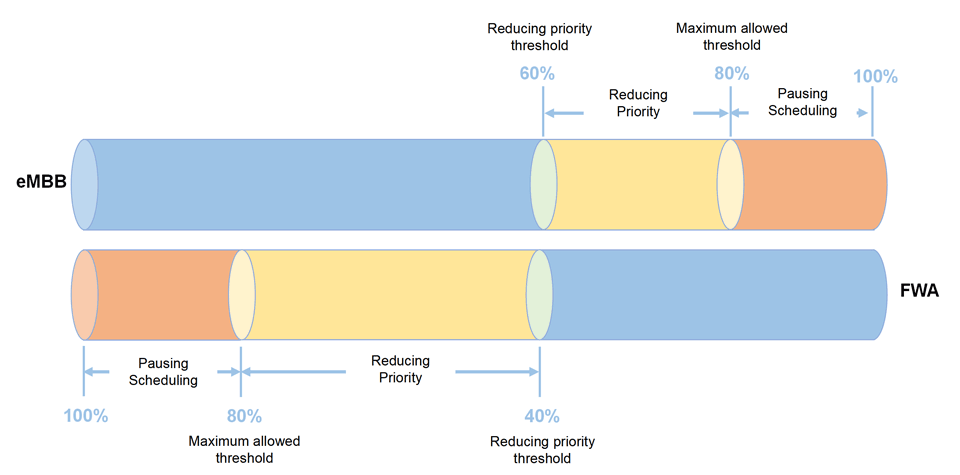
Figure 9: QoS PRB control solution for multi-service networks
E2E slicing is a key capability to meet differentiated service requirements of different industries using WAN toB services such as speed acceleration, security isolation, and service assurance. The following FWA guidelines can be used as a reference for WAN slicing:
1. Absolute hard slicing should be used with caution on WANs. Before toB service provisioning, it is recommended that you use the FWA Suite tool to evaluate the resources needed by users before toB service provisioning. Doing so can avoid resource preemption that compromises consumer service experience. Soft slicing based on QoS scheduling priorities is more secure.
2. Hard slicing applies to these scenarios: occupation of a small number of resource blocks (RBs), temporary hard slicing (released upon exhaustion), and hard slicing within a small geographic area (toC hot areas should be avoided).
3. Hard slicing on a dedicated network that is isolated from toC resources does not need to consider its impact on toC service experience. This will maximize toB service experience. 5GtoB dedicated LANs support demanding IoT and industrial IoT, and are superior to WANs in this regard.
The key to all types of connectivity carried on a wireless network is to build pipes with sufficient bandwidth. Only a road that is wide enough can accommodate a large number of vehicles through shared lanes, dedicated lanes, and tidal lanes. This type of road enables more options and a greater vision of the future.
FWA is a solution positioned somewhere between wired and wireless networks, and a crossover product for both homes and enterprises. FWA can involve both narrowband and wideband IoT, and evolves from 4G to 5G. Huawei works to make FWA the ultimate last mile for home and enterprise broadband and facilitate the appropriate use of both wired and wireless technologies in IoT, enabling FWA to be applied in more scenarios.


The Second Revolution of Optical Networks: The Strategic and Business Value of FTTR for Carriers
With the right approach, carriers can use FTTR to enable product and service differentiation, overcome competition from OTT players, and boost their brand equity.

China's carriers have deployed or upgraded all access networks with optical fiber over the past decade, representing the first optical-network revolution and laying the foundation for second optical revolution of FTTR.
By the end of 2021, China's digital economy had experienced fivefold growth over the preceding decade to reach 44.9 trillion Chinese yuan, transforming the nation into a cyber powerhouse. During that time, the proportion of the digital economy in relation to the national economy doubled from 20% to 40%.
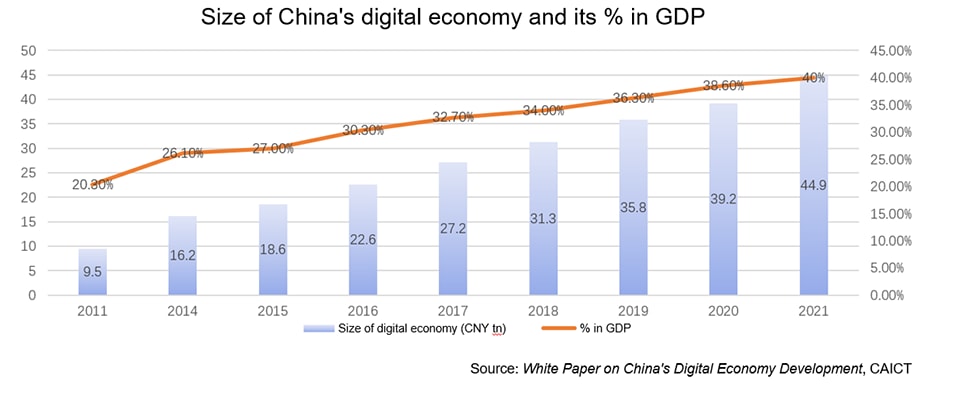
Ⅰ. Strategic value of fiberization
China's “Cyber Powerhouse ”strategy began with fiber broadband. In the industrial policy environment of triple play network convergence, Shanghai Telecom took the lead in proposing the "Metropolitan Optical Network (MONET)" strategy in June 2009, prioritizing FTTH network deployment. Based on the successful practice of Shanghai Telecom, China Telecom launched its "Broadband China ▪ Optical Network City" strategy in February 2011. In 2013, "Broadband China" was upgraded to a national strategy.
By the end of 2021, China had more than 500 million broadband users, 94% of whom were fiber broadband users. Of those, 92% were subscribed to megabit bandwidth, while 35 million were subscribed to gigabit bandwidth. By the second quarter of 2022, the number of gigabit users had jumped to 56 million.
Without fiber, neither fixed nor mobile networks can flourish. Fiberization ratios are key indexes for measuring network development, including the ratios of fiber to the home, fiber to the enterprise, and fiber to the base station.
China's carriers have deployed or upgraded all their access networks with optical fiber over the past decade. The first optical-network revolution laid the foundation for China to become a cyber powerhouse. And over the next decade, the second revolution of optical networks will realize the fiberization of home networks and enterprise LANs with fiber to the room (FTTR). It will achieve the development goal of end-to-end full-fiber networks, and further strengthen the position of the Cyber Powerhouse strategy.
The two basic factors that determine communication bandwidth are the frequency characteristics of the transmission medium, which is the most important parameter, and the corresponding modulation technology. Comparing the frequency characteristics of copper wire and single-mode optical fiber provides many useful insights.
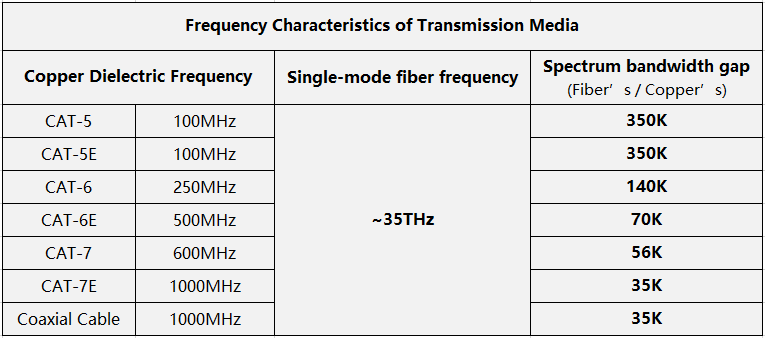
The above table shows that the spectrum capability of fibers can exceed that of copper wire by tens of thousands to hundreds of thousands of times. While the bandwidth potential of copper wires is limited, the potential for fiber is infinite. Due to bandwidth bottlenecks, copper wires need to be upgraded every five to ten years, making network evolution more difficult. In contrast, fiber has a long service life and can be deployed in one go without requiring re-cabling for 30 years. Currently, fiber is the transmission medium that offers the highest bandwidth potential. Compared with copper wires, fiber consumes less energy and is more suitable for achieving green development goals.
Ⅱ. FTTR brings new business value to carriers
From the perspective of carriers, FTTR can bring obvious strategic opportunities in the areas of differentiation, premium quality, and visualization, giving carriers an entry point to home and enterprise LANs. Notably, FTTR is more valuable for SMEs. .
1. Differentiation and Premium Quality
Differentiation is a powerful tool for enterprises to improve competitiveness and achieve sustainable development.
Differentiation in terms of products can maximize value and provide benefits from market segmentation. Differentiation through competition can include different quality offerings at the same price or different prices at the same quality.
In the government and enterprise markets over the past two decades, Chinese carriers have recognized the competitive advantages brought by differentiation in terms of tariffs, quality, bandwidth, protection and recovery, latency, visualization, product differentiation of other value-added services, and differentiation in pre-sale, in-sale, and post-sale capabilities and levels. However, in the home broadband market, much space still exists for differentiation. Current home broadband packages focus on differentiated tariffs and bandwidths, but do not take advantage of quality differences. With the homogeneous competition of home broadband, quality and service differentiation will become more important for home broadband. As one executive of a Chinese carrier noted, there are nearly 300,000 high-income individuals in the city where he lives. They are the potential customers of Home FTTR and can help enhance the brand equity of the carrier.
Brand equity is one of an enterprise ’s most important assets and is in turn intrinsically linked to the perception of premium quality. As the FTTH user market of Chinese carriers is approaching saturation, home Wi-Fi networking has become a mainstream method for carriers to enhance customer loyalty and improve competitiveness. Compared with traditional Ethernet cable Wi-Fi, FTTR-based optical cable Wi-Fi delivers superior home-network quality. People perceive optical fiber as representing premium quality, which is the ultimate goal of home networks.
For tier one fixed carriers, FTTR can build up brand equity for their broadband offerings. For tier two and tier three fixed carriers, FTTR can be used as an effective means to overtake competitors. The window of opportunity is determined by differentiated competitive ability. Whoever deploys FTTR first will attract users first, especially high-end users. Opportunity knocks but once.
The carrier I worked at for 30 years launched the "Metropolitan Optical Net" project in 2009 and the "World's First Gigabit City" project in 2016. Were these projects all driven by service demand? Not entirely. At the time, they were oriented not only to service demand, but also to competition. This carrier took the lead in deploying its optical network in order to seize the opportunity of service development, consolidate infrastructure network capabilities, raise the competition threshold, and build up its broadband brand equity. Some people were against the projects at the time, because they were not underpinned by business requirements. But, now they applaud the wise strategic decision. Pipes are always the foundation of carriers, whether fixed or mobile. Numerous successes and failures in history have proven that in the Internet era, bandwidth and latency always represent core competitiveness.
Demand can be stimulated and created. It can be driven by business, competition, technology, investment, or policies. And more recently, even the pandemic has proven to be a driver. Are Chinese 5G and Gigabit optical networks driven by business requirements? In my opinion, they are the sum of the above-mentioned driving forces.
2. Visualization
Compared with traditional Ethernet cable Wi-Fi, FTTR requires communication protocols between the master gateway and slave gateways, which brings visualization to carriers and end-users.
Visualization for carriers: Through NCE-FAN carriers can obtain various fault data from home networks. Through big data analysis, they can remotely guide end users to resolve a large number of faults, reducing O &M costs caused by unnecessary onsite visits. Based on AI analysis of Internet surfing characteristics, carriers can market AI-based application acceleration packages to specified user groups and benefit from providing value-added services (distance education and cloud games, and so on).
Visualization for end users gives controllability of certain functions: Users can use an app to view connection topology, connected terminals, connection types, and connection status on their home network; verify the installation and maintenance quality of carriers; and control the online time and content of various terminals, including games, videos, office work, social networking, and payments. In addition, they can detect the network, device, interference, coverage, configuration, and load status, greatly improving the service experience for end users.
Making, not saving, money is the goal. To make money, expenditure is required. So, reducing procurement costs should not be at the expense of network and service performance and functions, nor should we focus only on procurement costs and ignore O &M costs. Procurement costs are one-off, while O &M costs are long-term and need to be considered systematically.
3. Consolidate the home DICT foundation
On home networks, carriers have advantages in gateway connections and door-to-door services. Carriers compete with OTTs for the entrance of home network connections, while carriers compete with each other in installation and maintenance capabilities, which require better O &M teams and systems.
The home network connection entrance is a core advantage possessed by carriers. However, traditional home Wi-Fi networking solutions, such as ethernet cables, PLCs, and Wi-Fi relays, are used. OTT devices have their own smart home solution ecosystem based on home routers. Therefore, carriers' home network connection entrances are often bypassed by OTT devices, so the advantages of the home gateway cannot be fully utilized. FTTR can completely change this situation. Because communications-specific technology is used between the master and slave FTTR gateways, OTT home routers are not an option. This enables carriers to control access to home network connections through the master gateway of FTTR, consolidating the foundation of home DICT.
Network connectivity is a key advantage of carriers, including Wi-Fi networking, which ensures user experience and door-to-door service awareness. OTT is good at service applications, for example, using a smart speaker at the entrance to implement service control with human-machine interaction. Professionals handling professional issues creates a reasonable and sustainable ecosystem.
4. ToB is more valuable
Historically, one carrier provided a large number of enterprise gateways for small and micro enterprise customers. The purchase price of an enterprise gateway is at least five times higher than the price of a home gateway, but most of these were used in bridged mode. The carrier spent large sums on enterprise gateways, but they did not get any more business opportunities through bridged mode. The reason is that carriers do not provide perfect Wi-Fi networking solutions for enterprises, with the market in fact occupied by third-party ICT integrators.
ToB is more valuable. The FTTR-SME can make full use of the resource advantages of carriers ’installation and maintenance services. Through a package solution including cabling, the FTTR-SME can help carriers extend from WAN to LAN and solve the problems of wired and wireless broadband access and providing internal network connections for enterprise customers. Expanding sales scope from a leased line of Internet to enterprise Wi-Fi networking of Intranet services can expand the market space, improve user experience, and enhance customer loyalty. Moreover, carriers' cloud-network synergy resource advantages can be leveraged to meet the cloud migration requirements of enterprise digital transformation, bringing new opportunities for DICT service development.
The home network and SME network are not simple connections of various terminals. They are also a network that needs to be visible, manageable, and maintainable. The FTTR package solution covers not only the gateway itself, but the entire SME and home LAN. Compared with traditional AC+AP and Mesh Wi-Fi networking, FTTR has unmatched advantages in anti-interference capability, roaming handover delay, bandwidth capability, user experience, visibility, manageability, and O &M.
FTTR in China is developing on a large scale. By the first half of 2022, the three major carriers in China had attracted 400,000 FTTR subscribers, a five-fold increase over the second half of 2021. By the end of 2022, this is expected to exceed 2 million. As well as China, more than 20 carriers in West Europe, Asia Pacific, Latin America, and Middle East are very optimistic about the FTTR development direction and are actively conducting pilots, with some specifying their FTTR strategic development goals.
Learn more about Huawei ’s FTTR solution.


The Second Revolution of Optical Networks: The Large-scale Development of FTTR
China's optical FTTR market is thriving, so what can policy makers and global carriers take from its best practices?

The FTTR market consists of two major segments: The first is indoor optical cable installation provided by construction companies and interior design companies. The second is indoor optical cable installation provided by carriers.
1. The market segment of indoor optical cable installation provided by construction companies and interior design companies
This market segment concerns newly built houses and apartments and pre-owned houses and apartments.
1) Newly built houses and apartments
Newly built houses and apartments mainly involve real estate developers. Government departments release codes or technical white papers for communications facilities. At the national level, responsibility lies with the Ministry of Housing and Construction and the Ministry of Industry and Information Technology (MIIT), and at the local government level, the Administration of Housing and Construction and Communication Administration is responsible. China has positioned the construction of residential buildings with communications facilities as a basic necessity for work and life, much the same as water, electricity and natural gas.
As early as 2012, China's Ministry of Housing and Construction released the Code for Optical Fiber to the Home Communication Facilities in Residential Areas and Residential Buildings, which stipulates that in new residential buildings, fiber should replace Ethernet cables and telephone lines and be deployed to the entrance of homes. This code controls telecom network construction standards from the source. It has led the whole ecosystem and industry, and promoted the rapid development of FTTH in China.
If a previous code still defines that Ethernet cable and voice cables must be installed at home entrances, then multiple access modes will exist for fixed broadband networks such as FTTB/C and HFC. This will inevitably delay the progress of developing optical networks in China.
Today, China's 14th Five-Year Plan and the 2021 government work report have set out requirements for the development of 5G and gigabit optical networks, aiming to develop China into a “Cyber Powerhouse ”and accelerate the digital economy. On March 24, 2021, the Ministry of Industry and Information Technology (MIIT) released the Dual-Gigabit Action Plan to promote home-cabling and optimize gigabit wireless LAN networking. On April 6, 2021, 16 ministries and commissions in China jointly released Guidance on Accelerating the Development of Digital Homes and Improving Residential Quality, encouraging the construction of fiber-to-the-room and fiber-to-the-desktop, and focusing on improving the quality of residential indoor networks. As a result, government departments in Fujian, Shandong, and Yunnan in China have developed building communication standards for FTTR. They specify that indoor cabling should adopt fiber instead of Ethernet cables. The Fujian standard is the Building Communication Infrastructure Construction Standard, which was released on August 1, 2021. The Shandong standard is the Technical Standard for Intelligent Building Engineering, which was released on April 1, 2022. The Yunnan standard is the Construction Standard for Fiber-to-the-Home Communication and Cable Television Facilities in Residential and Commercial Buildings, which has been drafted for consultation.
To guide the development of the ecosystem and industry and to improve the customer experience, there are three key points for formulating FTTR standards for communication facilities inside buildings:
First, Ethernet cables are no longer considered for indoor cabling, because they would affect the development of end-to-end full-fiber networks.
Second, fiber electric composite cables are recommended for power over fiber. If traditional flat fiber is used, fiber-connected Wi-Fi devices need to be connected to an external power supply, which would impact the decor of houses and user experience.
Third, the demarcation between real estate developers and carriers needs to be clarified. The home information box, A86 panel box, and fiber electric composite cables are constructed and installed by developers. The master FTTR gateway, slave FTTR gateways, and optical splitter are installed, provisioned, and maintained by a carrier selected by the end user.
2) Pre-owned houses and apartments
More details about this category are provided in “The indoor FTTR cabling code of Communication Engineering for New Residential Buildings ”issued by the national, provincial, or municipal governments.
For end-users, carriers need to develop a “Home Decoration Cabling Manual ”for FTTR and a corresponding video. The manual and video should be available in the carrier's service center so that end users can view the video and obtain the manual at any time. Online business halls should also play the video.
The interior design industry and mainstream interior design companies should conduct communication activities and hold forums to discuss and develop scenario-based FTTR solutions.
2. The market segment of indoor optical cable installation provided by carriers
1)Top executive leadership
As the second revolution of optical networks, FTTR can build up its brand image only when it is scaled up. This involves cost budgeting, package design, marketing channels, installation and maintenance capabilities, business processes, and digital capabilities. It involves multiple departments and requires strategic determination and roadmap from top managers.
2) Standardization
Only standardization can achieve large scale and premium quality. For standardization work involving large-scale FTTR deployment, carriers need to formulate the following standards:
Cable technical specifications: encourage industry associations to formulate technical standards for fiber electric composite cables and connection components to promote ecological and industrial construction.
FTTR installation procedures: formulate a scenario-based installation process, installation standards, and terminal selection. Terminal types include A86 panels, desktop, and ceiling-mounted terminals.
Training materials: develop systematic training materials.
3) Marketing capabilities
Public publicity: produce easy-to-understand FTTR advertorials and videos, and publicize and broadcast them in the mass media.
Package design: design premium, differentiated, and modular packages. Carriers should increase the FTTR sales commission for marketing staff to motivate FTTR sales.
Five-star business hall: set up the FTTR service-experience environment that users can experience onsite.
Expand sales channels: includes business halls, online sales channels, ecosystem partners, and installation and maintenance engineers and so on.
4) Installation and maintenance capabilities
Installation and maintenance capabilities sit at the core of competition and the sustainable development of fixed network services, especially in the context of home DICT development. The installation of FTTR is more complex than FTTH. Therefore, the bottleneck in large-scale FTTR deployment rests with installation and maintenance capabilities.
There is a need to implement a series of measures:
Set up an engineer team for VIP users: This team would comprise a certain number of engineers and professionals with high-level skills to expand the team of smart home engineers and provide differentiated service levels and capabilities.
Increase the salary of installation and maintenance engineers: There is still a salary gap between installation and maintenance engineer and those responsible for delivery. The low income of skilled people cannot reflect the value of their skills, and is not conducive to retaining skilled talent.
Strengthen training in installation and maintenance: Set up an FTTR training base to carry out installation and maintenance training, examinations, assessments, and certification based on the home DICT service.
5)Digitalization capabilities
Digital capabilities of "planning, acceptance, and maintenance" must be built to make FTTR Wi-Fi visible, manageable, and controllable so as to improve user experience and service efficiency.
“Planning ”: Simulation planning for visualized effect, including site survey, requirement collection, device installation location planning, effect simulation, and user confirmation.
“Acceptance ”: Three-step acceptance ensures quality. Network acceptance includes ODN, devices, and connections topology. Service acceptance includes Wi-Fi speed tests, IPTV, and Internet access. User confirmation is involved in acceptance.
“Maintenance ”: includes remote demarcation, intelligent fault diagnosis, and the automatic output of quality evaluation reports.
6) Others
Construction tools: Further optimize and improve construction tools and processes.
FTTR service exhibition hall: Set up a service exhibition hall for external ecosystem partners based on home &SME DICT services to improve the perception of FTTR quality for governments, industries, society, and the public.


Innovation Strategies for B2B Telecom Solutions
2020 to 2030 will see the Industrial Internet thrive. Leading global carriers must innovate new intelligent, digital services, transform their business models in the new arena and achieve new growth in vertical industries.
Internet companies have thrived during the decade of the mobile Internet. Microsoft, Apple, Google, and Amazon had a combined value of US$6 trillion in 2021, and Apple was valued at US$3 trillion in 2022. In contrast, the telecom industry experienced a period of decline, with its growth rate dropping to 2%–3%. GSMA predicts that if carriers continue the "dumb pipe" business model, the growth rate will be only 1.5% between 2021 and 2027, and that the market space will not exceed US$2 trillion in 2027, despite a booming Industrial Internet.
What should the telecom industry do? The answer is transformation.
The Industrial Internet: A blue ocean with challenges
New technologies like 5G, cloud, big data, artificial intelligence, and IoT are creating a new wave of Industrial Internet innovation and development. Driven by national digital economy strategies, the Industrial Internet will become the biggest blue ocean for new growth.
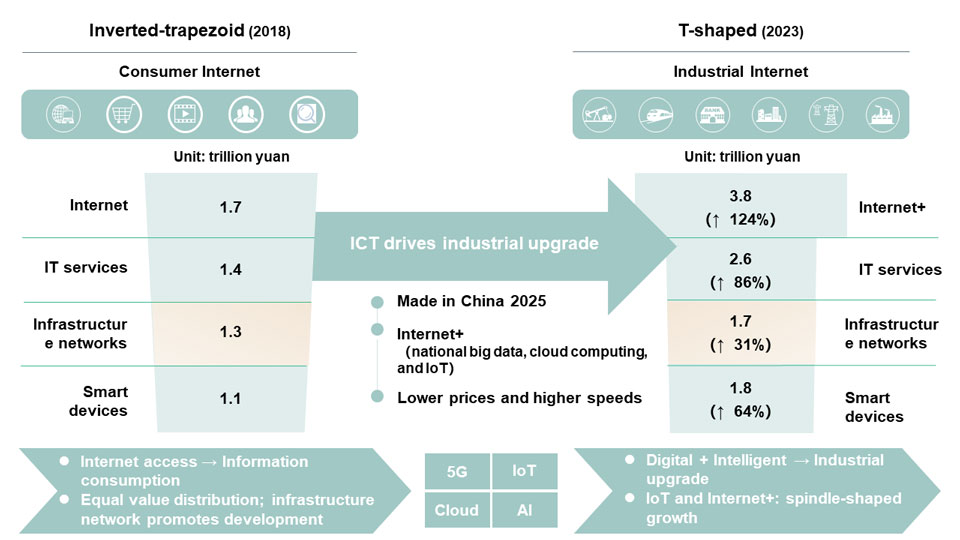
Figure 1: Industrial Internet market space analysis
In the Industrial Internet era, carriers must draw from their experience and lessons learned in the mobile Internet era. They should build optimal gigabit networks and high-quality connections, actively extend their service capabilities to vertical industry ecosystems, and develop industry solutions through open cooperation and innovation. This is the only way they can create new business models and new value in new domains. During the past decade, leaders of the information industry have entered the strategically important B2B industry. Global carriers such as AT &T, Telefonica, and Vodafone; Chinese carriers, including China Mobile, China Telecom, and China Unicom; and Internet companies like Amazon and Alibaba have chosen between the strategies of integration or being integrated. They have also forged partnerships. Some of these attempts have succeeded, some have failed.
In October 2016, Alibaba ’s Jack Ma proposed the five “new ”strategies of new retail, new finance, new manufacturing, new technology, and new energy. He hoped to make use of middle platforms to quickly integrate and break through industry markets. But, in fact, these new domains have been fed by Alibaba's core e-commerce business. This reveals the challenges facing B2B innovation. Huawei has also adjusted its B2B market strategy from integration and being integrated to establishing integrated teams. Currently, Huawei is still exploring its B2B strategy as it moves forward.
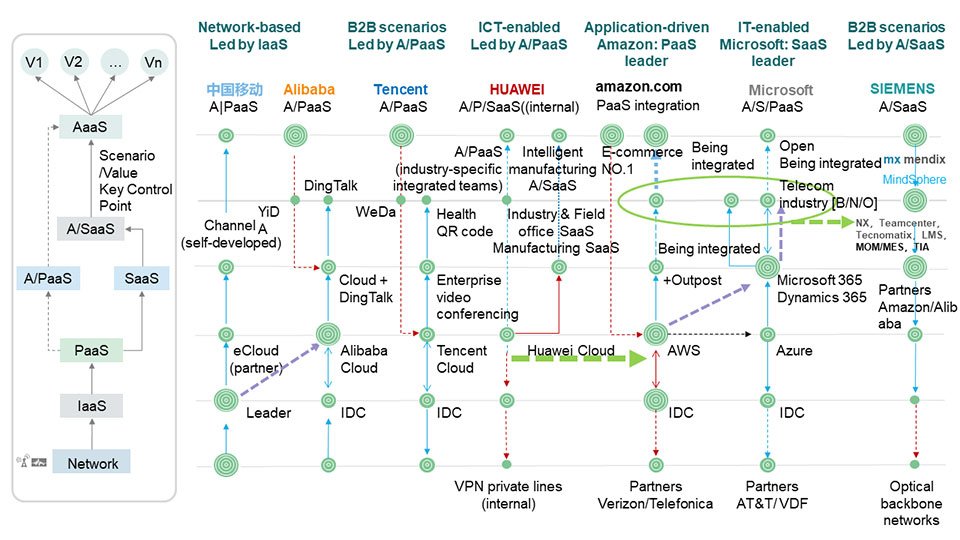
Figure 2: A/SaaS solution innovation strategy in the B2B domain
Carriers lack the ability to develop integrated solutions for core B2B markets and have not established differentiators in services. A lack of strategic control points leads to unclear profit models, making it difficult for B2B business to support sustainable development and growth.
What is a way out for carriers in the B2B market?
Four B2B market transformation and breakthrough strategies
We have proposed four B2B market transformation and breakthrough strategies by considering B2B business from a global and industry perspective. These strategies assess carriers' success in terms of business scale and profits.
Model 1: PaaS integration
E-commerce has driven the cloud innovation and iteration of AWS, allowing Amazon to lead the world in PaaS performance, efficiency, cost, security, and openness. Governments, banks, and top OTT players have all selected AWS for cloudification and digitalization. With strong capabilities in application as a service (AaaS) and SaaS, top enterprises, government agencies, and OTT players in the US have led the integration of Amazon's PaaS system. This helped streamline the industry value chain and enabled the iteration and operations of applications and services. The secret to Amazon's high profitability from PaaS lies in the aggregation and contribution of top customers, which creates a virtuous cycle for its B2B business.
Model 2: SaaS integration
While trailing Amazon in the PaaS space, Microsoft identified market demand and opportunities for SaaS, integrating Azure into its own software systems such as Windows, Dynamics 365, Office 365, and LinkedIn. This helped Microsoft become a leader in enterprise SaaS solutions and rapidly expand its enterprise market. For the industry market, Microsoft built the Power Platform based on SaaS, on which industry customers can develop applications from the top down, create new B2B solutions by integrating enterprise SaaS, and make breakthroughs in AaaS.
Model 3: Innovative A/PaaS model
Alibaba's Zhejiang e-government DingTalk team and Huawei's integrated teams leveraged their strong PaaS capabilities to enter the B2B market. They developed innovative scenario-based applications, including video surveillance, drones, and AR applications, that relied on cloud, big data, and AI PaaS platforms, creating new business models. The A/PaaS model simply connects the SaaS systems of industries rather than overhauling these systems. Due to limited value to the scenarios it supports, this model is only an innovative choice for markets that lack software autonomy, as it does not deal with core software. The A/PaaS model can be used only in limited scenarios and lacks core competitiveness.
Model 4: Innovative A/SaaS solution from inside out and top down
Siemens' intelligent manufacturing solution is an innovation driven by IoT application scenarios in the manufacturing industry. Siemens has a powerful industrial software SaaS platform and capabilities. To integrate data technologies and new IoT technologies and transition into digital and intelligent manufacturing, Siemens developed Mindsphere, an IoT application innovation platform. With Mindsphere, different IoT devices, including intelligent control robots, robotic arms, AGVs, and sensors, can be developed to build AaaS platform capabilities. Siemens also used Mindsphere to develop Mendix, a low-code IoT application development platform that helps partners develop customized applications based on factory scenarios and foster an application environment. Siemens' digital and intelligent transformation strategy is to identify and focus on high-value IoT application scenarios. Based on technology maturity assessments, Siemens focused on innovative vertical solutions, developed new commercially replicable business models, and extended applications to other industries horizontally. The scenario-driven, value-oriented strategy helped Siemens surpass GE to become a role model of digital and intelligent transformation in the Industrial Internet era.
Huawei implemented a similar digital and intelligent transformation based on its advanced manufacturing system.
These success stories suggest that the key to B2B market transformations and breakthroughs is connecting vertical ecosystems, developing new services and applications that deliver value, and building A/SaaS solutions through open iteration and innovation with ecosystem partners.
Upgrading innovation from products to solutions
Major global carriers have been working in the B2B business for more than 10 years. Carriers in China, the US, and Europe mainly provide new products and technologies, such as networks, cloud, big data, IoT, artificial intelligence, enterprise private lines, and videoconferencing, as part of their integrated solutions. This model has helped carriers achieve rapid market growth in the early stages of technology deployment. However, as this model becomes more fragmented, the industry will face challenges to turn a profit. Carriers must upgrade B2B solutions, break through the critical point of B2B market value, and go beyond connectivity to achieve profitable business at scale.
To upgrade the B2B solution strategy, carriers need to build on their IaaS strengths in networks, cloud, data, security, and localized resources, and identify strategic businesses in the B2B market. They should also predict market demand and the maturity of opportunities; seek ecosystem partners, including leaders at the AaaS, SaaS, and PaaS layers; and choose an effective cooperation model between integration and being integrated so as to connect the vertical ecosystems of I-P-S-A solutions.
If carriers are integrators, they cannot provide competitive solutions due to a lack of expertise and control over vertical industries. If carriers want to have their solutions integrated as part of their overall offerings, then no one will be integrators due to a lack of leading application and software players in China's ICT industry.
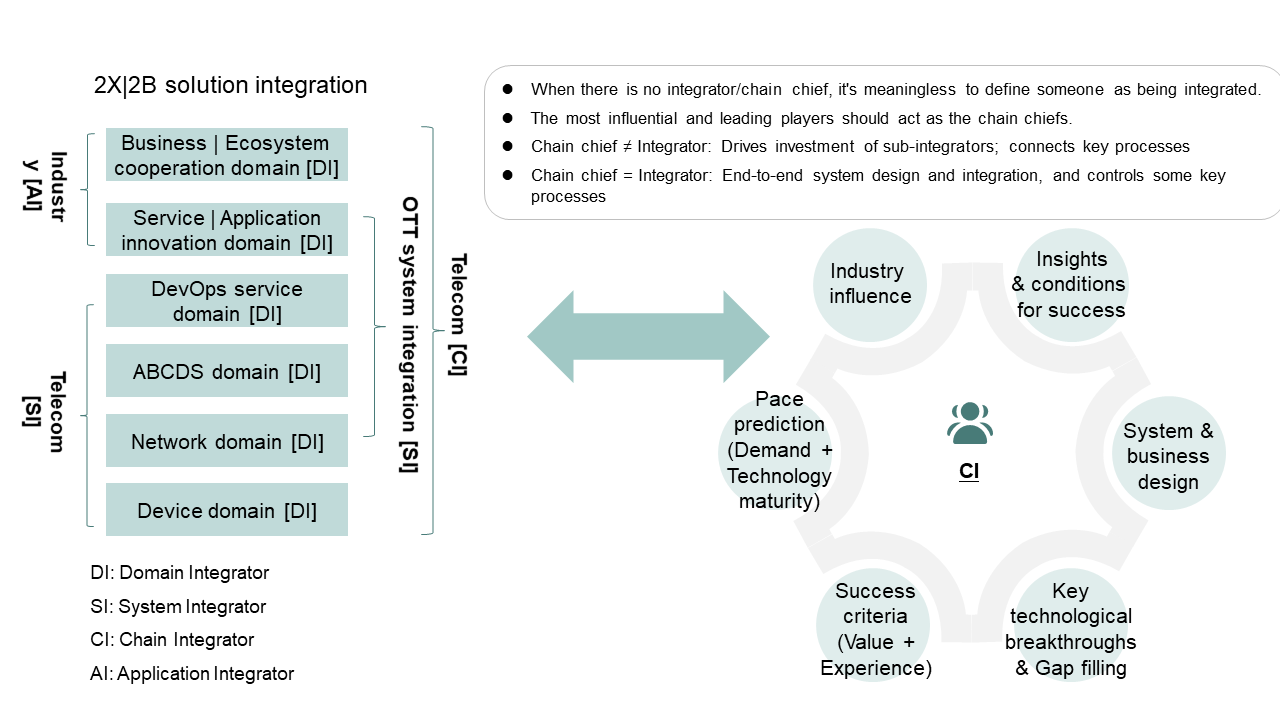
Figure 3: The "value chain chief" model enables B2B solution integration, innovation, and breakthroughs
As industry development hit new bottlenecks, the telecom industry recommended that carriers or industry leaders serve as "value chain chiefs", as the industry lacks integrators with leadership and end-to-end technical capabilities. This model will help form industry alliances to explore integration standards for solution architectures, applications, and modules. Following these standards, industry players can innovate and develop solutions on their own, with their solutions integrated to adapt to different scenarios under the leadership of the chief. This is like how different compartments of a bullet train work, as shown in Figure 3.
After breakthroughs are made, the chief can replicate end-to-end solution integration capabilities and transform into a solution integrator in the B2B industry, so as to achieve large-scale business expansion and create larger space for growth.
B2B solution innovation is a process of trial and error in different scenarios. The success of solutions should be measured by the critical point of value. The industry follows the "K-shaped" rule of value, as shown in Figure 4. The rule states that if the value of new business forms exceeds the critical point in the K-shaped model, they will have higher returns and more growth opportunities. If not, they will be rejected by the market. Carriers must select the right strategic direction and industries, and continuously iterate, optimize, and upgrade solutions to approach and even exceed the critical point of value. Carriers must possess innovation capabilities and a strong will to win.

Figure 4: Scenario-based B2B solution iteration and breakthrough of the critical point of value
Back to being value-oriented
The B2B market is essential for the telecom industry. To achieve success, the industry must generate more value for customers through innovation to optimize and upgrade previous businesses and replace them at scale.
While continuously pushing the limits of underlying technologies, carriers should carry out scenario-based, value-driven innovation, and identify key industry customers and new business requirements. They should serve as "value chain chiefs" or integrators to bring together the strongest partners along vertical ecosystems, and focus on high-value applications to develop innovative solutions that integrate devices, pipes, clouds, intelligent technologies, and security. This solution-based innovation model goes beyond the current platform-based innovation model by focusing on new applications, solutions, and platforms.
Carriers must refocus on market and customer needs, and identify strategic opportunities and the maturity of industries in different scenarios. Building on their strengths, carriers should establish cooperation models that adapt to industry development status in the vertical domain, and voluntarily act as the "value chain chief" to achieve business expansion at scale and bigger growth.


Carrier Strategies for Driving Returns from Fixed Gigabit Networks
Despite a surge in users, the penetration rate of gigabit broadband subscribers in China is less than 10%. How can carriers accelerate large-scale commercial deployment and industry growth?
1. Fixed gigabit networks: A new area of competition
In China, the penetration rate of both 100M 4G and fixed networks has exceeded 98%, indicating saturated demand. However, the penetration rate of fixed gigabit networks still has much room for improvement.
By the end of 2021, China had about 520 million fixed network users, of which less than 15 million were gigabit network users, less than 3% of the total. When the number of gigabit network users soared to 40 million, the penetration rate of gigabit networks in China was just 7%. With 5G's penetration rate now over 20%, the penetration rate of fixed gigabit networks represents a strategic breakthrough point.
China Mobile continues its leadership in 4G mobile gigabit networks. Its 5G market share exceeds 50%, much higher than other carriers. China Telecom and China Unicom have formed a defensive posture in 5G through the collaborative construction and sharing of sites.
If China Mobile works to increase its investment in fixed gigabit networks, it can secure its dominance in fixed networks. Similarly, if China Telecom and China Unicom make breakthroughs in fixed gigabit networks, they can increase their market shares, which are currently 20% to 30%, and challenge the dominance of China Mobile. The two carriers can collaborate to change the entire gigabit market landscape using the 5G market as leverage.
2. Gigabit application planning: 3 flows drive 4 use cases
To change the current market landscape through fixed gigabit networks, carriers must identify the core value-based needs of the market and customers; streamline strategic application planning; and drive solutions across the device, pipe, cloud, security, and ecosystem domains through collaborative innovation. Carriers can only make breakthroughs by first introducing products into the market, then leveraging applications to increase traffic and driving network and platform development with traffic. This will form a virtuous development cycle while ensuring closed-loop business development.
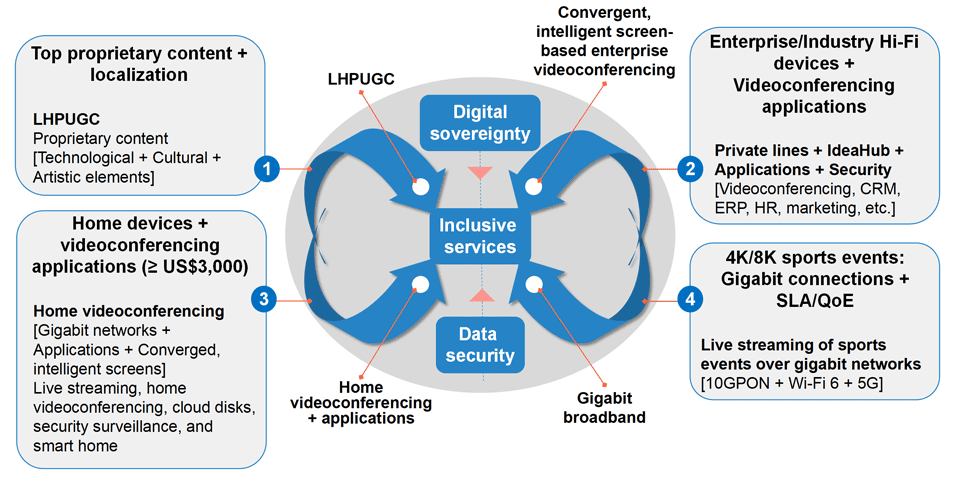
Figure 1: Four strategic use cases that drive gigabit network development
In the mobile Internet era, user flow, data flow, and capital flow are used to identify major market development opportunities and planning applications. User flow reflects the perception of value, data flow represents business stickiness, and capital flow determines growth and profitability. However, Chinese carriers, which are at the forefront of the gigabit network industry worldwide, need to gain insights into incremental users, traffic, and value in the market, and plan for the four use cases in the Chinese market:
LHPUGC new videos: Traditional video companies are making innovative videos with new technologies in response to value-based market demands. These companies are integrating technical, artistic, and cultural elements to create localized new videos with PUGC attributes.
For example, top artists integrated different elements and used XR video technologies to create "Guardian Warriors of Longmen", "Night Banquet in the Tang Dynasty", and "Pray" for Henan TV, and "The Divine Damsel of Devastation" for the game Genshin Impact. These works have put the spotlight on the rich potential of cultural history, winning critical acclaim, going viral as soon as they were released, and topping search rankings.
Convergent, intelligent enterprise communication applications: Due to the pandemic, convergent, intelligent communication services, such as online office, online education, online healthcare, and online government services, have witnessed a surge in growth.
As the pandemic continues, the market demand for videoconferencing is expanding horizontally and vertically. Horizontally, the market expects the quick and extensive adoption of such systems. Vertically, videoconferencing systems are expected to be deeply integrated with security, service quality, and internal service systems. This will make them easier to use and provide a better user experience.
Videoconferencing applications (such as WeLink) on large screens (such as the 98-inch IdeaHub) will be integrated with office systems (such as Office, CRM, and ERP) on computers, and connected to the app system on smartphones, offering a three-in-one integrated application experience with a large screen.
These applications feature security, SLAs, private lines, and E2E solutions. Their profit models are competitive and they have great potential for growth.
Intelligent home videoconferencing: In 2021, China Telecom launched gigabit visual networking, which integrates home security surveillance, gigabit video, and home videoconferencing applications to offer a new experience for high-end home users. On March 16, Huawei launched its FTTR-based All-in-One Smart Home solution to meet the needs of high-end home users for gigabit applications.
Live streaming of sports events over gigabit networks: Multi-angle, 8K/16K, AR/VR, and more new video technologies have been used to achieve breakthroughs in video solutions, boosting the growth potential of high-end commercial videoconferencing.
3. Gigabit solutions: Building experience and value-based competitiveness horizontally and vertically
To implement new business, applications, and services, carriers need to deploy a set of innovative solutions based on gigabit networks. They can build up value-based horizontal competitiveness first and then vertical.
"Horizontal" means that they should build the best network in the industry to meet the experience and value-based needs of vertical services and applications. Therefore, horizontal solutions should focus on streamlining the topology of E2E network solutions and building superior gigabit networks to meet the needs for QoE/QoS, security, reliability, service quality SLA, capacity, coverage, cost, and services.
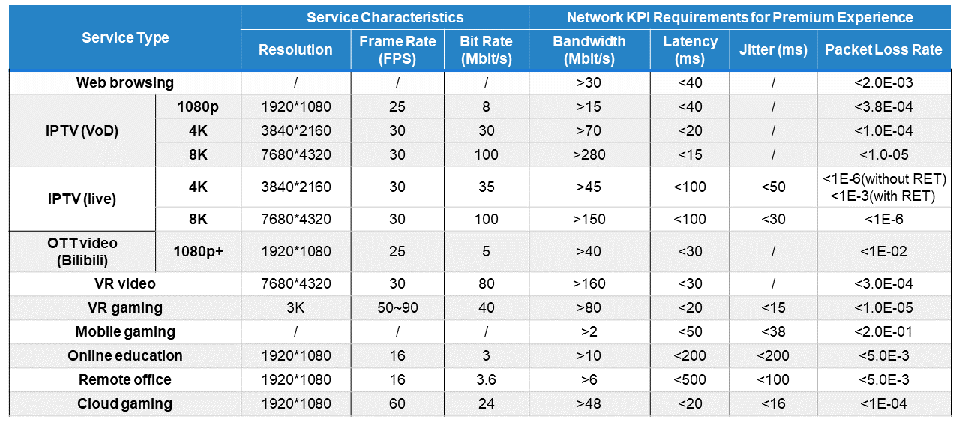
Figure 2: Technical specifications of the horizontal gigabit solutions (live network data in China in 2022)
"Vertical" refers to accurately identifying potential top applications that can drive user, traffic, and revenue growth in the four use cases, and working with or integrating application partners to achieve breakthroughs in application innovation. Currently, the core of the four major use cases is convergent, intelligent communication service applications. Devices are being integrated to achieve the convergence of large and small screens and of hardware and software.
Gigabit networks have the highest SLA and secure private line capabilities. Carriers can link the most powerful partners across devices, pipes, platforms, and applications through an ecosystem cooperation model for shared success. This aims to develop vertical solutions that are gradually iterated and optimized to meet the standards of experience and business value, and achieve sustainable user, traffic, and revenue growth.
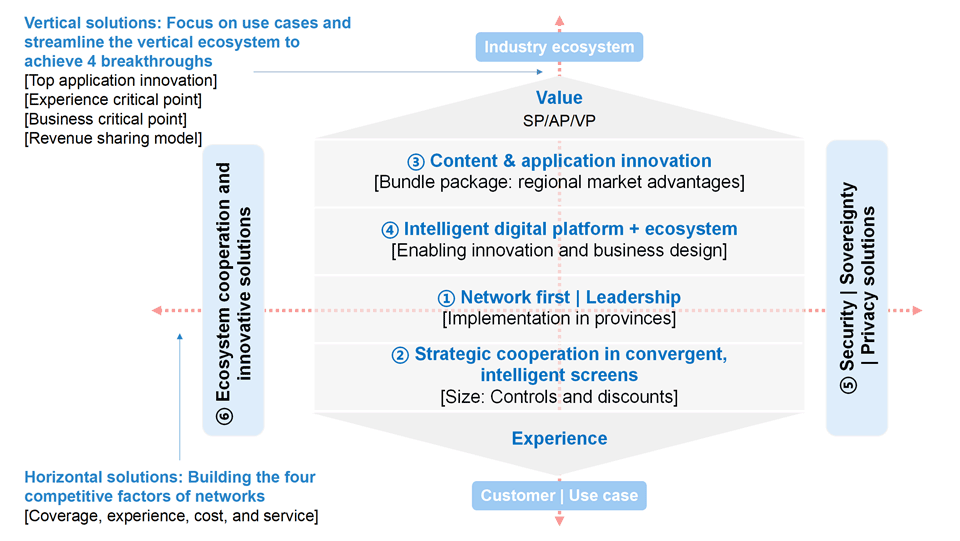
Figure 3: Horizontal and vertical gigabit solutions
4. From excellence to beyond on the second development track
In the value distribution of the ecosystem, carriers dominate connections and traffic. Therefore, gigabit network connections and traffic represent the first development track for carriers.
In the development cycle of gigabit networks and industrial Internet, new technologies are usually taken as the second development track in industry planning. For example, carriers can develop and build capabilities in new services such as cloud, big data, artificial intelligence, IoT, video, private line, and green development.
Currently, global and industry-wide transformation practices have exposed a huge gap between practical results and objectives. Therefore, we need to keep the use cases in the market and provide customers with applications and services that offer new value based on their needs. Integrating fragmented technologies and products to build solutions that enable application innovation is what customers need and want.
An intelligent digital platform based on the convergence of networks and technologies, such as cloud, big data, artificial intelligence, and security, will enable carriers to upgrade services. Carriers can monetize data through platforms and monetize information through upgrading services to achieve growth on the second development track.


Government Support for Optical Fiber Can Boost Network Transformation
When carriers are not motivated to upgrade from copper to fiber upgrades, governments need to consider three main factors to guide the way forward, boost economic development, improve living standards, and transform industry.

New infrastructure projects are critical not only to digital economic development but the national competitiveness. For fixed networks, swapping copper for fiber is both a necessary step and crucial for the transition towards green networks. For mobile networks, 5G's low latency and massive connectivity need the power provided by optical networks. However, these necessary upgrades are progressing more slowly in some countries and regions because carriers lack the motivation to swap copper for fiber. A way to resolve this is through government involvement and cross-industry collaboration.
Three factors slowing copper-to-fiber upgrades
The fixed network broadband market in most regions is expected to stay relatively static over the long term, with copper-to-fiber upgrades advancing very slowly. Carriers currently lack sufficient motivation to deploy optical networks due to three main factors.
1. A lack of strategic drivers
The natural monopoly of fixed networks has resulted in a false balance between supply and demand. Since the 1990s, the global telecommunications industry has seen an upsurge in privatization, leading to the widespread belief that Western carriers are mostly privatized. However, other than carriers in the Americas, who are mostly privatized, nearly 50% of fixed-line and integrated tier-1 carriers in Europe and the rest of the world are still controlled by government. In a market where capital is dominant, state-controlled carriers can easily dominate or monopolize the market through inherited public assets, making it difficult for other players to compete at scale. Over time, this insufficient market competition leads to inefficient organizations, indirectly weakening network deployment capabilities.
The low return on investment typically seen with optical fiber also results in a lack of priority. While transmission over optical fiber is 10 to 100 times faster than over copper lines, new optical fiber deployment requires up to five times the investment of copper and yields a broadband service revenue increase of maybe 10%. In developed countries, carriers have used pricing to encourage and attract users to subscribe to all-optical home broadband services. French carriers set the prices of fiber-to-the-home (FTTH) packages and copper-line-based x digital subscriber line (xDSL) packages at similar levels. Spanish carriers also provide FTTH-based and ADSL-based home broadband packages at similar prices. This pricing strategy offers higher speed and quality for the same price, and provides higher-quality all-optical access to enhance user loyalty and keep churn rates low. In less developed countries and some developing countries, optical fiber deployment costs are directly reflected in carriers' package prices. For example, the initial cost of Gambian carriers' FTTH packages start at US$50 per month. This makes it harder for all-optical services to ramp up in countries with low per capita GDP. Because higher speeds don't bring in more revenue, higher quality doesn't lead to more users, and the fact that returns on copper-to-fiber investement is low, optical fiber deployment is not a natural priority in emerging markets.
2. A lack of technological drivers
A generational shift in technology cannot usually be driven by technological superiority or commercial forces alone. It typically also requires government intervention to be successful. The copper line industry is now mature. However, copper lines are being squeezed out in broadband applications and investments in many countries. Because mobile networks have outperformed fixed networks in coverage and penetration and perform similarly to fixed networks in terms of speeds and experience, many users are choosing Wireless-to-the-X (WTTx) solutions instead of Fiber-to-the-X (FTTx) solutions. In addition, governments are reallocating frequency bands to increase their revenues from auction fees, which naturally results in carrier investment plans that favor mobile networks. Without large-scale planning and deployment, ROI for all-optical network deployment takes longer, and technical superiority cannot effectively drive carrier decision-makers to make investment plans for all-optical access.
3. A lack of green drivers
Current climate protection efforts mainly focus on strengthening regulations on power generation and other energy-intensive industries, while constraints on the ICT industry are still imposed on a voluntary basis. Carriers have kept a watchful eye on reducing carbon emission, but are not taking immediate action in this area because energy conservation in fixed networks is not urgently needed.
In 2022, the EU carbon price exceeded €70 per ton, while the carbon price in China reached 60 Chinese yuan (approx. US$8.95) per ton. Despite this, purchasing carbon emission allowances remains a good approach for carriers' green initiatives. Why? According to China Mobile's carbon peak and carbon-neutrality action plan, the carrier's total telecom service volume is expected to increase by 1.6 times by the end of the country's 14th Five-Year Plan, while its total expected carbon emissions will be limited to 56 million tons. In 2021, the carrier's revenue reached 848.3 billion Chinese yuan, capital expenditure (CAPEX) reached 183.6 billion, and net profits reached 116.1 billion. The cost of purchasing a large enough carbon emissions allowance to achieve carbon neutrality by 2025 would only take 1.83% of its CAPEX and 2.9% of its net profits. This expense is well within the carrier's means. Many carriers are committed to mid- and long-term energy transformations, but carbon reduction and energy conservation are not strong enough motivators to drive carriers to accelerate short-term investments or conduct large-scale copper replacement.
Three factors for consideration by governments
It is important for governments to see the strategic value of patience in this area and promote reasonably paced industry upgrades toward all-optical solutions. Governments must take into account the economic growth, social benefits, and industry development that such transformation would achieve, and increase investment to promote the deployment of fiber network infrastructure.
1. Economic growth
The digital economy is the way to the future. According to the Annual Report on China's Mobile Internet Development (2021), China's digital economy was worth 39.2 trillion Chinese yuan in 2020, accounting for 38.6% of GDP growth, with that figure growing by 9.6% annually. The digital economy is serving as a key driver of stable economic growth in China. The European Central Bank also states in the report The digital economy and the euro area that "digital adoption has increased notably since 2015", and "the Digital Economy and Society Index has risen from below 40 in 2015 to above 60 in 2020." In West European countries in particular, such as Germany, the ICT-related digital economy experienced rapid growth around 2016, faster than even real GDP growth. This increased government perceptions of the importance of the digital economy, and drove them to start planning and promoting the construction of digital infrastructure. International capital is also shifting from investment into tower construction to acquiring optical fiber assets. Many governments have also realized the importance of getting involved in digital infrastructure construction and driving capital investment.
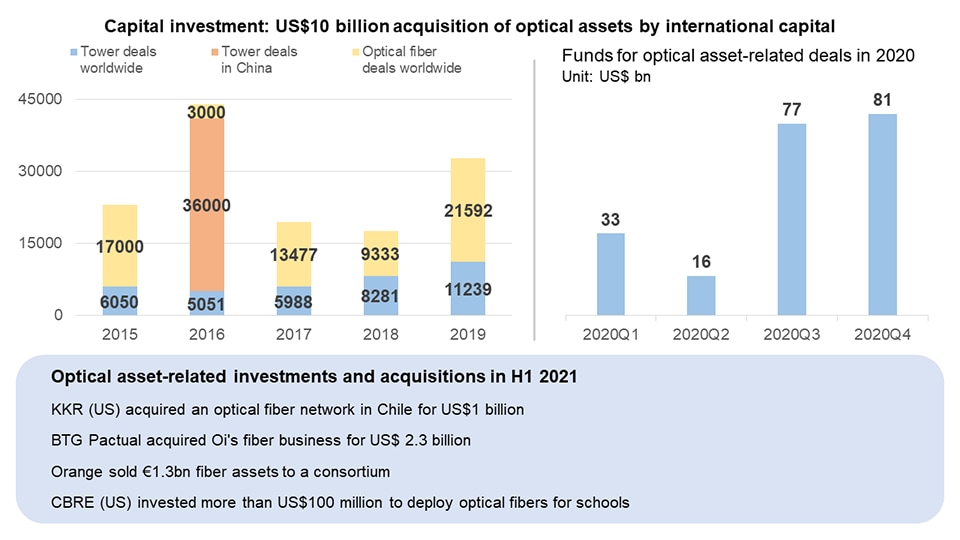
Figure 1: Capital investment: International capital's acquisition of optical assets
2. Social benefits
The pandemic has dramatically changed the way people live. Applications such as distance education, telecommuting, and cloud-based travel are acting as catalysts for the digital and green transformation of society. This means digital infrastructure is needed for a resilient modern society. An independent report released in April 2020 by Assembly Consulting Group, a consulting firm commissioned by Huawei, put forward a quantitative estimation for the UK market, "The gigabit market in the UK will drive the digital economy to grow by US$51.3 billion by 2025, enabling millions of people to work at home, which is equivalent to reducing the energy consumption and emissions of traveling 3 billion kilometers by car." This reflects the social benefit that gigabit optical networks bring in terms of not just the digital economy, but also in reducing carbon emissions.
3. Industry development
Market revitalization requires both capital and government involvement. When the former German chancellor Angela Merkel visited China in 2016, she proposed linking Germany's Industry 4.0 strategy with China's Made in China 2025 strategy. This promoted the importance of digital infrastructure, and increased government attention on the digital transformation of traditional industries and digital development of the ICT industry. Subsequently, many countries developed or accelerated the implementation of their own national ICT strategies. Individual nations across Europe and Africa, including France and Nigeria, have issued a range of national broadband deployment plans for their ICT industries to lead the way to the future. In addition, the cost of optical fibers and optical cables worldwide dropped sharply in 2019, and fiber deployment techniques, including micro-trenching, air blowing, and fiber splicing-free techniques, have become increasingly mature, which means all-optical infrastructure is becoming more popular than ever. This sharp reduction in fiber deployment costs also means that it is time for governments to get involved in the market to accelerate all-optical deployment and advance industry digitalization.
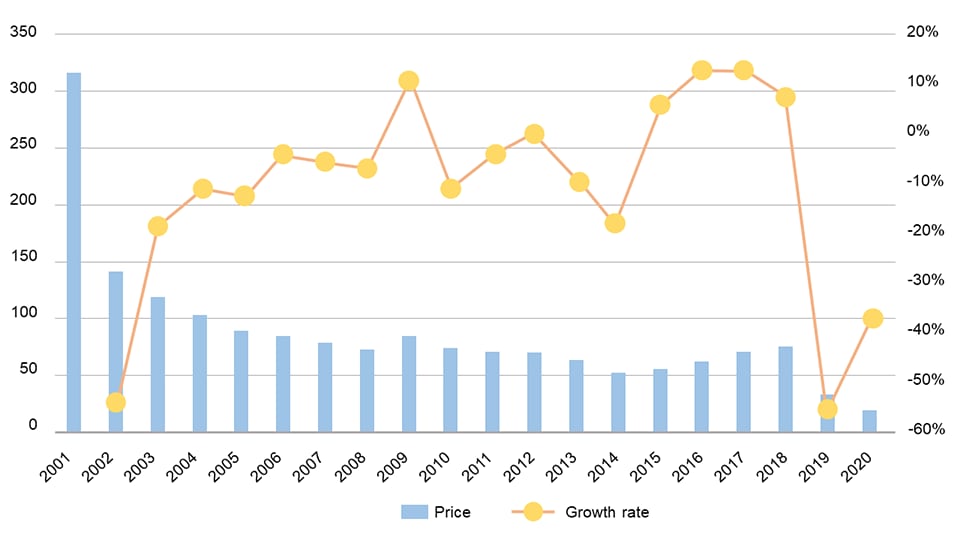
Figure 2: Changes of the optical fiber price in China (unit: CNY/core-kilometer)
We can look at how Western European countries typically use government power to accelerate all-optical deployment by turning to the example set by the UK's network development strategy. The UK launched its forward-looking broadband network deployment strategy, Building Digital UK (BDUK), in 2013. Early on, the government set a broadband rate target of 24 Mbit/s, upheld technology neutrality, and turned to copper-based, very-high-speed digital subscriber line 2 (VDSL2) technology to develop their broadband networks. However, in response to the new French government's decision to accelerate all-optical network deployment in 2017, the British government acknowledged the importance of optical fiber development by proposing the Local Full Fibre Networks Programme (LFFN) in 2018. At that time, LFFN only covered 13 pilot areas and did not promote full-scale deployment of fiber networks. In 2019, Prime Minister Boris Johnson raised an all-optical deployment proposal during his election campaign. After taking office, he and the new cabinet started planning all-optical development policies and launched Project Gigabit in March 2021. Through Project Gigabit, the government will invest £5 billion to drive private investment of £12 billion from carriers and ensure at least 85% of gigabit coverage is based on fiber access throughout the UK by 2025. It is clear that government involvement was the biggest driver of the copper-to-fiber upgrade in this case.


Monetizing RBT in the Video Era
The RBT service is a value-added service through which carriers possess a strategic control point and a native profit model. Can today's video RBT service replicate the glory of the voice RBT days?
4G changed the world. With the development of 4G networks, the evolution of scenario-based innovations for mobile Internet led to leading applications in the megabit era such as TikTok and Kwai. If video RBT can be innovative enough to deliver value and experience comparable to these apps and become a major part of the professional user-generated content (PUGC) industry, it could evolve into another killer application.
Back when China Mobile was developing its RBT services, voice RBT alone accounted for 3.4% of the carrier's total revenue, topping the global market based on user numbers and revenues in the voice era. Today, the video RBT market is gaining traction. Currently, the penetration rate of China Mobile's video RBT users is about 20% to 30%, generating an annual revenue of 7 to 8 billion Chinese yuan (US$1.046 billion to US$1.195 billion), with a high gross margin. However, it should also be noted that video RBT only accounts for 1% of China Mobile's total revenue, a ten-fold gap compared with voice RBT in the voice era. Video RBT users are mostly found in the high-end 20%, while the 20% to 80% range where most revenue is generated has yet to be tapped. This means that the video RBT market has a growth potential of twofold to fivefold.
I. From 0 to 1
Charting the trajectory of voice RBT's success can give us insights into developing video RBT today. The 0-to-1 innovative breakthrough of voice RBT was based on the following factors:
1. Strong RBT distribution platform through WIN (Wireless Intelligent Networks)
The RBT service was not proactively driven by carriers' marketing and data departments. Instead, it was an open and tentative attempt by vendors and carriers' network departments to retain independent SSP/IP as a backup to address SSP/IP termination while ensuring the stable performance of (G)MSC/SSP/IP networks. In 2001, the target WINs were upgraded and more than 1,000 (G)MSCs had SSP/IP functions integrated. The 44 overlaid independent SSPs/IPs in the live WINs faced the challenge of termination. At the same time, the network department issued a document, specifying that independent SSPs/IPs with idle service volumes should be retained, and it worked with vendors to develop four innovative solutions to continue using the equipment after the SSP/IP retention period ended. The switching and voice capabilities that resulted from the SSP/IP redundancy provided fundamental platforms and resources for the innovation of new services. IP, however, proved its maturity as a voice distribution enabling platform and laid a strong foundation for the development of RBT. Retrofitting Huawei's SSP/IP to a CRBT platform became an option, which ensured a premium experience of music RBT on mobile networks.
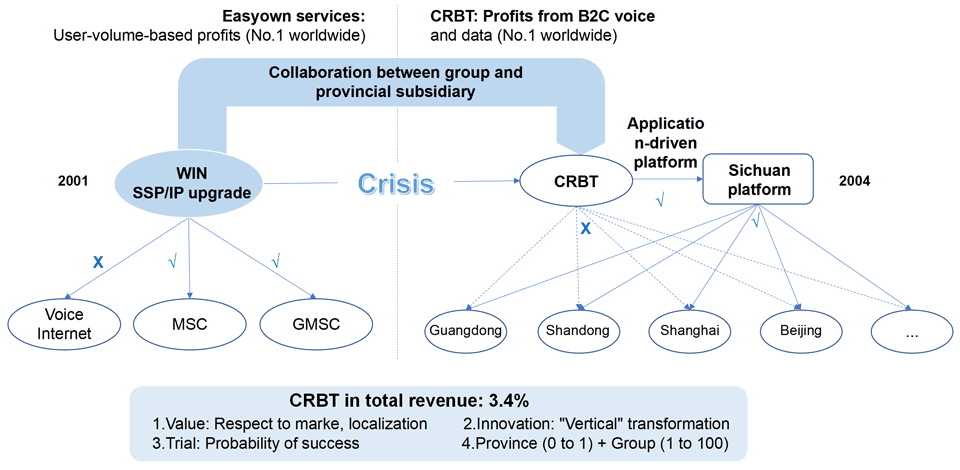
Figure 1: Voice RBT emerged as a result of wireless intelligent network development
2. Everything was ready for the launch of the RBT service
The number of China Mobile's GSM users grew from 100 million to 500 million over the decade of prosperity for the prepaid service model. This inspired carriers to discover the opportunities in the telecom industry. In addition, the prosperity of the pop music industry in the late 1990s stimulated creativity and talent in the music industry. Moreover, in the 2000s, as the cassette- and CD-based music distribution model hit a bottleneck, the industry needed to switch tracks to grow. That was when the market and technical conditions for voice RBT reached a tipping point.
3. Content breakthrough as the song "Mice Love Rice" shattered the 8 –12s value bottleneck
From March to June 2001, after China Mobile launched the RBT service, the carrier gathered a range of partners in the music industry with the aim of integrating leading tracks into the RBT DSM distribution platform. However, the market response was lukewarm. The potential of the RBT market was finally unleashed when the pop song "Mice Love Rice" received more than 6 million downloads in Sichuan, a large province of 100 million people. The song was by no means the most popular in the music market, but it fit perfectly for the 8 –12s timeframe when a caller waited for their call to be answered. The song was ideally suited for RBT and helped propel the industry into a golden period of growth.
4. Revenue sharing for entrusted charging was a development model for shared success
The emergence of RBT was an opportunity for both the telecom industry and the music industry, with the 1:9 and 2:8 profit models meeting both industries' needs for value. It was never easy for music to go Platinum through conventional channels, but popular RBT music could exceed one million downloads overnight. This drove musicians and music production companies in and outside of China to shift their focus to RBT music. As a result, the RBT business saw a boom in content innovation.
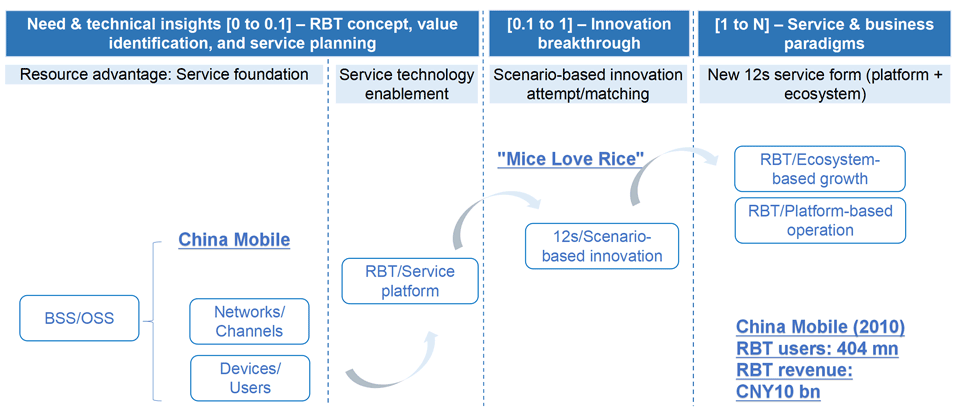
Figure 2: RBT was an example of groundbreaking solution innovation in the voice era
Reflecting on the journey of service innovation and market development of voice RBT in 2001, we can see that the development of RBT services was both fortuitous and inevitable.
2. The focal points of video RBT innovation
The development of the mobile Internet has spawned new digital lifestyles in the digital economy, accelerating the transition from voice-based services to video-based services. Netflix, TikTok, and Kwai now rank among the top platforms in multiple mobile Internet markets worldwide in terms of downloads, proportion in DOU, and proportion of user hours online. The video RBT service is a high-value niche-market video service with a readily available profit model, and is well positioned to unlock new growth potential in the long-tailed market beyond the dominance of the top video apps.
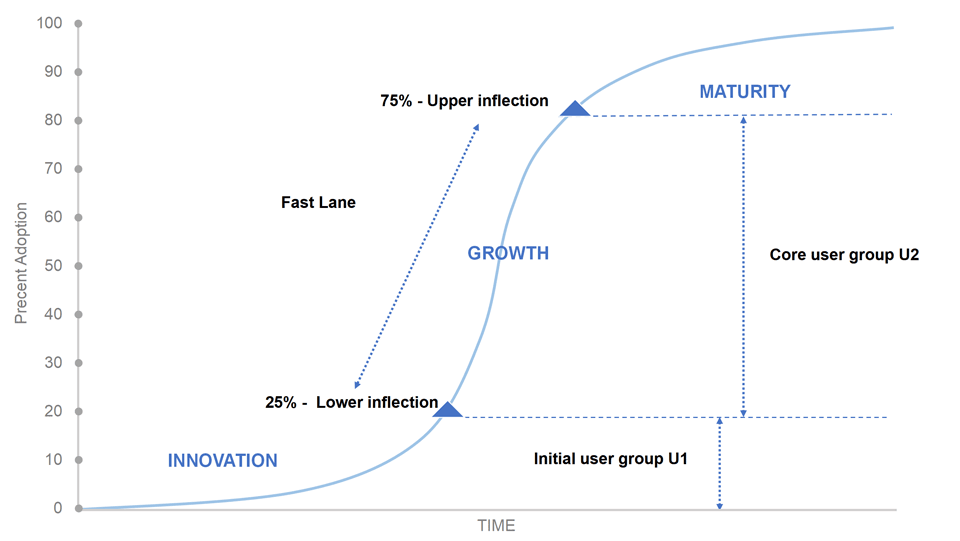
Figure 3: The 25% bottleneck is both a challenge and a leapfrog opportunity for video RBT
The S-shaped growth curve is generally applicable to any service. The current penetration rate of China Mobile's video RBT service falls within the 20 to 30% range around the lower inflection. The main challenge now is to seize the rapid growth opportunities that follow the lower inflection in the S-curve to propel the business momentum for exponential growth.
Opportunities for growth always exist, but the basic principles of making them a reality are to meet market and customer needs, and to drive user expansion and revenue growth using innovative solutions and marketing strategies.
1. Customer analysis: From the initial user group U1 to core user group U2
The top priority of innovative solutions and marketing strategies is to gain insights into customers. Initially, the early-adopter user group U1 dominates when the penetration rate is less than 25%. The next stage U2 comprises the core user group when the penetration rate is between 25% and 75%. U2 and U1 have distinct needs. U1 users are characterized by dominance, initiative, communication, exploration, creation, and dynamics, while U2 is characterized by the needs and behaviors that include following, inertia, acceptance, simplicity, enjoyment, and security. U1 consists of seed users who open up the market and proactively spread the service, whereas U2 comprises a robust ecosystem that expands the size and value of the market. U1 drives and triggers U2.
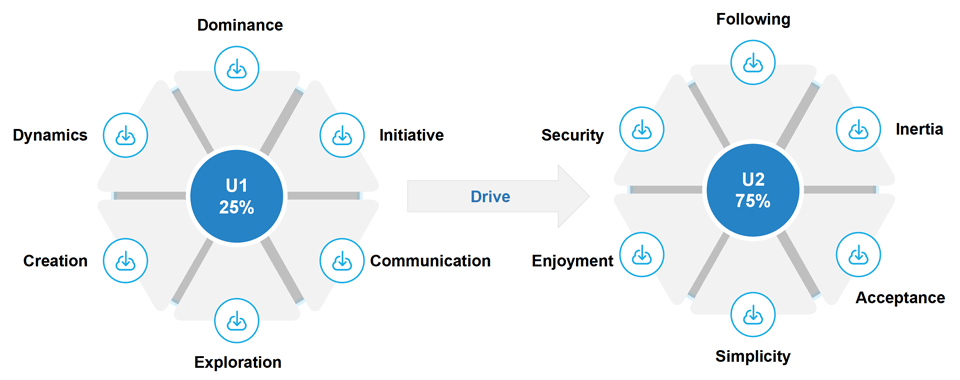
Figure 4: U1 is the seed user group, and U2 is the expanded user group. U1 drives U2
2. PUGC innovation for the 8 –12s connecting time frame
For the video RBT service, the 8 –12s connection timeframe has not changed, and users still need the RBT to be soothing without being distracting. However, video RBT should also fit the characteristics of mobile video PUGC in the same way that the leading video apps do, instantly creating joy and value for users.
3. Satisfying user experience based on data analytics
When China Mobile develops the new user group in the 25%–73% range, it will be important to classify users in the U1 group, analyze the consumption data of different types of users, and find the most popular video RBT content. Utilizing the influence of U1 on U2, the carrier can then proactively push the top content to U2 to trigger U2 subscriptions and usage. This marketing model that recommends and pushes content based on data analytics is the "killer move" behind the success of TikTok and fits the growth curve of the mobile video era.
For U2 users, a "one-click" experience is needed. For example:
- One-click content push: Carriers should take advantage of their security SMS channels and push popular content based on user classification and requirement data analytics.
- One-word impression: The SMS title and recommendation copy should be designed to be brief and impactful.
- One-click preview: Users should be able to easily preview recommended content on the SMS interface. This would ensure that the content reaches at least 80% of users.
- One-click browsing: The browsing interface should resemble TikTok and allow users to preview the top five pieces of recommended content by swiping down.
- One-click customization and replacement: One-click customization and replacement buttons should be placed on the browsing interface to allow users to subscribe to the service as they view content.
- One-click recommendation and sharing: A button should be provided on the browsing interface to enable U1 users to recommend and share content to U2 users through a simple tap.

Figure 5: Upgraded one-click video RBT solution for U1 to drive U2
Video RBT is becoming a marketing and advertising channel for enterprises and public institutions. Striking a balance between marketing needs and value to customers makes it easier to create video content that can spread across different user groups. The popular video The Divine Damsel of Devastation made for the game Genshin Impact cleverly combines Beijing Opera with multi-angle video technology and the game ’s story. The video went viral soon after its release due to its stunning artistry, helping to not just promote the game, and also generate profit itself.
New video RBT carriers can now approach the business by directly addressing U2 users. They can conduct precision marketing to develop user groups through user classification and data analytics, as well as the proactive pushing of popular content.
This will make work easier for carriers and give them a latecomer advantage.


Behind the Early Success Stories of 5G
Leading 5G operators' pragmatic quick-win approaches via traffic monetization, device upgrades, and content services.
Back in April 2019, South Korean carriers took the lead in launching 5G and achieved first-mover success. LG U+, for example, has achieved year-over-year growth in wireless service revenue for 13 consecutive quarters, reversing the downturn seen before 2018. Financial reports from the carrier reveal that its wireless service revenue increased by 14% in 2022 Q1 over 2019 Q1, shortly before 5G was commercially launched.
The Korean model is hard to replicate?
South Korea's 5G development model is often considered difficult to replicate for two main reasons.
- First, for network deployment, it appears that South Korean carriers have invested heavily in achieving quick nationwide coverage, regardless of the CAPEX spike. That is not how most carriers approach network deployment.
- Second, as South Korean carriers are part of a large conglomerate, they can operate in-house content platforms and invest substantially in original content. This is out of reach for many carriers.
Let us look at LG U+ as an example of a carrier that has adopted the “invest early ”strategy:
- Early Launch: Back in the early days of LTE, LG U+ managed to launch LTE about 6 months earlier than KT, allowing it to attract the most LTE subscribers in the first few months and increase its overall market share.
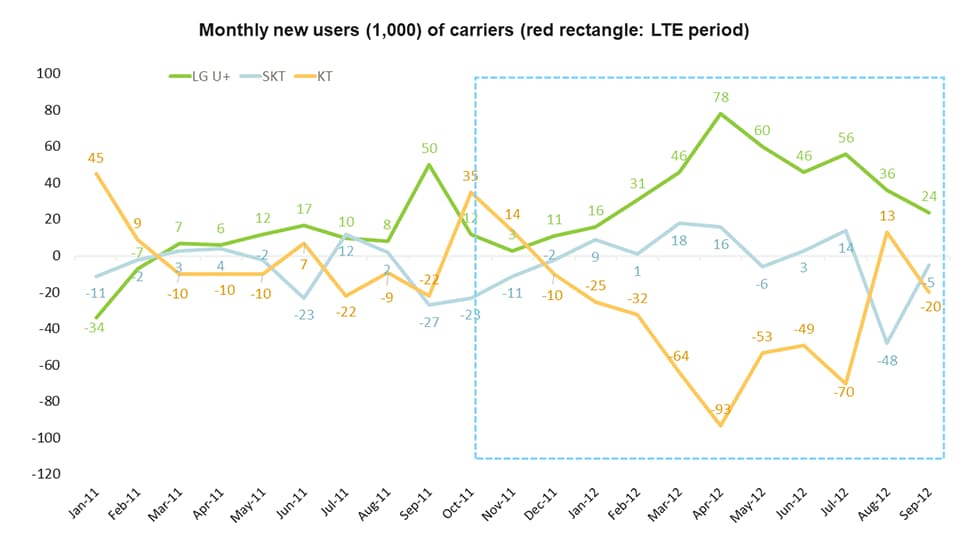
Figure 1: LG U+ took early lead in LTE launch in Q3 2011(Source: LG U+ 2012Q3 Financial Reports)
- Early Execution: As shown in Figure 2, despite LG U+'s rather high wireless CAPEX intensity (20% - 30%) in the first four years of LTE, this number dropped to 14.3% if we look at the average intensity over the LTE period from 2011 to 2018 –a modest figure compared to the global average CAPEX intensity of about 16%. With this strategy, advance investment in the first four years of LTE led to seven years of continuous growth in wireless service revenues. Since 2019, 5G has driven a new round of wireless service revenue growth.
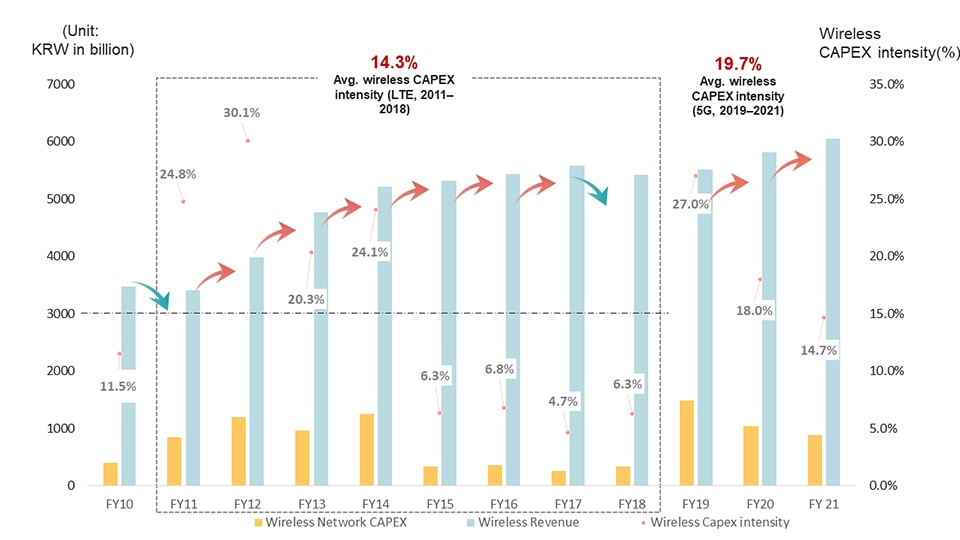
Figure 2: LG U+'s wireless CAPEX intensity and wireless service revenue over the last 10 years(Source: LG U+'s financial reports from 2010 to 2021)
Note: Wireless CAPEX intensity = Wireless CAPEX/Wireless Service Revenue
South Korea's rapid nationwide coverage also benefited from population distribution in the country. South Korea ranks 24th in the world in terms of population density, according to the World Bank, with a large proportion of the population living in Seoul Capital Area (nearly 50% of the population) and the six largest metropolitan cities. The concentrated, high-density population made it easy for carriers to quickly realize nationwide coverage.
Monetization of 5G
While massive network deployment is underway, three monetization approaches emerged that carriers can start right away:
- Traffic Monetization, as represented by Chinese carriers: 5G packages offer more data allowances at lower prices per GB for incremental ARPU. The underlying driver is the gap and room for growth between average 4G DOU (~ 10 GB) and 5G DOU (>30 GB).
- Device Upgrade, as represented by US carriers: People on average replace their phones every 3.2 years, which means that about 30% of mobile phones are replaced each year. When users replace their phones, carriers can use the opportunity to encourage them to upgrade to a 5G package.
- Content and Service, as represented by South Korean carriers: South Korean carriers use 5G services and content as one of the main drivers for 5G user migration.
Carriers often apply multiple approaches from those mentioned above. For example, carriers in South Korea use device upgrades as well, while carriers in China also invest in content and services.
1. Traffic Monetization
In most 5G markets, 5G entails a significantly higher DOU than 4G (Figure 3). The increased traffic is what 5G carriers can immediately monetize.
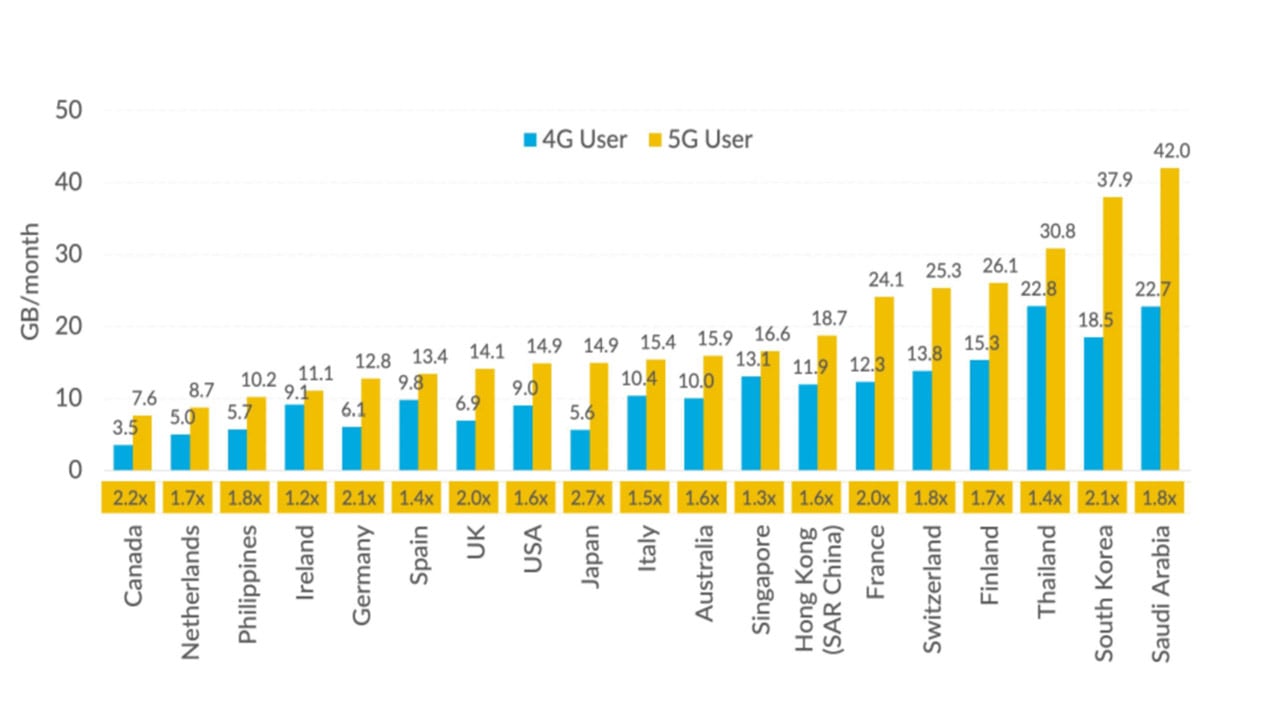
Figure 3: 5G users consume double the data of 4G users(Source: OpenSignal, June 2021)
O2 Germany, operating in a market where the average monthly mobile data usage is rather low in Europe, use 5G as the opportunity to drive up and monetize traffic (see Figure 4).
- In February 2020, the carrier introduced 5G-ready packages with prices unchanged but data allowances doubled. It also introduced speed-tiered unlimited data plans.
- In October 2020, O2 Germany commercially launched 5G, with 5G-ready packages turned 5G.
- In August 2021, the carrier expanded 5G to FREE M packages.
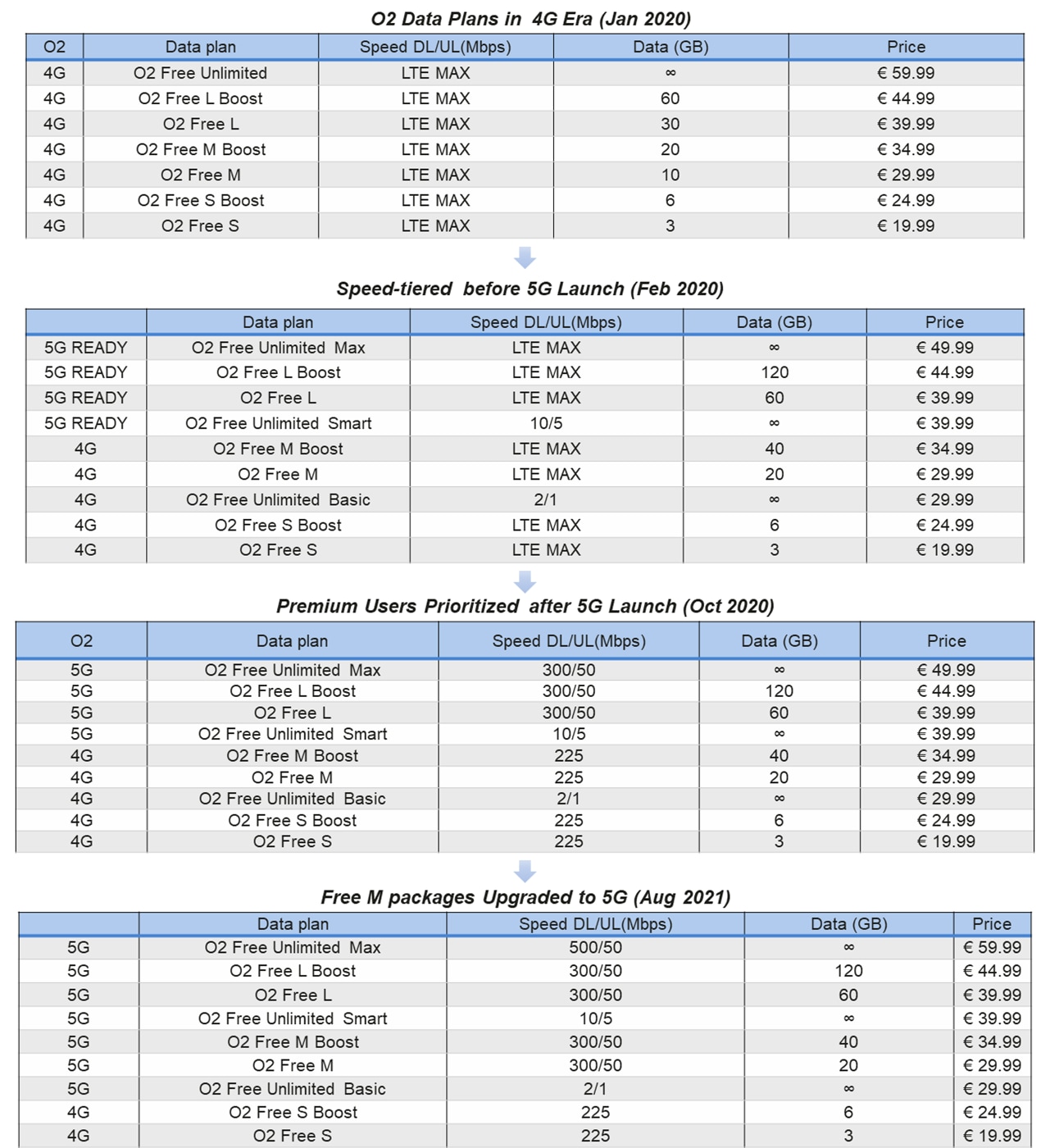
Figure 4: O2 Germany's evolving packages that drive up data traffic
In Q3 2021, monthly DOU of O2 Germany's postpaid users reached 11 GB, highest in the market, indicating preliminary success of the carrier's aim to drive up traffic.
To better support user traffic growth in the 5G era, O2 Germany executed exceptionally “investments for growth ”program, starting a virtuous cycle of traffic increase revenue increase accelerated network deployment.
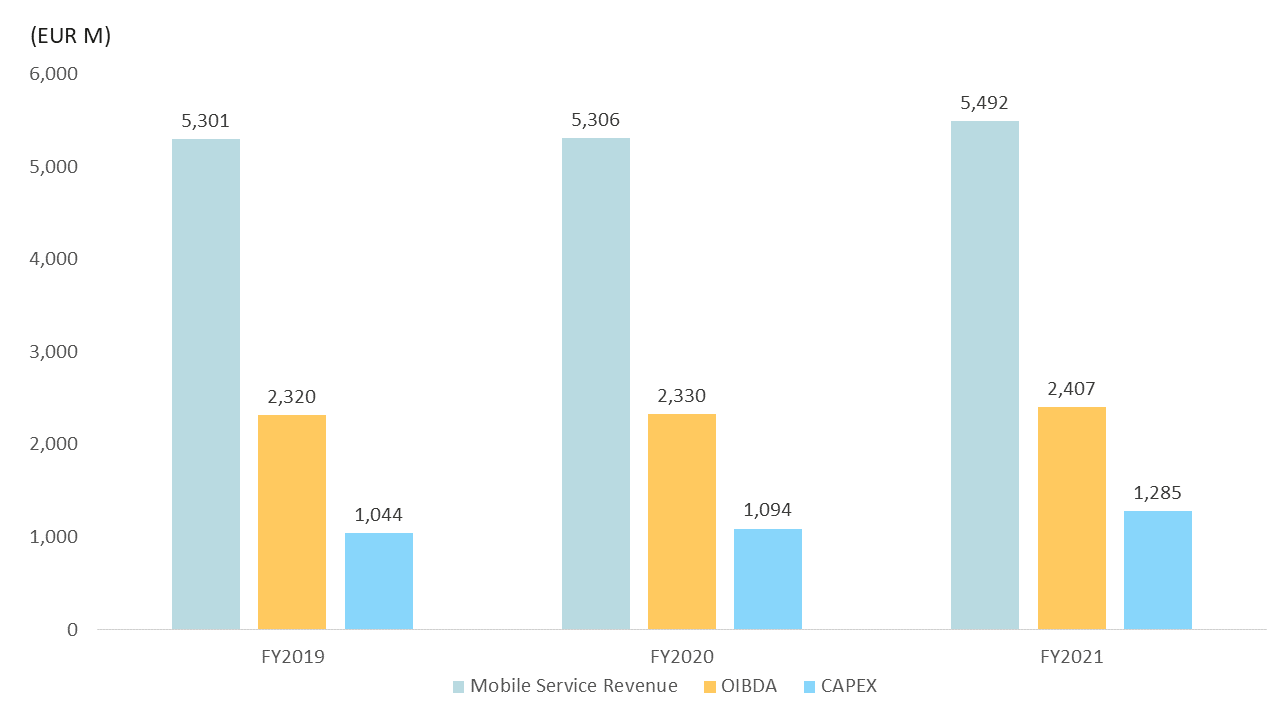
Figure 5: Growth of O2 Germany's mobile service revenue, OIBDA, and CAPEX over the past three years(Source: O2 Germany's financial report in 2019, 2020, and 2021)
Note: OIBDA (Operating Income Before Depreciation &Amortization) and CAPEX are both overall figures.
2. Device Upgrade
In November 2021, the CEO of T-Mobile US hailed the 5G smartphone as the first 5G killer app [1] , underpinned by US carriers ’dominance in smartphone distribution and the window of opportunity to tie users to higher-end 5G packages using smartphone subsidies.
AT &T, for example, offered a US$1,000 subsidy (the price of the iPhone 13 Pro) to replace many old handset models on the condition that users subscribe to its premium unlimited plan. The replace &upgrade program was largely driven by the iPhone 12's halo effect and user intention surveys.
In the US market, carriers are the main distribution channel for smartphones, with Apple occupying more than 60% of the smartphone market. Apple's first 5G phone, the iPhone 12, has powered the 5G ‘supercycle ’. In addition, new mobile phones represent the primary driving force for US Internet users to upgrade to 5G (Figure 6). Ten percent of mobile phone users replace their phones within 12 months, and 24% do within 18 months. They represent the key target early adopters for 5G migration.
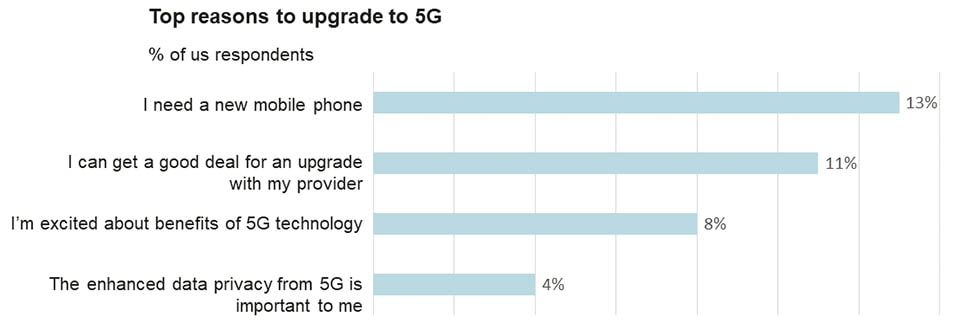
Figure 6: Top reasons of US users to upgrade to 5G(Source: YouGov, June 2021)
This wave of device upgrade has led to a rapid increase in 5G users for the three major US carriers. By the end of 2021, the total number of 5G users in the US exceeded 50 million [2] . Today, smartphone subsidization remains a common practice in many markets where carriers act as one of the major smartphone sales channels. However, it is important to note that while subsidization can be tempting, the true foundation remains the 5G network experience. This is why US carriers are striving to fill gaps by bidding for C-band and investing in C-band networks [3] .
3. Content and Services
5G offerings need to be tangible to encourage 5G user migration, and this is why 5G content and services are needed. In addition, 5G content and services help ARPU as data traffic price decreases every year.
Against the backdrop of South Korea's strategy to become major exporter of popular culture [4] , South Korean carriers have been investing heavily in and innovating content and services since the time of 4G. While running their own video platforms, they have also invested significantly in content acquisition and production. LG U+'s mobile video strategy in the 4G era, for example, was considered a great success.
US carriers used to be as ambitious in this area. AT &T acquired Time Warner and Verizon acquired AOL and Yahoo, forming Verizon Media. However, they changed course and have now fully embraced OTT services.
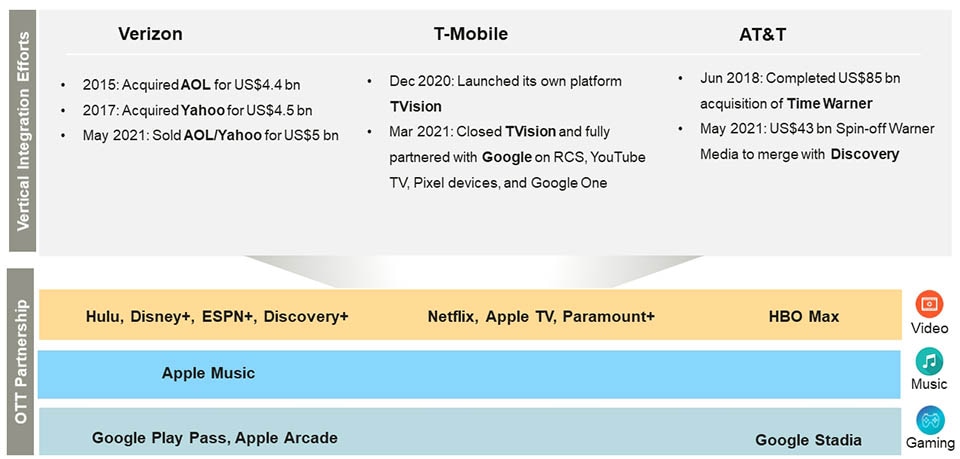
Figure 7: Vertical integration and OTT cooperation of US carriers
Clearly, own-and-run is not the only approach for carriers. Even South Korean carriers are also actively working with third-party service providers in 5G. LG U+'s cloud gaming and AR for kids ’services are based on GeForce Now from Nvidia and Bookful from Inception [5] , respectively.

Figure 8: LG U+ works with Inception/Bookful on AR for Kids services
Carriers can also adopt the white label partnership model. For example, Sunrise from Switzerland works with a partner that provides game content and cloud gaming platform (including software and hardware servers), while Sunrise itself focuses on marketing and operating. There exist a number of roads to Rome for launching 5G services: carriers can choose either the OTT partnership model (“EASY ”) or content production model (“HARD ”). Their specific choices depend on a few factors including the local market (e.g., OTT service uptake), organization and expertise (e.g., content teams), among others.
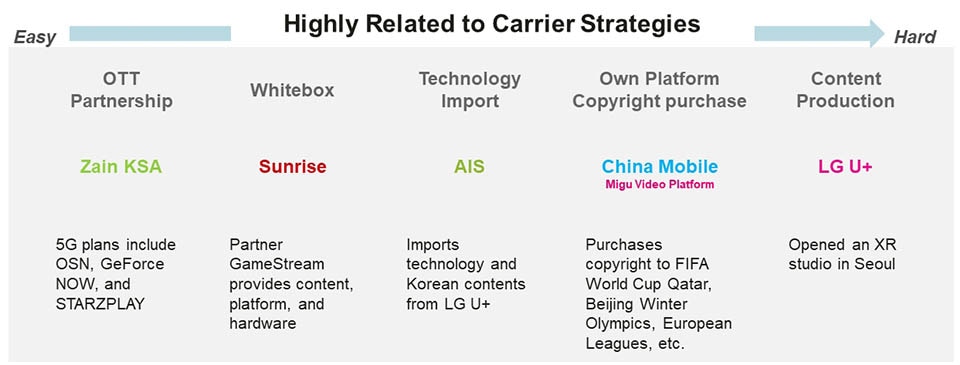
Figure 9: Different service introduction models for carriers
Key Takeaways for Operators
More than three years after the first commercial launch of 5G, leading carriers in East Asia, the Middle East, and Europe have crossed the chasm and built a considerable 5G user base (~20% 5G user penetration). Carriers' business performance indicators show that the growth of 5G users has increased ARPU, mobile service revenues, and EBITDA margins. With the accelerating global uptake of 5G, carriers can start recruiting 5G users by providing more data allowances, higher speeds and more offerings (5G content and services) without waiting for so-called 5G killer applications, so as to achieve the first wave of organic growth.
The early success stories of leading 5G carriers worldwide provide two implications for 5G business success. First, 5G network experience remains the foundation. 5G premium or upgrades would not be possible or sustainable without convincing network speeds and coverage. Second, 5G content and services are key. Carriers should choose appropriate pathways that range from low-threshold models like third-party partnerships to higher-threshold models like involvement in content production.
References
- T Mobile's Game Changing Ultra Capacity 5G Now Reaches 200 Million People Nationwide, 2021.11,https://www.t-mobile.com/news/network/t-mobiles-game-changing-ultra-capacity-5g-now-reaches-200-million-people-nationwide
- 5G Deployments Accelerate to Reach 2.6 Billion Subscriptions in, 2021.11, https://www.abiresearch.com/press/5g-deployments-accelerate-reach-26-billion-subscriptions-2026/
- Wireless Carriers Are Winning 5G Customers for the Wrong Reason, 2021.10, https://www.wsj.com/articles/wireless-carriers-are-winning-5g-customers-for-the-wrong-reason-11634837502
- From BTS to 'Squid Game': How South Korea Became a Cultural Juggernaut, Nov 2021, https://www.nytimes.com/2021/11/03/world/asia/squid-game-korea-bts.html
- Inception XR launches Augmented Reality Kids library service in partnership with LG U+, https://inceptionxr.com/case-study/lg-u-bookful-partnership/


Unlock New Business Value with 5G
How can carriers access the vast 5GtoB market and keep pace with market evolution?
After large-scale 5G deployment began globally in 2019, more than 2 million 5G base stations had been deployed by the end of 2021 marking the time when 5G had entered commercial use at scale.
China has installed 1.42 million 5G base stations, accounting for 60% of the world's total, and launched more than 10,000 5GtoB application projects that are already creating business value. The nation is now positioned as a global leader in 5G and continues to make breakthroughs.
The development of the ICT industry is driven by both market demand and technological innovation. As the industrial Internet becomes mainstream, national strategies, especially those of China and the US, are becoming the primary driver of 5G deployment. China has outlined a 5G blueprint with advanced infrastructure, aiming to drive social and industrial transformation and complete intelligent digital transformation through 5G. With policy now serving as the biggest driver of industrial progress and evolution, how can carriers coordinate national and industry strategies, create new business models for industries, and realize business value?
Insight: Five waves of digital evolution and trends
Looking back at evolution in the 4G-based mobile Internet era, the mainstream services that dominated the market during the first and second waves of digitalization were clear to see. The first wave revolved around 4G-based lifestyle portals and the second on mobile short-video applications. Given the evolution of major mobile Internet services, it is essential that the development of the 5G industry runs parallel with applications and devices in vertical ecosystems. The key control points are customer experience and high-value applications, as shown in Figure 1.
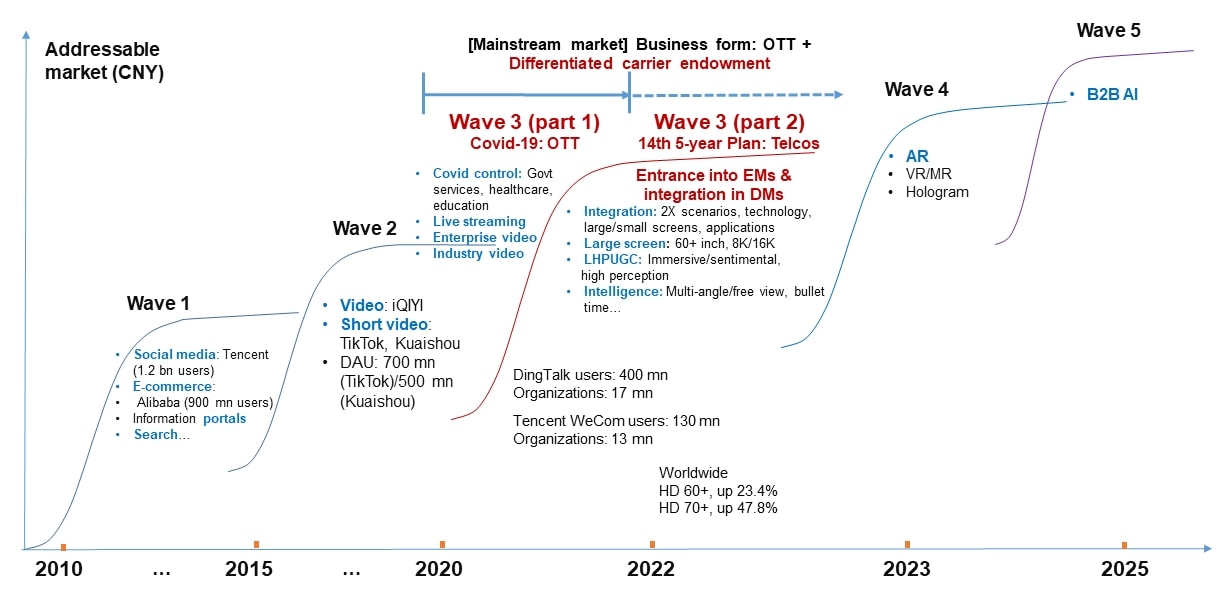
Figure 1: 5GtoB,business value
In the third wave of digitalization, the 4G + short video model coupled with the pandemic spurred live video streaming and converged fixed-network video services, like Zoom, DingTalk, and WeLink, to gradually mature and become widely adopted. In turn, converged video is a booming mainstream application of 5G that is driving the development of the gigabit 5G market.
AR/VR applications and device innovations in markets such as the US, Japan, South Korea, and China, are seeing rapid breakthroughs that are shaping the fourth wave of digitalization. The large-scale commercial use of AR/VR is expected to reach a tipping point in the next two to three years. High-order 5GtoB application innovations are maturing through iteration, and are expected to reach a tipping point of value creation within three to five years, which will shape the fifth wave of digitalization.
Current mainstream markets are still going through the third wave of digitalization (the large-scale commercial use of convergent video services), which is seeing two main trends in the global market: (1) Digitalization is making its way to emerging markets (EMs), (2) Digitalization is being deeply integrated with enterprise/industry services in developed markets (DMs).
Carriers can achieve rapid growth only by identifying and gaining insights into mainstream markets and accelerating application-driven and scenario-oriented transformation.
Four high-value scenarios drive commercial 5G for industries
Today, typical examples of 5G business value can be seen in all major markets worldwide.
- China shows outstanding performance in both monetizing 5GtoC traffic and innovating 5GtoB business models.
- Europe and the Middle East have formed a virtuous business cycle in developing fixed wireless access (FWA) services.
- South Korea and Japan have made innovation breakthroughs in AR/VR applications.
- Europe and the US have facilitated single-point industrial Internet applications and solutions.
These success stories are driving the adoption of commercial 5G by industries (Figure 2).
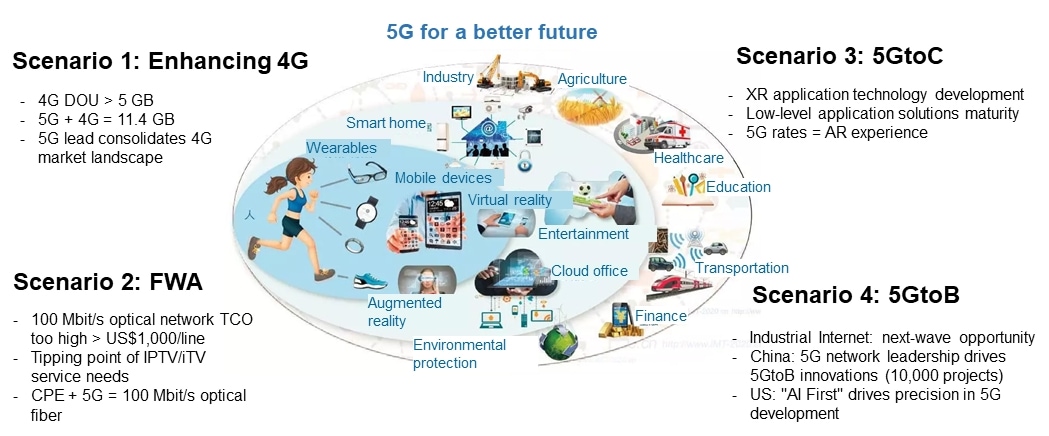
Figure 2: Four high-value 5G business scenarios
High-value business scenario 1: Collaboration between 4G and 5G consolidates and improves the 4G market landscape. In the Chinese market, 5G has surpassed 4G to become the dominant telecom service in the mobile Internet era, which has profoundly impacted the existing 4G market landscape. 5G is also driving the upgrade of the mobile Internet monetization model, shifting it from user-volume-based to traffic-based. In China, there are 1,425,000 5G base stations and 5,820,000 4G base stations, and the traffic generated by 5G accounts for more than 20% of the total (Figure 3). The pandemic has spurred convergent video services, such as live streaming and enterprise videoconferencing, to rapidly mature and grow in industries like education, healthcare, and government services. 5G's dataflow of usage (DOU) in China quickly surpassed 4G's best-experience DOU (5 GB), reaching 11.7 GB in December 2021.
A combination of 5G and 4G maintains or enhances the optimal network experience. When network resources are fully utilized, the technical and traffic throughput capabilities of the 5G network will ensure a 50-GB best-experience DOU, a tenfold DOU increase from 4G that is in line with generational evolution. Coordination between 5G and 4G is changing the baseline of competition in the mobile Internet market, and 5G is already reshaping the market landscape for carriers in terms of mobile Internet services. Simply put, whoever has a stronger 5G network will gain a larger user market.
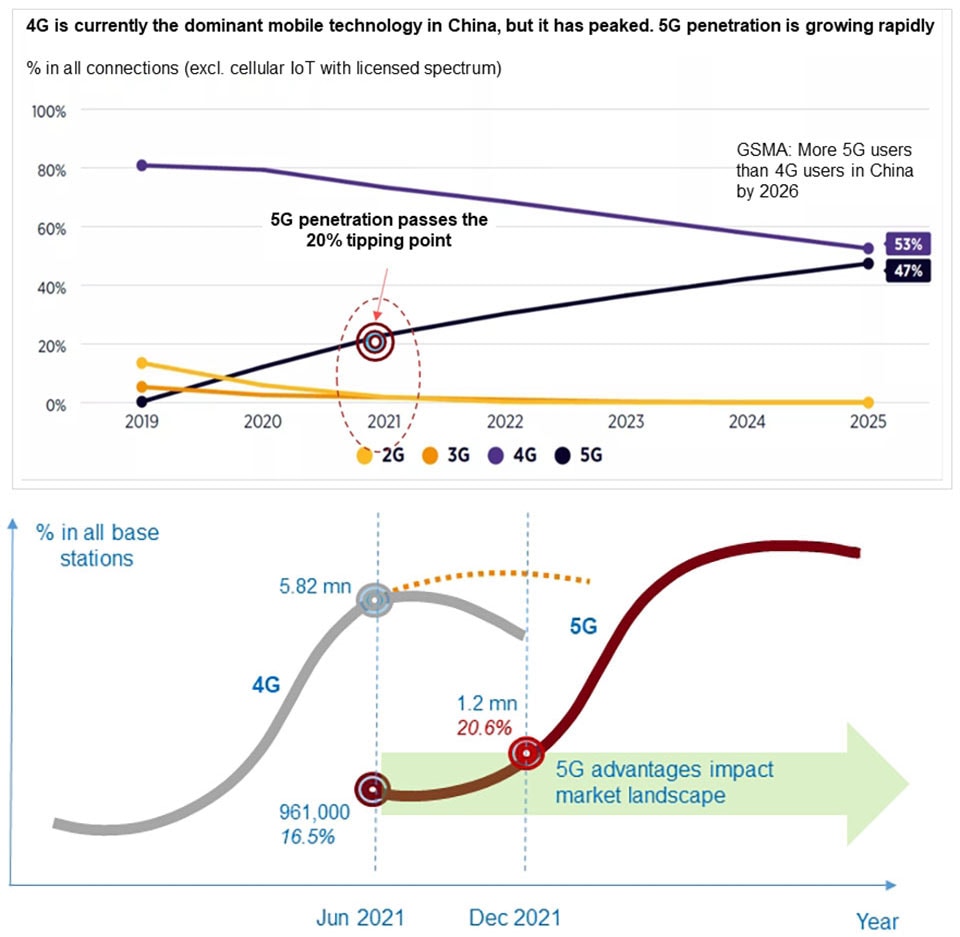
Figure 3: 5G starts to change the market landscape from the 20% tipping point
High-value business scenario 2: Developing FWA to replace 100 Mbit/s fixed networks. 5G is replacing fixed optical network access in application scenarios both inside and outside China, such as 4K/8K live streaming, which is becoming another key application of 5G as it realizes its business value (Figure 4). In remote regions of the Middle East, Latin America, North America, and Europe, where optical fibers cannot be deployed, the 5G-based FWA solution is replacing fixed access. This solution features fast deployment and low cost, increasing market penetration and rapidly improving the landscape of the fixed-mobile convergence (FMC) market. The current 100 Mbit/s rate satisfies user-experience requirements of major home services like HD large-screen video and gaming, and carriers like STC and Zain in Saudi Arabia and Sunrise in Europe are providing such services.
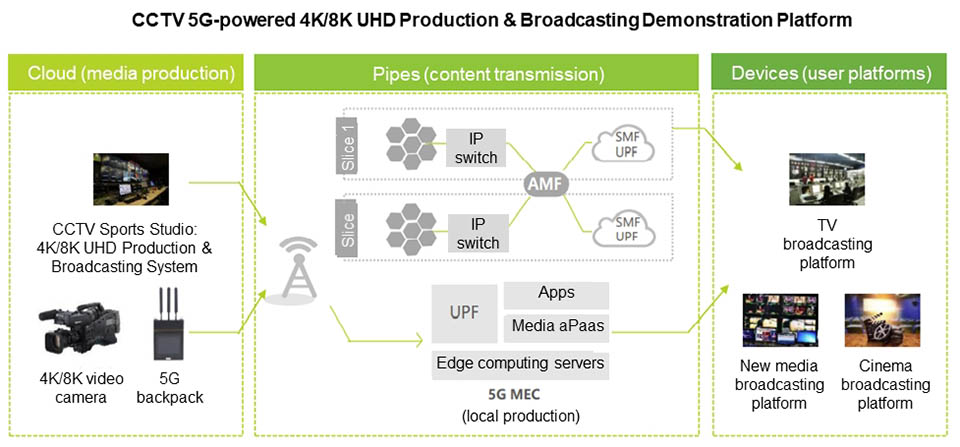
Figure 4: 4K/8K live streaming application supported by the 5G FWA solution
High-value business scenario 3: AR/VR as typical 5GtoC applications. The development of 5G in South Korea is taking on new features. Leveraging 5G's high speed and low latency, and working with the country's world-leading AR/VR industry, South Korean carriers like LG U+ have created innovative 5G-based AR/VR applications and put them into commercial use at scale. AR/VR applications have helped increase the DOU to 30 GB and the average revenue per user (ARPU) by 37%, creating a genuine 5GtoC application market.
High-value business scenario 4: Innovative 5GtoB applications and solutions are making major breakthroughs in the industrial Internet. Carriers such as China Mobile and technology companies, such as Huawei, Alibaba, and Tencent, have all participated in 5GtoB innovation: In 2021, more than 10,000 5GtoB innovation projects were underway in China, indicating a vibrant market. Preliminary solutions, new forms of business, and new applications of 5G are now taking shape in industries such as ports, mining, iron and steel, and power grids. The core forms of 5G business for many projects are maturing and emerging as world-leading, shaping an ecosystem of innovation.
Among the aforementioned four high-value business scenarios, scenarios 1 and 2 are a continuation of the 100 Mbit/s pipe model, which is limited as the growth of the world's population and connections are approaching a bottleneck. Therefore, a major breakthrough in realizing the value of 5G can be made by leveraging the unique features of 5GtoB to develop ecosystem-based vertical solutions, break the limits of vertical growth, and develop a new growth model based on intelligent digital platforms.
5GtoB unlocks the blue-ocean vertical market
In 2021, the fourth wave of strategic digital transformation represented by AR and VR attracted the attention of the industry and gained massive investment from the capital market. The involvement of Meta and Microsoft in this market stimulated an upsurge in the 5GtoC industry. The majority of new players worked to develop hardware and software technology solutions spanning devices, networks, platforms, and ecosystems for new applications. In 2022, the industry's enthusiasm for AR/VR leveled out, guided by a general realization that another two or three years were needed for the hardware and software to mature before reaching the tipping point (e.g., visual immersion) of user experience, and for the true value of the market to be realized.
As a result, the focus of vertical market growth has returned to 5GtoB scenarios. Some of these scenarios have higher and more complex technological requirements, which simply cannot be addressed by existing technologies. However, opportunities for breakthroughs in 5GtoB lie in the fact that many industries in China still need low- and medium-level solutions based on simple technologies for simpler scenarios. This is supported by the case of mobile payments seen in the mobile Internet era, where China was able to surpass the US in the use of mobile Internet technology.
Breakthroughs in vertical solutions must start from low- and medium-level scenarios, integrate connectivity technologies such as 100M, 5G, and gigabit optical networks, and then integrate AI, big data, cloud, security, IoT, and vertical technologies (ABCSIV). The aim of these efforts is to develop applications that deliver experiences similar to those provided by smartphone operating systems and apps, meaning the development of vertical solutions that run throughout technology chains (Figure 5).
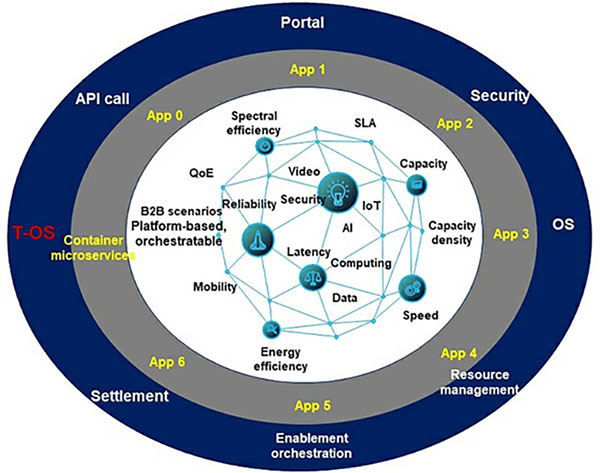
Figure 5: 5GtoB solution innovation
Breakthroughs in vertical solutions will help carriers find their place in terms of value within a new blue ocean, transcending the user-volume-based and DOU-growth-based monetization models. Gaining solution capabilities will help carriers build leadership in intelligent digital platforms and then use these platforms to shape new PaaS- and SaaS-based profit models. Such models are essentially data-based monetization models, as the core capabilities of the platforms lie in data technologies (DTs) like cloud, big data, artificial intelligence, and security. Application innovation based on platform-enabled ecosystems will allow carriers to share revenue from intelligent digital applications for verticals, which can be seen as information-based monetization.
The digital intelligent transformation of carriers focuses on innovating vertical solutions and digital transformation underpinned by digital transformation during the development of the new industrial Internet. This should be undertaken while carriers consolidate traditional networks, connectivity services, and profit models.
Carriers should develop four new monetization methods (Figure 6).
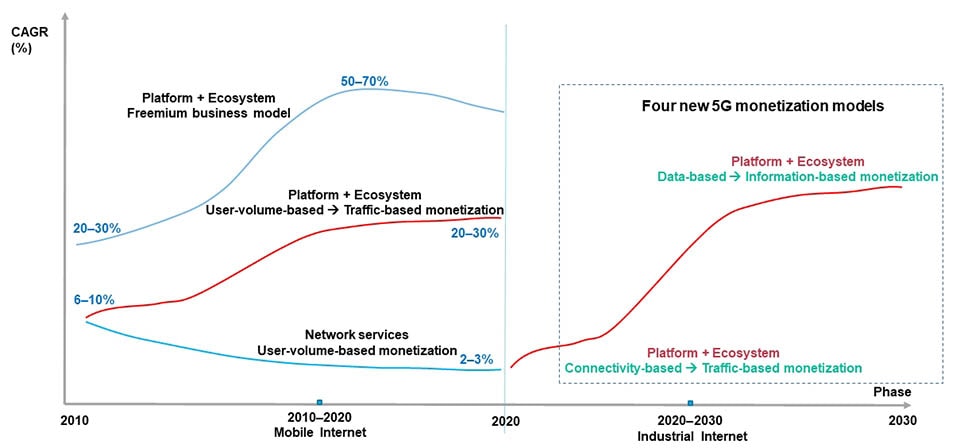
Figure 6: New business value of 5GtoB: Four innovative monetization models
Developing intelligent digital platforms and new "3-4-3" profit models
At the initial stages of 5G development, 5G's business value is mainly reflected in the monetization model, which is based on mobile Internet traffic. This means 5G collaborates with 4G to improve DOU and leverages video content (the third wave of digitalization) to overcome the "dumb pipe" dilemma, increasing ARPU through DOU growth. Another way of increasing 5G ARPU is the development of private line services through the integration of 5G with cloud and security capabilities.
If we look at trends in the value of 5G for industries, innovative breakthroughs in intelligent digital capabilities and services for verticals are the true blue ocean for realizing 5G ’s value. Carriers can first build vertical solutions for the B2B market and then develop intelligent digital platform capabilities. This means upgrading the intelligent capabilities of each module of the digital platform to improve their competitiveness, thereby achieving 20% to 30% revenue growth. Through the foreseeable evolution of 5G value realization, a platform-dominated "3-4-3" profit model architecture that goes beyond connectivity is sure to emerge. In the "3-4-3" model, connectivity accounts for 30% of total revenue, platform services for 40%, and information-based service revenue sharing for 30%.
The development of 5G is now maturing and the business value of 5G is gradually increasing. Traffic-based monetization seen in the initial stages of 5G development is a new growth model based on collaboration with 4G. The most important aspect for carriers is to develop new growth models driven by innovative breakthroughs in solutions and intelligent digital platforms for the B2B market.
Carriers should go beyond networks and connectivity to pursue growth through data- and information-based monetization in the new blue ocean.


Telecom Transformation Based On "U2.0" Theory
The development of the global telecom market has been historically unbalanced. So, what can current trends tell us about tomorrow's development opportunities?
In 2010, Huawei analyzed the dynamics of emerging markets (EMs), developed markets (DMs), and super-developed markets (SMs) in the global telecom industry. Our research delivered insights into the U-shaped evolution of the industry —insights that have supported the continued transformation and growth of our customers and partners over the past decade. As the industry approaches another U-shaped evolution cycle, will U2.0 have a strategic impact on the industry?
U1.0 evolution: From monetizing voice to monetizing data
Looking back at the history of the telecom industry, voice services peaked in 2010. Although 3G had already started reshaping the entire ICT ecosystem thanks to innovation by Apple, voice services still accounted for more than 70% of the industry's total revenue.
A typical telecom trend analysis at that time would have told the industry to continue to enjoying the benefits of the current voice-based monetization model. However, a potential industry surge brought crisis and disruption to traditional leaders. By analyzing carriers' strategies and pain points, Huawei proposed the "U theory", which depicts industry development dynamics and future trends along two axes: X representing the market and Y representing revenue and profit growth rates.
In 2010, EMs kept generating profits through the volume of voice service users, and leading carriers were experiencing peak revenue and profit growth based on increasing minutes of usage (MOU) each month.
Leading carriers in SMs, such as the US, Japan, and South Korea, started adapting to the emerging mobile Internet concept spearheaded by Apple, moving towards the new "mobile-first" era of 4G. They were also able to rapidly expand their new user bases by developing mobile Internet services. And they increased dataflow of usage (DOU) and ARPU, leading to growth in both revenues and profits.
As leaders in the voice era, carriers in European DMs, such as Vodafone, Orange, Deutsche Telekom, Telefonica, and BT, had all passed the sweet spot of voice services and began to stagnate. Due to a lack of leading Internet companies and smart device companies in the industry ecosystem that could act as guides, the development of mobile Internet services was slow and innovation was lacking. Up-front 3G investment resulted in huge debt burdens for carriers, limiting investment capabilities. The need to address both voice and data services in operations rapidly drove up costs, causing negative revenue and profit growth.
These factors resulted in the U-shaped evolution of the global telecom industry, with EMs on the left, DMs bottom center, and SMs on the right (Figure 1).
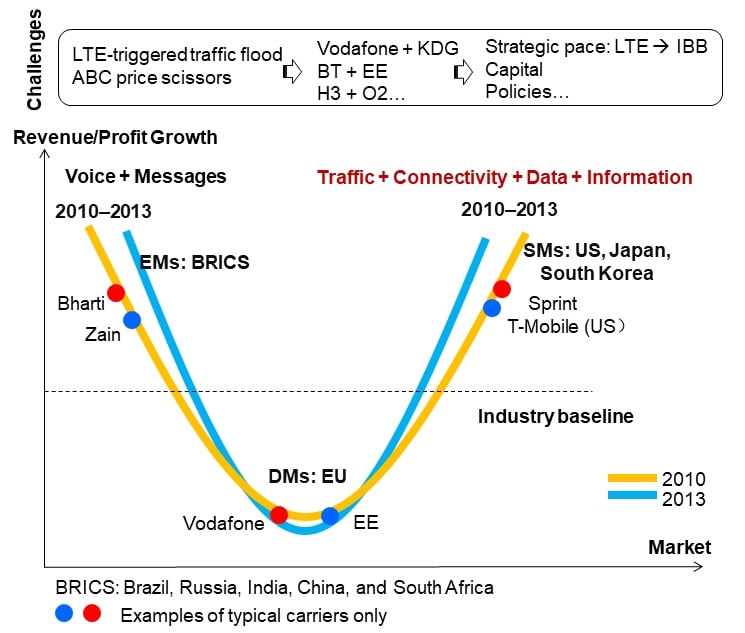
Figure 1: U1.0: From voice-based monetization in EMs to data-based monetization in SMs
Through U1.0, Huawei was able to gain insights into a major upward trend in the industry —the transition from voice dominance to mobile Internet. Through that transition, industry services, support, experiences, and business models all fundamentally changed and tremendous opportunities opened up. At that time, it was crucial for carriers to accurately transform towards the mobile Internet.
U2.0 evolution: From Mobile Internet to Industrial Internet
Currently, the industry is experiencing a new round of transformation, shifting from B2C and B2H scenarios to B2X and B2B scenarios. Leading US Internet companies (Figure 2) have evolved their strategies from "mobile first" to "AI first", and the industry is already expanding from mobile Internet to industrial Internet. Industry trends and the types of competition are undergoing dramatic changes, with revenue growth in the global telecom industry already showing signs of U2.0 evolution (Figure 3).
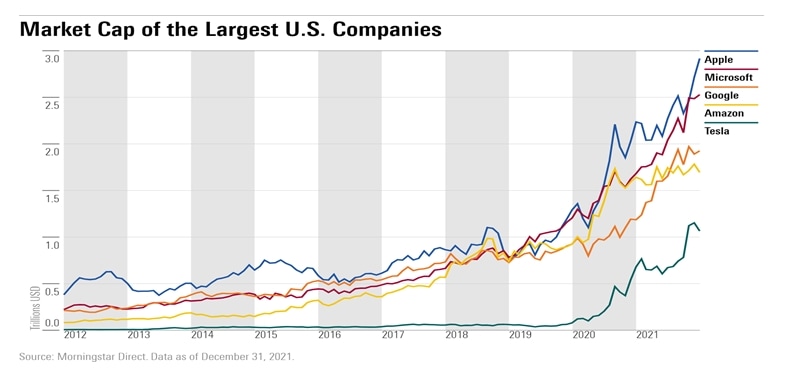
Figure 2: OTT vendors grew faster than the telecom industry over the past decade
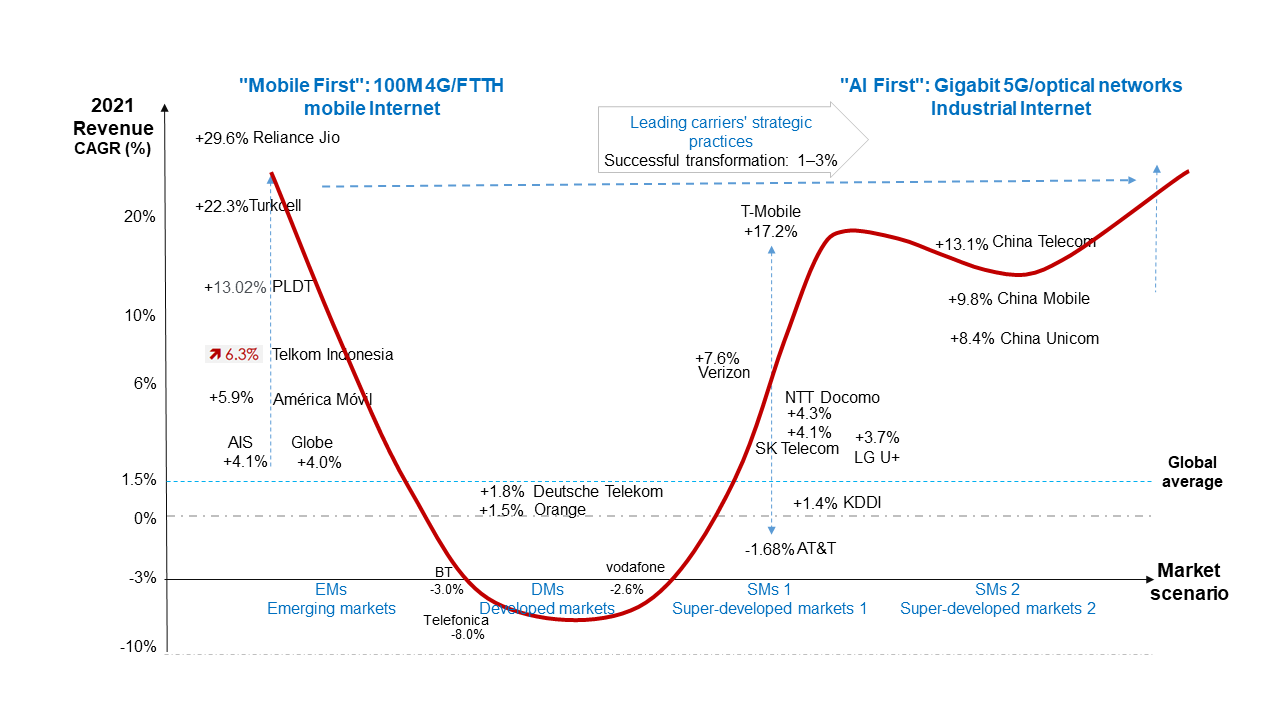
Figure 3: U2.0: From the mobile Internet to industrial Internet
The monetization model used by EMs has evolved from voice user volume in the U1.0 era to data user volume in the mobile Internet era, with major carriers already seeing new revenue growth. Carriers that have completed digital transformation now have differentiated competitiveness through digital platforms, enabling them to innovate digital services and integrate traffic and digital service applications. Armed with such competitiveness, they can avoid homogeneous competition for user traffic, significantly improving both DOU and ARPU through traffic-based monetization. Market results show that the profit model based on user volume can support 4%-10% growth, while a model that also monetizes traffic can drive growth up to 20%-30%. Leadership in digital platforms and ecosystems can help carriers lead in market capitalization, with the Indian carrier Reliance Jio providing a great example.
Europe hit rock bottom during the mobile Internet era and is still failing to develop the innovative capabilities needed to make breakthroughs in the industrial Internet era. The user volume profit model, which relies on mobile Internet traffic, is now coming to an end. Major European carriers that failed to deploy 5G at scale or develop IoT and industrial Internet capabilities are now struggling with negative growth, finding themselves in the trough of the U-shaped evolution model.
The US, Japan, South Korea, and China are leading the 5G market, driving increases in traffic and amplifying the window of opportunity for the traffic-based profit model. Typical use cases that realize 5G business value are emerging in all major 5G markets. For example, Europe and the Middle East have formed a virtuous business cycle in the development of fixed wireless access (FWA) services. South Korea and Japan have made breakthroughs in AR/VR applications. And Europe and the US have made single-point breakthroughs in industrial Internet applications and solutions. Such breakthroughs have driven commercial 5G to a critical stage of adoption by industries. In terms of maturity, the extended reality (XR) value chain and 5GtoB are still being explored, during which the growth of leading carriers has remained below 6%.
The leading 5G carrier T-Mobile US has leveraged its leadership in digital platforms and ecosystems, achieving almost 20% growth. In contrast, AT &T in the US is struggling from negative growth as a result of failed transformation into the telecoms, media, and technology (TMT) domain. AT &T's sale of DirecTV and its digital network assets (Domain 2.0) in 2021 was an iconic moment for telecom transformation. By comparing the digital transformation practices of AT &T and T-Mobile US, it is clear that the key to successful transformation lies in understanding, identifying, and pursuing integrated collaboration in key services and applications.
China boasts leading performance in monetizing 5GtoC traffic and innovating 5GtoB business models. Collaboration between 4G and 5G has led to convergent and intelligent communication services being adopted at scale, including enterprise and government videoconferencing, livestream shopping, mobile healthcare, education, and government services. These developments are unlocking newgrowth potential through innovative service forms other than TikTok and Kwai.
5GtoB innovation is flourishing in China, with more than 10,000 innovation projects underway by the end of 2021. The current maturity of 5GtoB technologies is particularly well suited to mid- and low-end industrial scenarios in China. This is likely to lead to breakthroughs in vertical solutions and the value realization from new business models in such scenarios. 5GtoB services will then enable the intelligent digital transformation of all industries, helping them gain global leadership.
By the end of 2021, China had deployed over 1,425,000 5G base stations, accounting for more than 60% of the world's total. Collaboration between 4G and 5G has driven a DOU increase of more than 11.7 GB, with 5G traffic accounting for over 20%. This has consolidated and improved the 4G experience and the digitalization market landscape. In the Chinese market, 5G has surpassed 4G to become the dominant force in the telecom market landscape in the mobile Internet era, driving the full adoption of a traffic-based profit model.
Shift in telecom industry leadership: Europe to the US to China
Over its 30-year history, the global telecom industry has seen a major upgrade roughly every 10 years, each of which has dramatically changed the industry and shifted industry leadership (Figure 4).

Figure 4: New opportunities for China: From follower to leader
Europe led the world in the voice era. BT, which dominated fixed network technology, and Vodafone, which dominated GSM technology, shaped the voice industry ecosystem in terms of network technology standards, system architecture, and O &M models. They also expanded the ecosystem throughout the world, obtaining tremendous commercial profits and gaining global leadership.
Later, 3G and 4G opened the door to the mobile Internet. During this "mobile first" mobile Internet era, the US surpassed Europe. Apple defined the architecture of the new mobile Internet industry as device-pipe-cloud. iOS, Apple's strategic control point that connects smart devices and the App Store, not only created new mobile Internet experiences, but greatly advanced both industry digitalization and the digital industry. 4G then shaped a new type of lifestyle powered by the ubiquitous mobile Internet, which rapidly spread to all corners of the globe, generating profits through digital technology in markets worldwide.
5G is now unlocking a blue ocean of the industrial Internet. At the threshold of an "AI-first" industrial Internet era, China is poised for the third industry upgrade and strategic leadership. The country's New Infrastructure initiative has driven the large-scale deployment of and investment in 5G. Up-front infrastructure projects laid the foundation for the emerging intelligent digital industry, while computing-network integration strengthened infrastructure. Carriers and industry leaders are also exploring and innovating on the new infrastructure platform, aiming to elevate their success to another level and bringing about new opportunities to lead industry Internet development. Leapfrog development requires opportunities, and more importantly, the courage, wisdom, and ability to innovate.
Challenges and opportunities for Chinese carriers
It is likely that the maturity and large-scale commercialization of 5G-powered XR and 5GtoB vertical solutions will first be realized in China. China leapfrogged from an EM in U1.0 to an SM2 in the U2.0 period, but it must still fully transition from its role as a follower in the voice and mobile Internet eras to that of leader in the industrial Internet era. Such changes come with both challenges and opportunities. The Chinese telecom industry's ability to make breakthroughs in the new domains will decisively impact the progress of the industry worldwide and the future role of China's telecom industry in the global market.
U1.0 drove digital transformation and U2.0 will drive strategies and breakthroughs in B2X and B2B vertical solutions. China's telecom industry followed Europe in the voice era and the US in the mobile Internet era. However, to become a leader in the industrial Internet era, it must challenge itself to lead the way in developing the global industry and overcome the constraints the industry currently faces. To this end, it is vital that Chinese telecom carriers develop three capabilities (Figure 5):
1. [0 to 0.1] Strategic insight and planning: From benchmarking against and rapid replicating world-leading companies to gaining insights into the industry and driving industry planning.
2. [0.1 to 1] Breakthroughs in solution innovation: From product and technological innovation to solution innovation.
3. [1 to N] Large-scale operation and business design: From low-cost competition to customer-centric value creation and business design innovation.
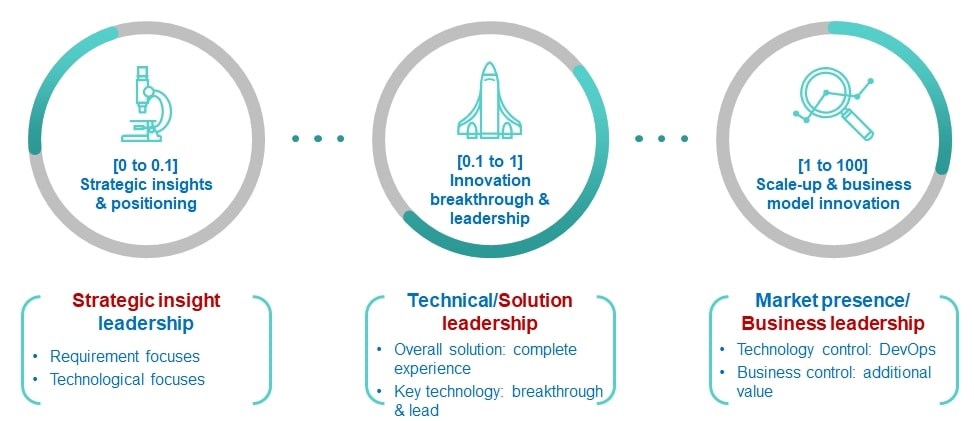
Figure 5: Building leadership in new domains and driving industry development in verticals
To overcome constraints in industry solutions and establish new leadership within the industry, carriers must utilize their differentiated resource advantages and the windows of opportunity presented in industry development. They must carefully verify action plans, focus on overall goals and smaller details, define phased roadmaps, innovate, iterate, and make breakthroughs.
During the U1.0 period, the telecom industry transitioned from the voice era to the mobile Internet era. During that transition, the US, Japan, and South Korea seized industry development opportunities, leapt ahead, and made substantial profits through the use of digital technology. The U2.0 period will present the trends, challenges, and opportunities of transitioning to the industrial Internet. As China evolves from an EM to an SM2, it is vital that Chinese carriers build leadership in new domains and use U2.0 as a guide to develop innovative B2X and B2B solutions. This will allow carriers to undertake leapfrog development and lead the world in terms of profiting from industry transformation.


Living in Harmony: All-optical Solutions Help People Co-exist with Asian Elephants
China Mobile Yunnan and Huawei have built a 1-3-9 all-optical smart city solution that uses all-optical connectivity to provide track and send alerts in real time if elephants roam onto land occupied by local people.
Overlapping living spaces
Asian elephants are the largest terrestrial vertebrates in Asia. A protected species in China, they are listed as an endangered species in the United Nations Convention on International Trade in Endangered Species of Wild Fauna and Flora (CITES). Wild Asian elephants are mainly distributed in Xishuangbanna Dai Autonomous Prefecture, Pu'er City, and Lincang City in Yunnan Province.
After more than 30 years of rescue and conservation efforts, the number of wild Asian elephants in Yunnan has increased from 190 in the early 1980s to more than 300 today. While the population grows, Asian elephants' living habits, especially their eating habits, are also changing. They are no longer afraid of humans and often look for food where people live, with the rich variety of crops grown outside elephant reserves attracting the gentle giants.
Preventing head-on conflicts between elephants and local residents is a challenge to conservation efforts.

Figure 1: Asian elephant rescuers giving rewilding training to rescued elephants
Alert! From manual to networked
Residents in Xishuangbanna have been looking for ways to avoid either themselves or their old neighbors getting hurt.
In the past, conservation workers on foot tracked the location of Asian elephants to both protect them and issue warnings to visitors. Although the infrared cameras deployed in forests recorded many valuable images, they could not be transmitted due to a lack of connectivity, wasting their value.
Moreover, Asian elephants are nocturnal, a time where manual observation is severely limited.
In 2019, to reduce conflicts between humans and elephants, Xishuangbanna National Nature Reserve launched China's first Asian elephant protection and monitoring system. Infrared cameras and video monitoring devices are deployed around the rainforest areas and villages that elephants frequent, and the data is transmitted in real time over the network. Alerts are sent through the intelligent broadcast platforms and mobile apps to warn nearby villagers if an elephant is nearby, creating a protective mesh as shown in Figure 2.
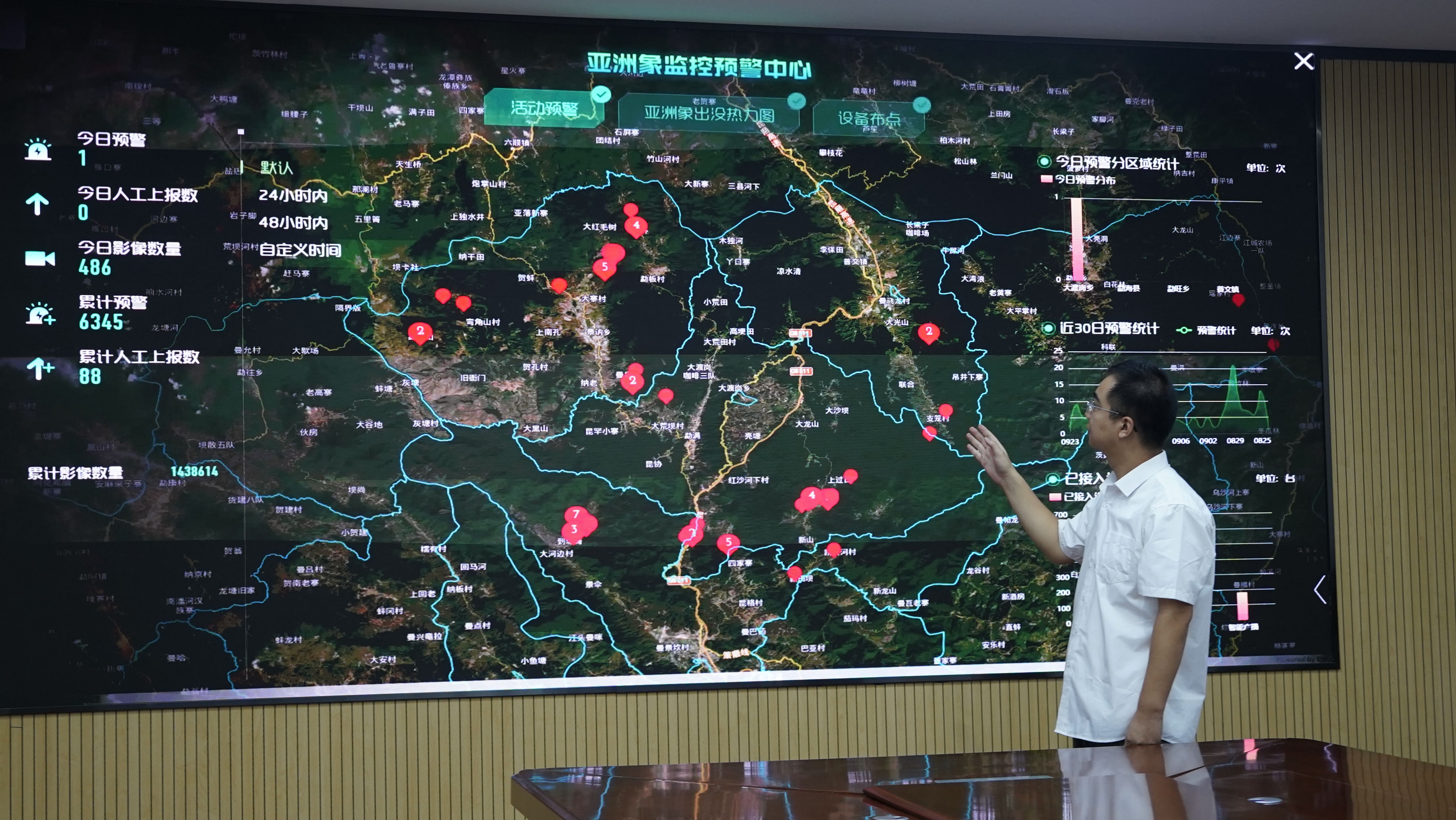
Figure 2: Asian elephant-monitoring and warning center
All-optical city networks
Real-time alerts are key to avoiding conflicts between humans and elephants. High-speed networks can help track Asian elephants in real time and greatly improve the efficiency of rangers and researchers. The high-speed network built by Huawei for China Mobile Yunnan uses technologies such as all-optical networks, 4G and 5G, cloud, and IoT, as shown in Figure 3.
In the past two years, China Mobile Yunnan established the all-optical smart city network construction plan as part of the Digital Yunnan strategy. By building a 1-3-9 latency circle covering Kunming, central Yunnan, South Asia, and Southeast Asia, China Mobile Yunnan aims to support the digital transformation of cities in Yunnan. The city of Kunming falls within the 1-ms latency circle, and the high-quality all-optical network features OTN sites distributed across the city to power a smart Kunming. Central Yunnan lies within the 3-ms latency circle. As an all-optical base for the integrated big data center system in Yunnan, the area introduced advanced technologies like OXC and 200G to achieve more than 10 times the digital transportation capacity at lower energy consumption. South Asia and Southeast Asia fall within the 9-ms latency circle.
Kunming is set to become an international digital hub node around Southeast Asia to strengthen infrastructure interconnections, unimpeded trade, financial integration, and information exchange between Yunnan and South Asian and Southeast Asian countries. It is intended to accelerate the construction of a central digital hub that radiates towards South Asia and Southeast Asia.

Figure 3: An engineer working on the monitoring and warning network equipment
3 key network features
First, private-line solution supports the real-time backhaul of high-definition monitoring videos. Monitoring data is crucial for researching the behaviors, distribution, and population of Asian elephants. High-quality private lines ensure the highly reliable transmission of monitoring data, while supporting microsecond-level latency in transmission from cameras to cloud. Lossless HD video data greatly improves the efficiency of identifying Asian elephants and provides real-time alerts to local villagers.
Second, the coordinated management of protecting Asian elephants is performed across counties and autonomous prefectures based on the all-optical city network. Wild Asian elephant activity occurs in many places, including Xishuangbanna and Pu'er, and collaboration across these places is crucial. The low latency of the 1-3-9 solution enables the real-time exchange of data between different forestry and grassland administrations, with ultra-high security and bandwidth.
Third, an ultra-low-latency optical transmission link is established between the Asian elephant monitoring and warning center in Xishuangbanna and the center at the provincial forestry and grassland administration in Kunming, enabling the two centers to collaborate on joint research.
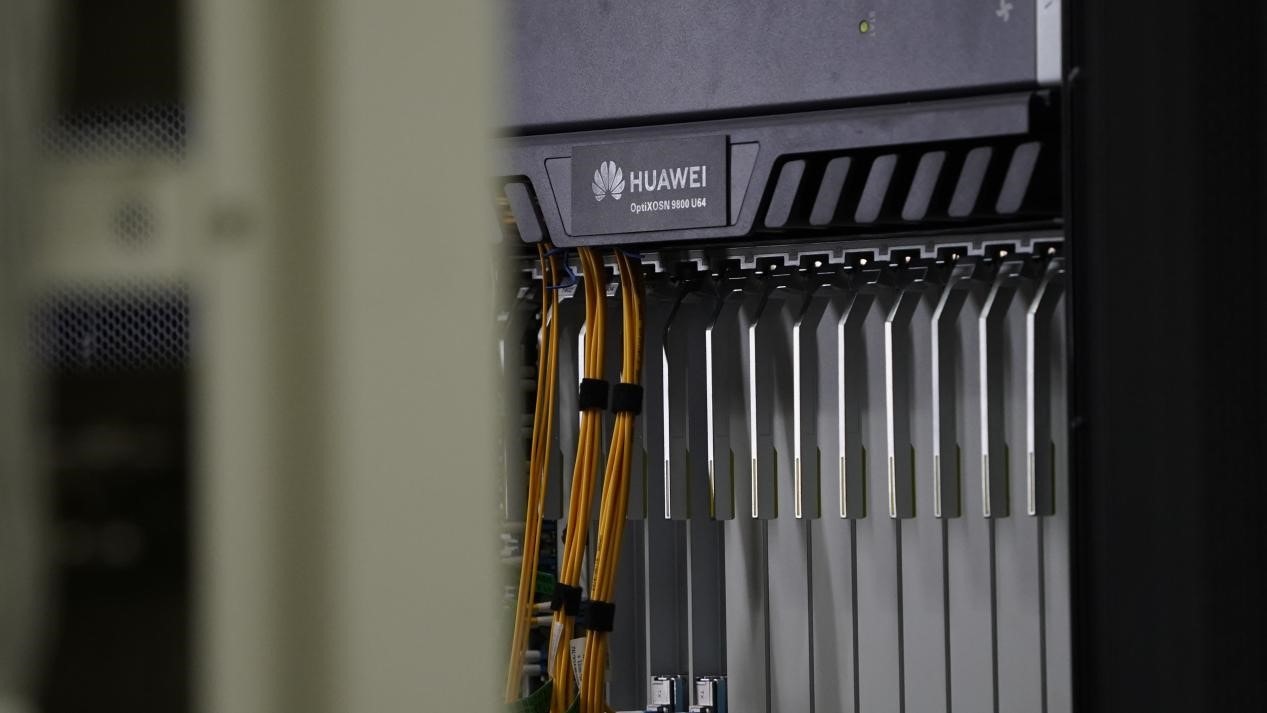
Figure 4: Huawei OTN equipment in the all-optical city network
Harmony enabled by technology
With the networks spread around local rainforests and villages, it takes just 10 to 15 seconds from spotting an Asian elephant to issuing an alert. So far, no injuries or conflicts have occurred where the monitoring equipment is deployed –more than 1.4 million images have been captured and 6,000 alerts issued.
Technological innovation can both benefit both humanity and biodiversity and is essential for a green and sustainable future.
Learn more about Huawei's all-optical network solutions .


How Huawei Transformed Its Supply Chain In the Digital Era
Huawei transformed its supply chain with digital technologies and innovated its operations and management models, taking customer experience and revenues to new heights.
Now is the time for digital transformation
As well as enabling rapid growth, digital technologies help enterprises transform industrial value and reshape business models globally. Comparing the market capitalization of the world's top-ten companies in 2010 and 2020 shows that digital natives, such as Apple, Amazon, Alibaba, and Tencent, are edging out companies in traditional industries like Shell and ExxonMobil.
The time is now for enterprises to digitalize if they hope to survive and thrive.
Objectives of Huawei supply chain ’s digital transformation
Focusing on improving customer experience and creating value through digital and proactive supply chain, Huawei launched its integrated supply chain plus (ISC+) digital transformation project in 2015. To transform its operations and management models, the project comprised an intelligent two-layer supply chain business system, service-oriented processes and IT, and scenario-based algorithm modeling
Transformation covered six areas that centered on transitioning from:
- An offline-focused business model to both offline and online.
- A working model based on transmitting information in series to an operations model based on the collaborative and parallel sharing of information.
- High volumes of manual operations to automated system operations.
- A decision-making model based on personal experience and intuition to a decision-support model enabled by data analytics, unified data warehouses, and data models.
- Push-type planned allocation centered on Shenzhen HQ to pull-type resource allocation driven by forecasts.
- A centralized management model to one that facilitates independent decision-making by field offices, with capability support and supervision from HQ.
Our digital transformation journey
ISC+ supply chain transformation has moved through the phases of digitalization and intelligent digitalization. Digitalization built the foundation of Huawei ’s digital capabilities, including its data foundation and service-oriented processes/IT. Intelligent digitalization builds on digitalization to make services more intelligent through algorithms and scenarios.
(1) Building a real-time, trusted, consistent, and complete data foundation
Data is a new production factor, with those able to acquire and control large amounts of data increasing potential advantages in global competition [1] . To build the data foundation, Huawei Supply Chain prioritized three areas of digitalization (see Figure 1):
- Business objects: includes mapping real-world objects, such as contracts and products, to the digital world.
- Business processes: includes automatically recording go-live business processes and operations processes such as cargo transportation.
- Business rules: includes managing rules for complex scenarios using digital solutions; decoupling business rules from applications; and making rules configurable, such as inventory cost accounting and order splitting rules.
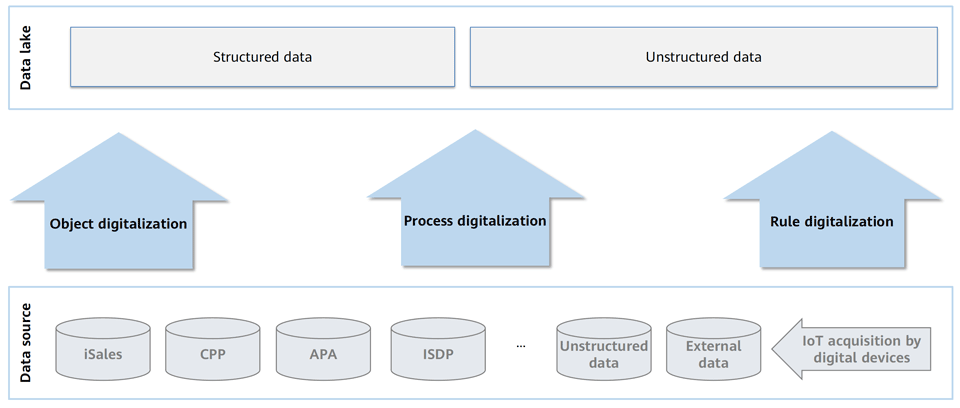
Figure 1: Three areas of business digitization
(2) Flexible orchestration through service-oriented processes/IT
Traditional supply chain IT systems are siloed, which creates problems when business volume increases and requirements rapidly change. Subsequent issues, such as poor user experience, repeated construction, and long response periods, prevent business development needs from being achieved.
Retrofitting large complex systems to form service-oriented subsystems and integrating various service elements, application elements, and data elements into these subsystems can link services, data, and system functions (see Figure 2).
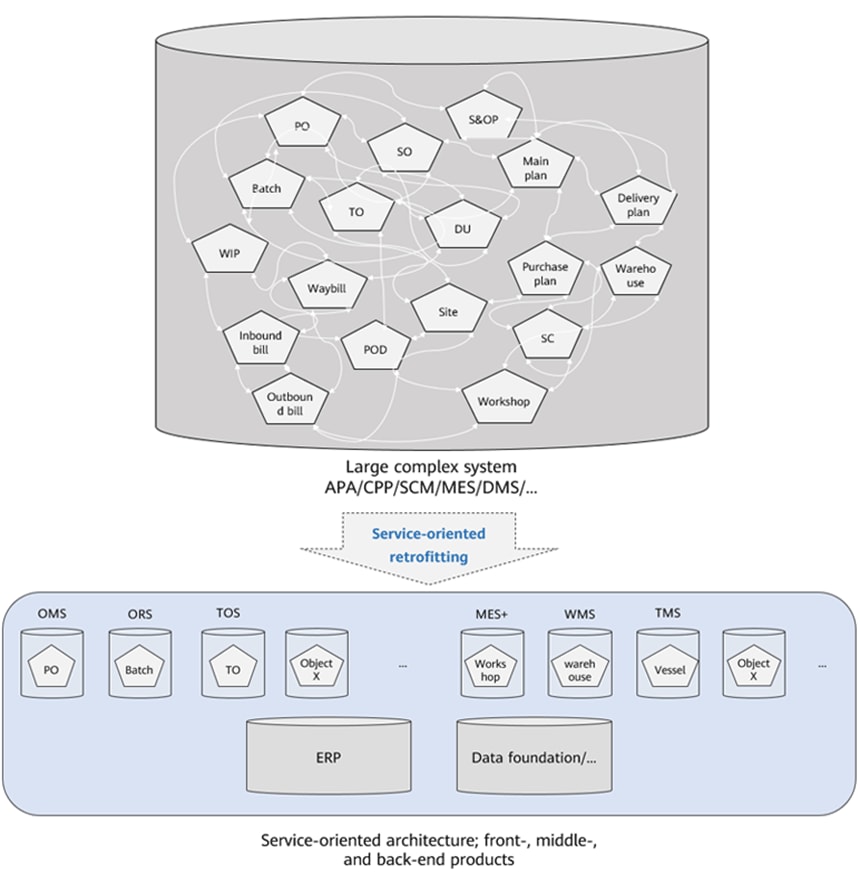
Figure 2: Retrofitting large complex systems to create service-oriented subsystems
Huawei has retrofitted and developed more than 80 service-oriented subsystems for its supply chain. Business capabilities are encapsulated into services and invoked and orchestrated for different scenarios, allowing a quick response to service requirements. For example, for our intelligent automotive solutions business, we quickly adapted supply chain to the new business model by re-orchestrating and retrofitting service-oriented capabilities based on value flows and the requirement to develop processes and systems quickly, which greatly accelerated the rollout of new services.
(3) Intelligent supply chain through scenario design and algorithm modeling
At the core of enterprise operations, supply chain represent the integration of information flows, material flows, and capital flows [2] . Supply chain management aggregates information flows and directs efficient materials and capital flows.
Algorithms are essential for processing massive amounts of information. Gartner considers algorithmic supply chain as a future trend in supply chain development, defining them as the industrialized use of complex mathematical algorithms pivotal to driving improved decision-making and process automation in the supply chain to create business value [3] .
Huawei Supply Chain used various techniques, such as optimal combination, statistical prediction, and simulation, to build core algorithm models for supply chain. To ramp up the intelligence of supply chain operations, the models were applied to resource preparation, supply fulfillment, supply networks, and intelligent operations.
For example, to prepare resources, Huawei's supply chain face complex business requirements that involve tens of millions of pieces of data and 100 MFLOPS-level computing. We have built a bidirectional simulation engine between components, boards, products, and orders based on techniques such as linear programming, mixed integer programming, and heuristic algorithms (see Figure 3). This engine quickly locates the optimal resource preparation solution from within the complex product structure tree and supply network nodes, achieving control on inventory and maximizing supply capabilities.
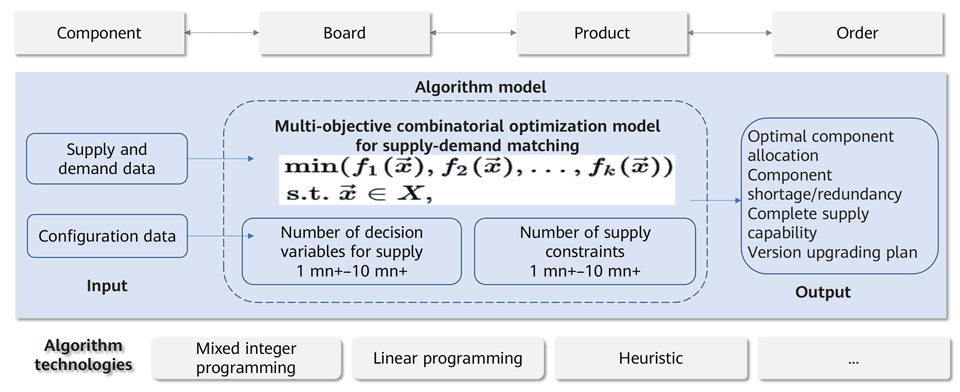
Figure 3: Algorithm-based bidirectional simulation engine
Building a two-layered, intelligent business system
Based on the data foundation, retrofitted service-oriented processes/IT, and the development of algorithms, Huawei has restructured its supply chain to form an intelligent two-layer business system. The system consists of intelligent supply chain decision-making based on the Lingkun digital intelligent cloud brain and agile operations based on the Lingfeng intelligent engine. The Lingkun solution is a business-oriented brain for supply chain, which provides global data analytics, simulation, contingency plan formulation, and decision-making functions. The Lingfeng solution is an intelligent operations unit that facilitates agile, efficient, plug-and-play, and swarm-style onsite operations for operations sites and service fulfillment.
(1) Lingkun: Intelligent supply chain operations
The Intelligent Operation Center (IOC) is a key part of the Lingkun digital intelligent cloud brain for supply chain. It enables intelligent operations in three ways.
For service operations , the IOC provides more than 300 probes for key points of service to automatically identify abnormal business activities or indicators. The IOC replaces full management with variable management and automates exception detection.
For process operations , 1) Process-embedded algorithms automatically achieve management objectives during process operations and reduce management actions. 2) The forward process design stage reduces reverse services by identifying what causes them. 3) Process mining technology and similar-item merging provide a much simpler way to identify and then fix bottlenecks and breakpoints in processes.
For network operations , the IOC can quickly detect and analyze the impact of risk events by accessing supply network data, and rapidly allocate and deploy supply network resources and capabilities based on contingency plans. Sensing risks and requirements in real time, making resources and capabilities visible, and enabling the controllability of processes and outcomes make supply networks agile and resilient.
The IOC breaks down walls between functions and along processes to provide cross-function, cross-process, and cross-node integrated operations in key business scenarios. Exception detections can be quickly closed and resolved. For example, before the transformation of order fulfillment exception management in Huawei's Shenzhen Supply Center (see Figure 4), more than 100 order fulfillment managers were required to individually communicate with coordinating, planning, and procurement personnel, and then analyze and process exceptions. The IOC enables the system to automatically detect and locate exceptions, analyze causes, and recommend solutions. Exceptions are no longer only processed manually. Instead, they are automatically processed for manual confirmation, raising operations efficiency by 31%.
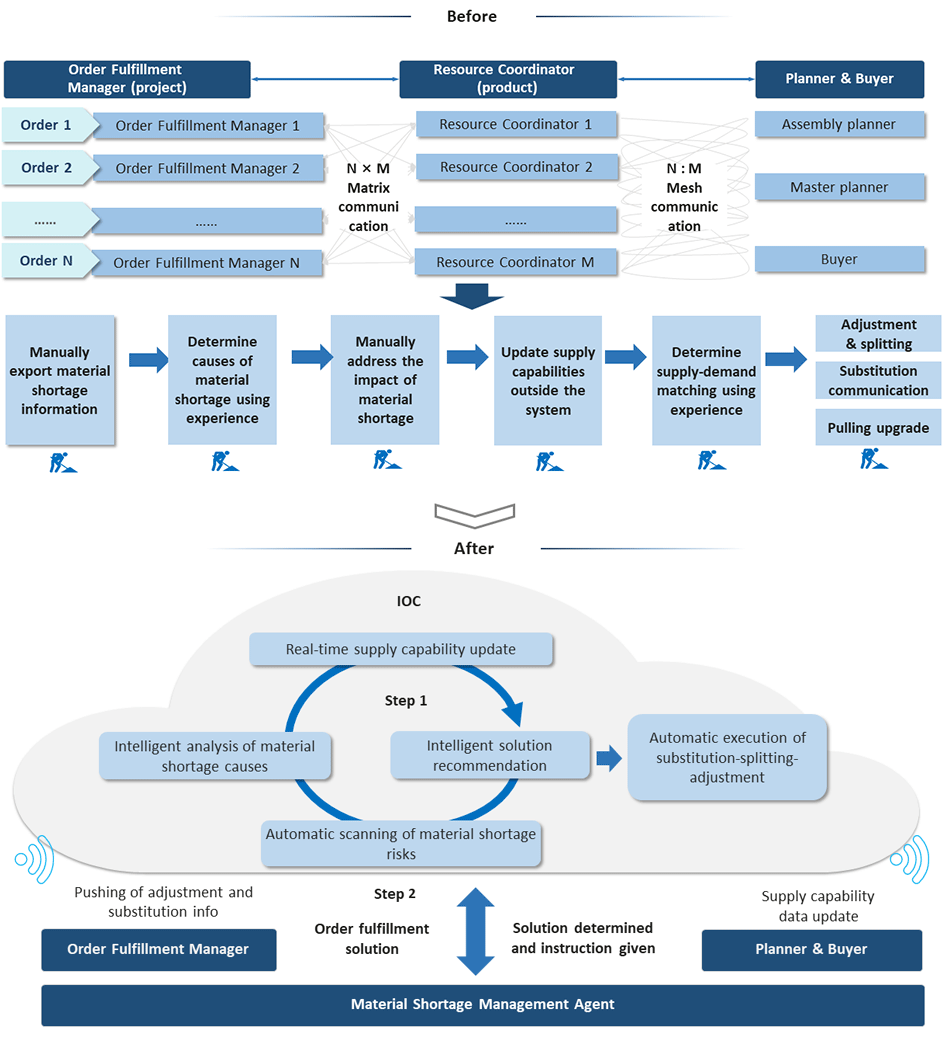
Figure 4: IOC-empowered order fulfillment exception management
(2) Lingfeng: enables efficient operations within supply nodes and seamless connection between nodes
The intelligent operations of the Lingfeng intelligent logistics center provides a good example of how the Lingfeng intelligent engine facilitates agile and efficient onsite operations.
Located in Huawei's logistics campus, the Lingfeng intelligent logistics center covers an area of 24,000 square meters and is one of the order fulfillment nodes of Huawei's worldwide supply network.
In the logistics center, 12 algorithm models have been deployed, including inventory distribution, wave creation, and AGV scheduling. Nine types of automated equipment are available, for example, AGVs, dense storage, automatic measurement, and RFID. Manual operations for materials are automated and efficient operations are achieved through automatic material distribution and warehousing, storage-picking separation, intelligent warehouse transfer, intelligent scheduling, balanced production scheduling based on wave picking, automatic measurements of finished products, and automatic scanning and stock-out.
For transportation between the nodes when a shipping order is generated, drivers can book the pick-up time on the digital platform, and the system will automatically plan the route and estimate how long it will take. Onsite tools like volume estimation and packing simulation can automatically determine the picking sequence and loading plan. Tally is reversely scheduled based on the driver ’s arrival time so that the goods are ready when the vehicle arrive at the dock. This enables delivery immediately after product off-line.
Powered by the digital engine, the Lingfeng intelligent logistics center optimally allocates resources, such as people, vehicles, goods, yards, and orders, and provides the integrated scheduling of reception, storage, picking, tally, and delivery (see Figure 5).
As a result, service volume has doubled with the same number of employees and site area, leading to improved customer experience and service.
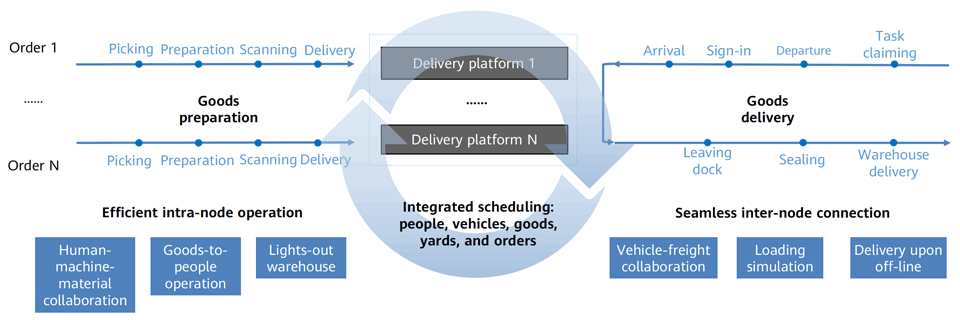
Figure 5: Operation model of the Lingfeng intelligent logistics center
Closed loop with the supply chain digital twin
A digital twin can be defined, fundamentally, as an evolving digital profile of the historical and current behavior of a physical object or process that helps optimize business performance. [4] .
Through digital transformation, Huawei Supply Chain has made substantial progress in constructing the supply chain digital twins (see Figure 6). First, through business digitization and service-oriented processes/IT, the supply chain in the physical world are mirrored to the digital world. Then, information is extracted from data based on scenarios and algorithms, forming intelligent service instructions that guide operations in the physical world. Finally, the intelligent service instructions drive efficient onsite operations, facilitating a closed loop from the digital world to the physical world.
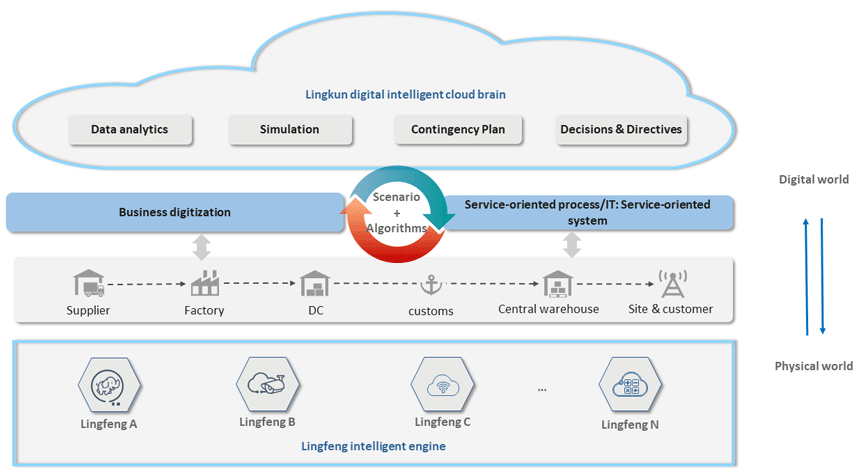
Figure 6: Supply chain digital twins
From digitization and digitalization to digital governance
Through digitization and digitalization, the Huawei supply chain has elevated customer service levels and improved the delivery time, E2E ITO, and supply cost rate by 50%.
The supply chain have supported the rapid development of Huawei's new businesses, such as enterprise services, cloud, and intelligent automotive solutions with approximately the same number of employees, helping the company significantly increase its revenue. Huawei Supply Chain has transformed from responsive services to proactive services, from support division to value creator, and from supporting market development to supporting marketing and competition.
Digital supply chain have become an area of Huawei's core competitiveness.
Huawei ’s digital supply chain ensure supply continuity, improve customer experience, and support the company's business growth in an uncertain external environment. However, digital transformation of supply chain should not stop at digitization and digitalization –Huawei aims to use digital technologies to reshape supply chain service models, including the management, operations, and organization, and deepen collaboration with ecosystem partners. This "digital governance" will help improve customer experience, support the company's operations, and realize the sustainable development of the supply chain ecosystem.
- Big Data White Paper [R], 2020, China Academy of Information and Communications Technology
- Ten Points CSCOs Need to Know About Algorithmic supply chain [OL], July 11, 2016, Gartner https://www.gartner.com/document/3372319?ref=solrAll &refval=286443502
- Purchasing and Supply Chain Management: A Practitioner's Perspective [M], 2020, Liu Baohong
- Industry 4.0 and the digital twin [R], 2017, Deloitte University Press https://www2.deloitte.com/us/en/insights/focus/industry-4-0/digital-twin-technology-smart-factory.html


How Carriers Can Tackle Cloud Repatriation
More than 80% of enterprises that migrate their applications to public cloud repatriate them back to the private enterprise environment. Learn how carriers can respond.

I. What is cloud repatriation?
Public cloud can undoubtedly improve the agility, flexibility, and synergy of enterprise services. However, it may also present challenges such as higher cloud migration costs, deteriorating performance, and higher security risks. For example, improper cloud migration policies can lead to continuous performance deterioration, compelling many enterprises to move some or even all of their applications off of public clouds. This reverse migration of services from public clouds back to enterprises' own data centers, and the replacement of public clouds with hybrid or private clouds, is known as cloud repatriation. According to IDC's August 2021 cloud repatriation report:
- 80% of respondents repatriated their workloads from the public cloud in the past year.
- Repatriation rates increase when public clouds cost more than alternative computing solutions.
- More than 70% of enterprises now use multiple cloud solutions.
II. Implications from a case study
Seagate CIO Ravi Naik's cloud migration experience highlights the problem of growing costs. After migrating a large amount of its services to the AWS public cloud, elastic computing enabled Seagate to integrate its four data centers, which were located around the world, into one data center and modernize its IT infrastructure. However, Seagate soon found that costs were rising due to the higher volumes of data being generated and bandwidth requirements in one of its big data systems running on AWS. This reached the point where it was cheaper for Seagate to simply use its own data centers.
Therefore, Naik led the Seagate team to reassess the company's cloud strategy, and used cloud-native architectures and tools to improve its big data analytics solution. On-premise testing showed that the new system could run a more efficient ecosystem beyond the public cloud. The new operating environment was a multi and hybrid cloud environment that included AWS, Azure, and Seagate's own data center. The team therefore moved the data lake application system off the public cloud and deployed it in a private cloud.
TCO was a major factor in the company's decision to repatriate its big data system. Reducing TCO and optimizing processes cut expenditure by 25%. Seagate generates more than 30 terabytes of data per day and while only a portion of this is moved into its data lake, transferring data between seven plants on three continents costs millions of dollars a year. Following the repatriation, Seagate was able to transfer large-scale datasets across the globe at a fraction of the cost of transferring data over the WAN and data acquisition time was shortened from weeks to just 72 hours.
III. Analysis of the causes of cloud repatriation
Through years of examining carriers' cloud transformation practices and observing numerous cases of cloud repatriation, the main reasons for cloud repatriation are summarized as follows: are as follows:
1. Services are subject to security and compliance restrictions
Public cloud security must be improved. Common issues include incorrect cloud platform configurations (71%), sensitive data breaches (59%), and unsecure APIs (54%).
Frequent cloud security incidents caused by data and security breaches mean that security and regulatory issues often force governments and enterprises to opt to repatriate their applications to private clouds or their own data centers. On-premises solutions typically feature robust overall management and well-defined security boundaries, leading to more effective data control. For this reason, many enterprises use hybrid cloud (44%) and multi-cloud solutions (43%) for data backup and redundancy. This will become a trend over the next few years.
Technically, public cloud and private data centers are equally secure. However, any issue that arises with public cloud may cause irreparable damage. Given the nature of remote access, refined access control in public clouds, and the additional security and compliance requirements of modern enterprises, there is no question that some critical applications are simply not suitable for deployment in a public cloud.
2. The cost of cloud migration remains high
In terms of computing resources, public clouds are highly scalable and agile, and can provide inexpensive capacity expansion to meet surging computing capacity needs. However, public clouds are not cost-effective for applications that are deployed year-round at scale. Ultra-large-scale instance deployments consume huge amounts of computing resources, resulting in higher cloud expenses. This is particularly true for legacy systems that have simply undergone lift-and-shift migration, rather than refactoring or rearchitecting. In such cases, massive computing resources cannot be promptly released even when applications are idle. In addition, computing resources will not be scaled down as needed after being scaled up, resulting in wasted resources. Users see costs rising, but neither cloud solution providers (CSPs) nor users can do anything about it, making cloud repatriation unavoidable.
In terms of storage resources, the cloud-related cost of an application can involve many hidden and changing resources. As services expand, the demand for data storage and cloud-to-local data transmission increases. Initially, storage and transmission costs are not significant during the planning of public cloud deployment. However, over time, as costs start to exceed the budget, the reverse migration of applications or data becomes inevitable.
In terms of services, vendor lock-in can be a reason for customers to opt for cloud repatriation. An over-reliance on the tools and systems of a single CSP can leave customers with no choice but to switch to alternatives when the CSP starts charging more for the same services.
3. Cloud migration paths are unclear and service performance deteriorating
Migrating applications to the cloud requires comprehensive planning and extensive testing. Many services that are migrated to cloud are not designed for cloud and not refactored for cloud before migration. This is particularly true for enterprise applications developed in-house, where the cloud architecture does not match deployment environment requirements. As a result, latency becomes an issue and repatriating applications back to on-premises deployment is the simplest solution for enterprises.
In addition, public cloud performance (for example, data transmission rate to and from the cloud) varies greatly. This can make resources inaccessible to some applications that require them when WAN bandwidth is inefficient or the CSP's overall service volume is high.
4. Service availability does not meet SLA requirements
A public cloud system outage may last for hours or more, affecting numerous customers. When this occurs, cloud customers can only rely on CSPs' allocation of backup resources and remedial efforts under SLAs.
5. Carriers lack technological innovation capabilities
Driven by new technologies, enterprises must modernize applications that have been migrated to the cloud, including adopting microservice-based and container-based architectures. Cloud-native, for example, consists of applications and the supporting cloud environment. Based on cloud-native infrastructure and the platform tools provided by CSPs, enterprise applications, both ISV-provided and self-developed, must offer a microservice architecture with features such as modularization, orchestration, and container-based deployment. Generally, during IT modernization, the biggest challenge faced by CIOs is making legacy applications cloud-native. How can applications be optimized to become cost-effective? When application modernization encounters challenges, such as resource integration, TCO, and data security, it is reasonable to migrate applications back to on-premises deployments.
6. Carriers lack cloud service management skills
Another challenge to public-cloud-based enterprise applications is changes in cloud-related management, processes, and employee skills. Many regard the cloud as just another form of data center, and thus take a conventional approach to the public cloud, expecting the required management, processes, and skills to be similar to those of corporate data centers. However, this approach means missing out the opportunities that the cloud truly offers. It also creates additional challenges in areas such as architecture, processes, network security, and stable operating environment. Faced with such challenges, enterprises often consider moving their applications back to corporate data centers.
IV. Six measures to avoid cloud repatriation
The core reason for cloud repatriation is problems in the cloud migration path. Efforts in the following areas will help carriers reduce cloud repatriation and improve service levels.
1. Proper planning
The primary cause of many companies' cloud repatriation is a lack of proper planning, with many questions unanswered: Which applications are suitable for cloud migration and which are not? What preparations should be made before migrating to the cloud? How can we maximize business benefits by leveraging public cloud technology?
CSPs might not understand a customer's services, but they can help by playing a leading role throughout the lifecycle, including strategy development, migration planning, migration implementation, O &M, and technology upgrades. This approach can prevent customers from aimlessly migrating to the cloud.
2. Data sovereignty
A core reason for cloud repatriation is data security compliance. Deep insights into telecom network data are indispensable for developing solutions that properly support data security compliance and balance data sovereignty and service needs.
3. Training on cloud technology and O &M
A lack of necessary cloud technologies and cloud O &M expertise means that it is impossible for many enterprises moving to cloud to maximize the benefits. When problems start to arise, these enterprises often make the unwise decision of repatriating from the cloud. Therefore, when developing cloud strategies, carriers should come up with both cloud technology training and cloud O &M training plans to prevent losses caused by unnecessary cloud repatriation.
4. Hybrid cloud model
Enterprises can combine public- and private-cloud and on-premises resources to gain the agility required to gain competitive advantages. Hybrid cloud also enables enterprises to ensure that critical data stays on-premises for enhanced performance efficiency, while also meeting national/regional regulatory, data localization, and privacy regulations. This makes the hybrid cloud model the best choice. During communication with enterprises and solution design, carriers should help enterprises design a sound hybrid cloud architecture based on the nature of their services and the related requirements. Carriers should also provide cloud migration planning and design services. This will help enterprises develop effective cloud migration methods and application selection methods.
5. Cloud-native preferred
New applications should employ cloud-native architecture, so that microservice architecture can be orchestrated, distributed, and containerized. Such applications will bring value to customers on the cloud and eliminate the need to repatriate their services.
Carriers must help customers analyze legacy applications and provide appropriate suggestions and feasible upgrade solutions such as re-hosting, platform updates, rearchitecting, and replacement. Carriers should also make use of TCO and ROI analyses to show customers the value of cloud migration.
6. Digital priority strategy
In line with industrial digitalization, carriers are using new technologies, such as AI, 5G, big data, and cloud, to accelerate the digital transformation of industries. As top carriers shift from prioritizing cloud to prioritizing digitalization, they should focus on value-driven transformation based on customers' business scenarios. This will ensure that applications migrated to cloud can significantly benefit enterprises.


What Can Carriers Learn from Leading Cloud Vendors?
Three vendors have achieved profitability in the global cloud domain: Amazon Web Services (AWS), Microsoft Azure, and Alibaba Cloud. How can carriers catch up and thrive in the cloud market?
Although cloud transformation has been underway in the telecom industry for five years, carriers still rely on reselling cloud offerings and technologies from vendors and expanding the market through one-off projects.
Some carriers have started to develop cloud technologies and build cloud platforms, but they are still much less competitive than AWS, Microsoft Azure, or Alibaba Cloud, all of which have successfully monetized their cloud offerings on a global scale. As mobile Internet evolves to industrial Internet, breakthroughs in vertical industries will be essential for carriers to thrive in the cloud market.
In this article, we analyze the successes of the three vendors and provide targeted suggestions for carriers' cloud service transformation.
I. Development track of the successful cloud vendors: Streamlining the vertical value chain
As well as the three most successful vendors, Siemen's Cloud also provides useful takeaways. Other powerful players, such as Google, are still trying to make breakthroughs
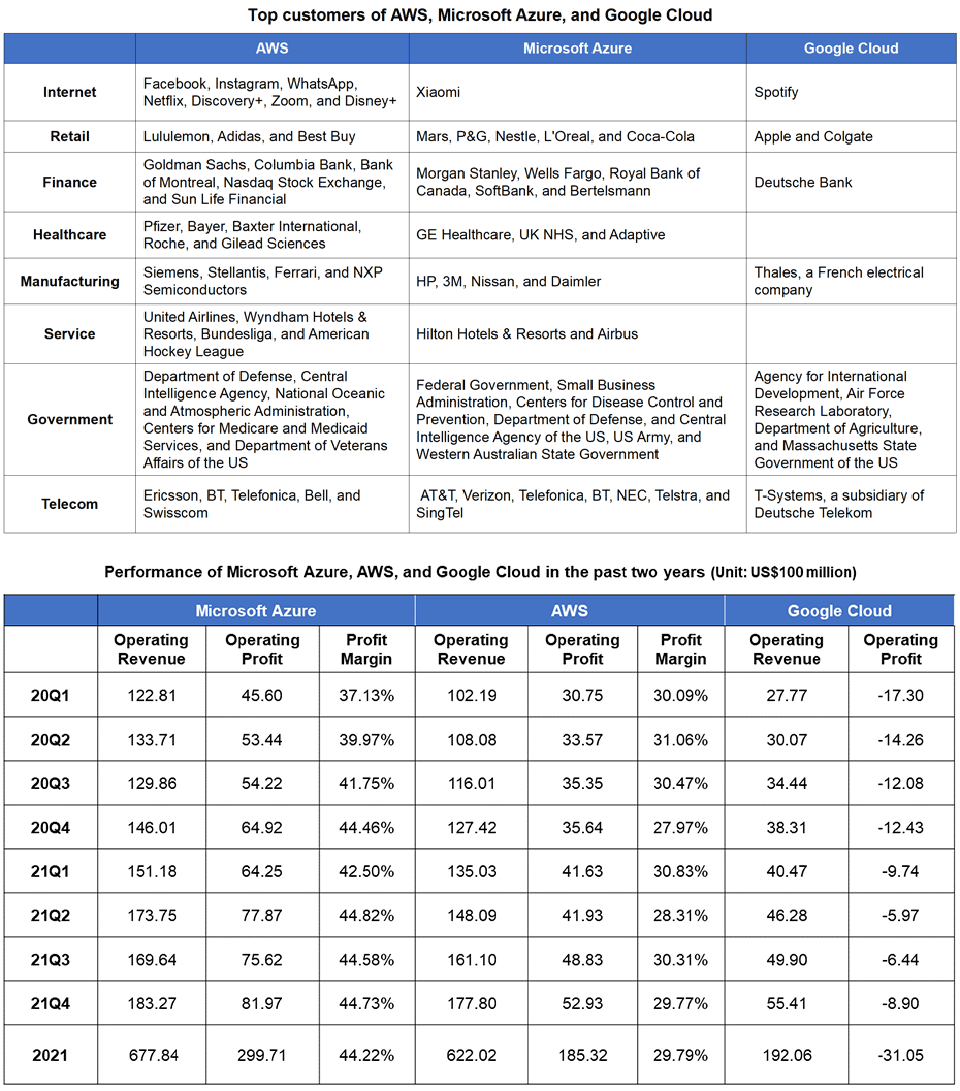
Figure 1: AWS, Azure, and Google Cloud: Industry penetration and performance (Complied by Caijing)
The big three have adopted a "being integrated" strategy. They have technical advantages in IaaS, PaaS, and SaaS, and possess the infrastructure needed to support cloud strategies that target vertical industries. AWS and Azure work as a platform, and profit from offering PaaS and SaaS to verticals. Alibaba Cloud pursues an aPaaS model.
1. AWS: Leading in Infrastructure + PaaS
AWS dominates the PaaS market with its performance, efficiency, cost-effectiveness, security, and openness. Governments, banks, and top OTT providers work with AWS to achieve cloud-based digital transformation. The US government, top large enterprises, and OTT providers have the capacity to upgrade towards AaaS and SaaS systems. As integrators, they integrate AWS's PaaS system to streamline the industry value chain and iterate and operate applications and services. The support of top customers is essential for AWS to achieve profitability with PaaS. Its B2B business is developing in a virtuous circle.
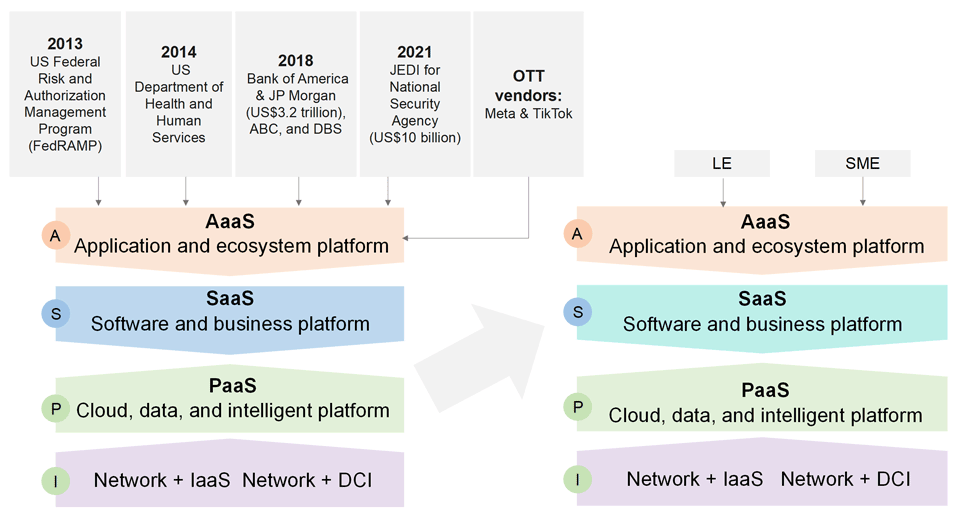
Figure 2: AWS VS Azure: The "being integrated" strategy from PaaS to SaaS
2. Azure: Leading in Platform + SaaS
In 2021, Microsoft's revenue from its public cloud service Azure was US$67.784 billion, surpassing that of AWS.
Azure's growth depended on its full-stack solutions that integrate Azure and its self-developed software systems, forming SaaS solutions for enterprises that opened up the market. These solutions include the office collaboration platform Teams, the Power Platform and Dynamics development platforms, ERP and CRM products, Office Enterprise, Windows Enterprise, and LinkedIn Talent Solution (Enterprise). The revenue of this segment was US$12.2 billion in 2021, and the total revenue of Microsoft's cloud business (Azure + productivity and business processes) exceeded US$80 billion.
Based on SaaS, Microsoft provides Power Platform, an open platform for application innovation. Industry customers can use this platform to develop applications with a top-down approach. Integrating Microsoft's SaaS to form new solutions for the B2B vertical market helps Microsoft make breakthroughs in AaaS.
3. Alibaba Cloud: Innovating in aPaaS to achieve breakthroughs in the B2B market
In China, Alibaba is the best example of replicating AWS's model. In addition, Alibaba has worked with the Zhejiang Provincial Government to create the Zhejiang Government DingTalk service, which is another typical example of cloud innovation.
DingTalk penetrates the B2B market through Alibaba Cloud's PaaS capabilities. Alibaba provides DingTalk video applications and the Alibaba Cloud platform. It has also created YiDA, a low-code development platform that supports direct application development, achieving innovation in new business forms.
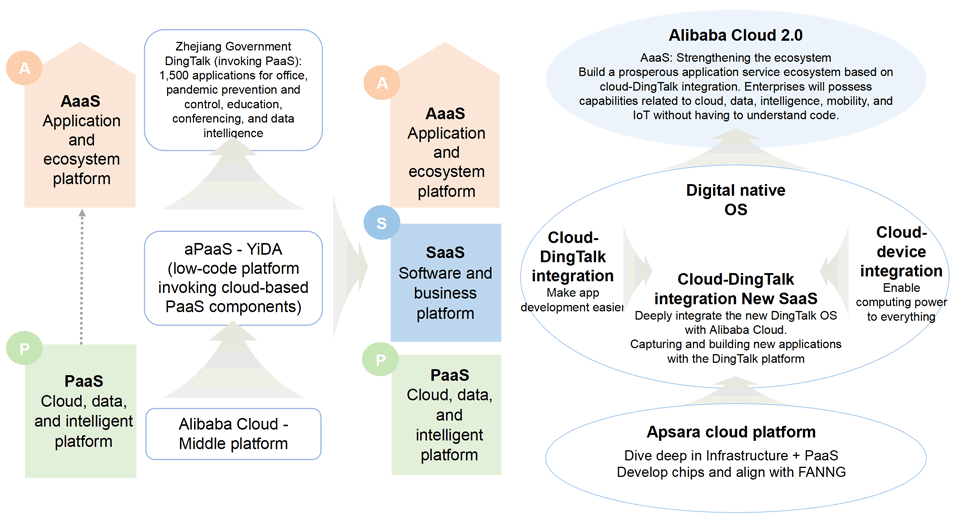
Figure 3: Alibaba Cloud + YiDA for a "no-code development" aPaaS platform, enabling open innovation of new government applications
The aPaaS model simply links the original SaaS systems of the industry rather than fully and systematically upgrading and transforming SaaS. Its use cases and value are limited, and its competitiveness has room for improvement as it does not touch the core software of the industry.
Drawing from the strategic practices of the three vendors in the cloud domain, the development of cloud services must enable breakthroughs and innovation in new services in vertical enterprises and industries, and industry leaders must select and integrate the technologies and platforms of cloud vendors during cloud transformation. Leadership in cloud technologies is the foundation of the profit model.
II. Takeaways from Siemens: The intelligent digital transformation of industries
Powerful integrators that lead innovation were critical to the success of AWS, Azure, and Alibaba Cloud. How can leaders in vertical industries break through the ceiling of strategic cloud-based upgrades to achieve success? Siemens provides an answer.
Siemens's strategic practices are an example of the inside-out and top-down Application + SaaS solution innovation model.
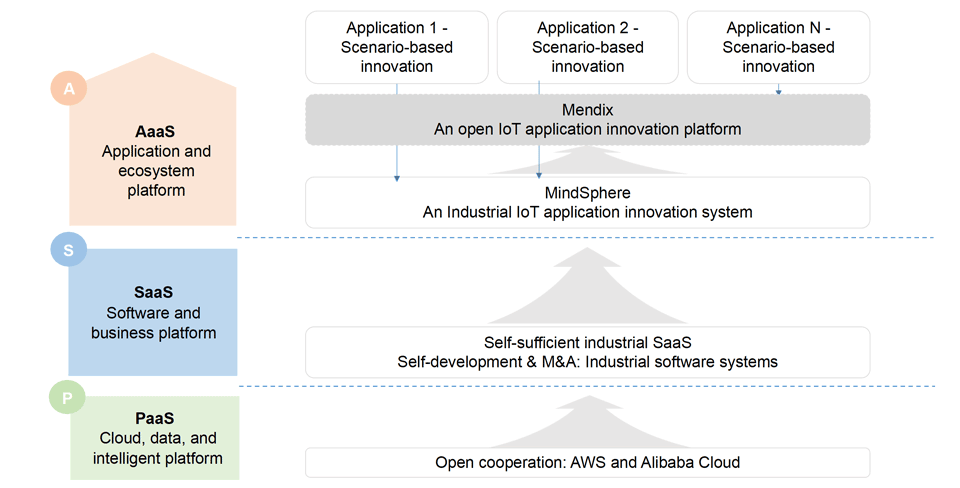
Figure 4: Siemens's industrial intelligent solution
Siemens's intelligent manufacturing solution is driven by the IoT applications used in its own manufacturing activities. The company possesses powerful industrial SaaS platforms and capabilities. To achieve intelligent digital transformation, Siemens developed MindSphere, an innovation platform for IoT applications. Different types of industrial IoT devices, such as intelligent control robots, robotic arms, AGVs, and sensors, can be developed on this platform to form Application + SaaS platform capabilities.
On top of MindSphere, Siemens provides Mendix, a low-code development platform for IoT applications to open up MindSphere capabilities. This helps its partners develop customized applications and services based on factory scenarios, forming an ecosystem-based application environment for factories. At the IaaS and PaaS layer of the basic cloud, Siemens integrates leading and standardized cloud capabilities from Amazon and other vendors to streamline the entire ecosystem from connectivity to applications.
Siemens's intelligent digital strategy identifies and focuses on high-value IoT application scenarios, and implements solutions for new services and applications based on a technology maturity assessment. After developing a new business model that can be expanded commercially, Siemens accumulated capabilities for horizontal expansion. This scenario-driven, value-oriented, and step-by-step strategy has helped Siemens surpass GE to become a model for the intelligent digital transformation of the industrial Internet.
III. References for telco cloud: Scale-up and new breakthroughs
Telecom carriers can draw on the experience of the above vendors to develop new strategies for cloud services. The following four models can be used for reference:
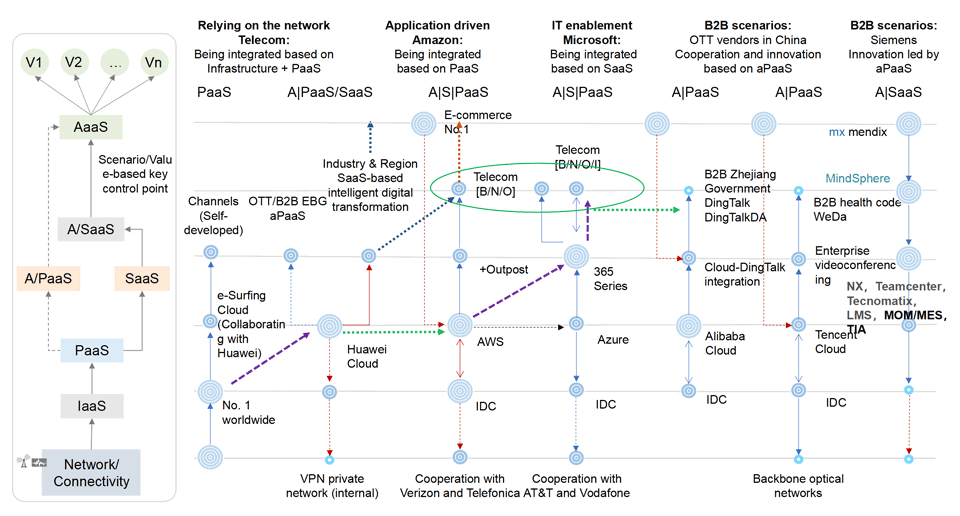
Figure 5: Cloud strategy analysis
1. Expanding the ecosystem-based aPaaS innovation model, i.e., the Alibaba model
Carriers can use the PaaS capabilities provided by cloud to make breakthroughs in new application innovation in low- and medium-level scenarios. However, as this bypasses the core software systems, growth potential is limited.
2. Expanding the "being integrated" model based on Platform + SaaS, i.e., the Amazon and Microsoft model
Carriers can identify industry leaders like Siemens for strategic collaboration and embed their cloud into streamlined vertical industry solutions to achieve breakthroughs in new business forms and applications.
In the absence of integrators and software leaders in the industry, carriers must assume the responsibilities of industry value chain leaders to identify application scenarios that can be streamlined, lead joint innovation, and achieve innovation breakthroughs and implementation in vertical domains.
3. Building new SaaS capabilities in new industry domains, i.e., the China Mobile model
Huawei has launched the open-source OpenHarmony and cloud-based openEuler to adapt to IoT. With the number of HarmonyOS users at 320 million, Huawei has made breakthroughs in software localization and promoted the upgrade of local clouds to evolve from PaaS to SaaS. China Mobile has worked with Huawei to innovate applications in IoT based on OpenHarmony.
4. Inside-out breakthroughs based on Application + SaaS, i.e., the Huawei and Siemens model
Carriers integrate cloud based on application scenarios and systems to achieve solution penetration and value-based breakthroughs. For example, Huawei is planning to integrate its internal IT processes and application systems with its own cloud PaaS to form internal Application + SaaS systems. This is to support the intelligent digital transformation of Huawei's business units (BUs) and frontline sales organizations to improve efficiency, optimize costs, and build new competitiveness. Like Siemens, Huawei has combined its internal manufacturing system with Huawei Cloud to form an intelligent manufacturing system based on Application + SaaS.
Carriers can also plan to integrate enterprises' IT systems and production and operations (OSS/BSS) systems with the cloud top-down to achieve breakthroughs in E2E industry solutions and value-based innovation with their advantages in application scenarios.
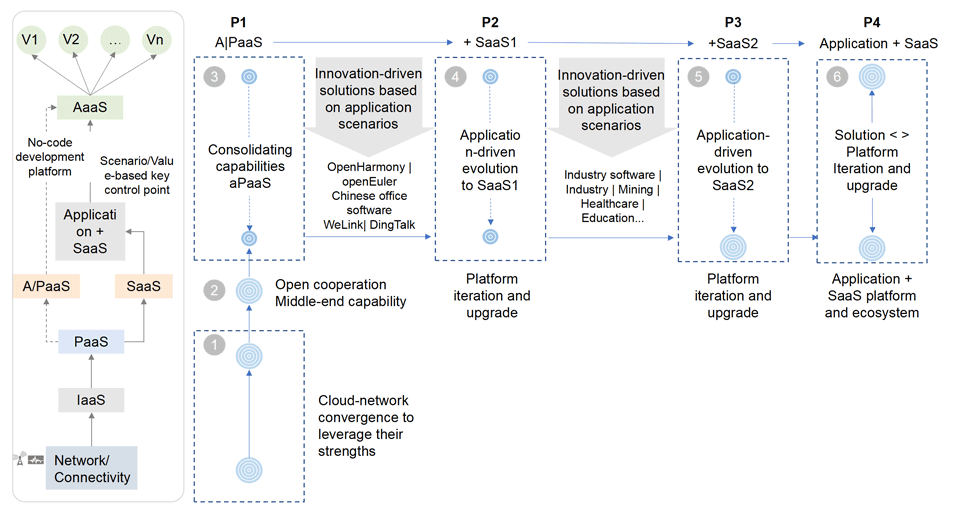
Figure 6: China's cloud growth path and suggestions for carriers' cloud transformation strategies
IV. Telco cloud's four steps to achieve new breakthroughs in China
In China, the telecom industry must shift from being driven by technology and strategy to being driven by scenario-based applications and value to make breakthroughs in cloud services. The path to achieving breakthroughs can be divided into four steps:
The first step is to replicate and extend Alibaba's aPaaS model based on the maturity of the Chinese market and solution feasibility to achieve new application and value-based breakthroughs. The aPaaS model does not have much potential for growth. To drive industry development, carriers must help the market segment of IT software systems achieve cloud transformation. This segment, including basic enterprise software and specific industry application software, accounts for more than 90% of the value.
The second step is to focus on core software systems of enterprises and industries to build SaaS solutions and platform-based leadership. According to current industry development and capabilities, carriers can initially replicate Microsoft's enterprise software suite, i.e., the model comprising Windows, Office, LinkedIn, and Azure. The Chinese market, for example, has the mature HarmonyOS, Office software such as Kingsoft, and video conferencing and social software such as WeLink and DingTalk, which can be combined with existing PaaS capabilities to achieve SaaS1-based transformation of basic enterprise software.
The third step is to deep dive into vertical industry software systems to upgrade, reconstruct, and integrate them using cloud. Huawei and Siemens's SaaS practices can be used for reference.
The fourth step is to build industry-leading new Application + SaaS solutions and platforms, providing low-code development, ecosystem-based, and open innovation platforms similar to Siemens Mendix. This can realize the sustainable development model consisting of Application + SaaS platforms and ecosystem-based innovation.


Why Full-Stack Data Centers Have Arrived at the Right Time
Our full-stack data center solution reshapes computing and storage, networks, disaster recovery, and green technology in a way that can drive enterprise digital transformation and power the digital world.
Optimized infrastructure build-out and data centers are at the heart of digital transformation and the digital economy. To take infrastructure to the next level, data centers need to be cloud-based, integrated, and green.
Cloud-based
As the key to unlocking enterprise digital transformation, it is predicted that all enterprises will adopt cloud technology by 2025, marking the end of traditional data centers. According to IDC, spending on cloud-based data centers will account for 66.1% of total spending on compute and storage infrastructure by 2025.
Integrated
For both large companies and nations, highly integrated data centers enable a centralized approach to building systems and data center infrastructure. To create a nationwide computing network, for example, China is planning eight national computing hubs and ten national data center clusters.
Moreover, the proportion of racks used in large data centers is increasing and will continue to grow, jumping from 70% in 2019 to 84% in 2021.
Green
Achieving peak carbon emissions and carbon neutrality requires far higher data center energy efficiency. Released in 2022, China's work plan for conserving energy and reducing emissions calls for green data centers and energy-efficient new infrastructure. In turn, the EU requires data centers to be carbon neutral by 2030.
Huawei's full-stack data center solution addresses customer concerns about computing, storage, networks, disaster recovery, and energy efficiency. The solution can reshape data center infrastructure, drive enterprise digital transformation, and power digital economies and digital society.
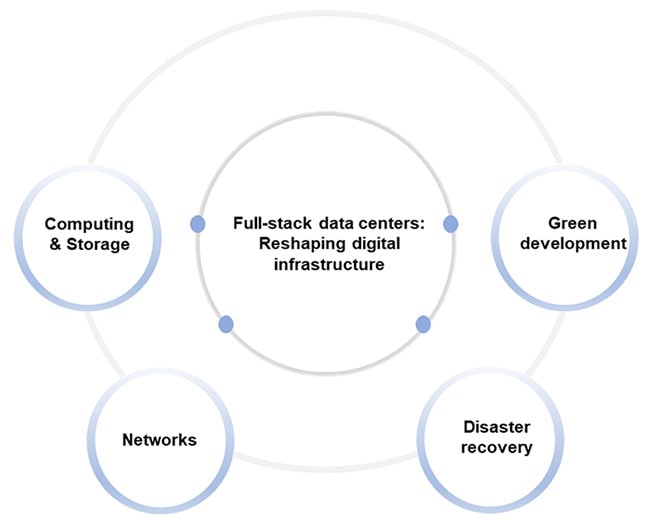
Huawei's full-stack data center solution reshapes computing and storage, networks, disaster recovery, and green development
Reshaping computing and storage to resolve performance bottlenecks
The trends of digital services, converged technologies, and data monetization are driving exponential growth in the demand for data and computing power. By 2030, the total amount of data generated worldwide is expected to reach 1 YB annually, a 23-fold increase over 2020. At the same time, the total amount of general-purpose computing required worldwide will reach 3.3 ZFLOPS, a tenfold increase over 2020. As technologies continue to evolve and Moore's law approaches its limit, traditional computing designed for a single purpose will be unable to meet more diverse service needs.
In response, Huawei's data center solutions focus on three areas:
All-flash acceleration in all scenarios. For main storage, and powered by a Non-Volatile Memory express (NVMe) Over Fabric Plus (NoF+) network and FlashLink algorithm, Huawei's OceanStor Dorado cuts latency to 0.05 ms and increases the number of e-invoices processed by 150%. For data analytics, Huawei's OceanStor Pacific improves performance density by 60% and accelerates analytics by 75% by using proprietary high-density all-flash architecture and distributed parallel clients. For data backup, Huawei's OceanProtect applies the intelligent direct TCP offload engine (DTOE) and intelligent multi-core algorithms to provide end-to-end acceleration, increasing backup bandwidth by 300% and shortening back up time for 1 PB of data by 70%.
Synergy between diverse computing resources: The digital transformation of different industries requires diverse computing applications and massive computing power. Huawei's FusionCube synergizes different types of xPUs to free up CPU resources and increase virtual machine (VM) density by 20%. It also resolves database performance bottlenecks, builds database resource pools, and migrates core services to cloud.
Multi-form resource coordination: Supported by the Huawei Cloud Stack (HCS) solution, multiple forms of resources, including hardware, virtualization, hybrid clouds, and public clouds, can be centrally managed and scheduled. This solution also allows for one-click application deployment and high scalability, cutting deployment time from days to hours.
Reshaping networks for one-stop private-line provisioning in minutes
Managing network capabilities is increasingly difficult when enterprises expand. Huawei's private-line solution offers:
Hyper-converged data center networks (DCNs) : provides three types of networks for converged storage, high-performance computing, and common services. All use all-Ethernet architecture, reducing TCO by 30%. Our iLossless algorithm optimizes network traffic in real time, ensuring end-to-end microsecond-level latency and zero packet loss while maximizing computing power.
Agile and efficient data center interconnect (DCI): uses 800G optical modules and Super C + Super L WDM technologies to increase the bandwidth per optical fiber to 96 Tbit/s and build a non-blocking network connecting data centers. Additionally, 5-ms switchover for network protection reduces packet loss caused by network self-healing by 90%.
Data-network synergy: uses configuration plane simulation technology to match service provisioning with live network resources, ensure network-wide connectivity, and enable one-stop private line provisioning in minutes. The service-aware Segment Routing IPv6 (SRv6) helps build a deterministic network SLA tunnel on backbone networks to guarantee SLAs for private lines.
Reshaping disaster recovery for ubiquitous, reliable assurance
Data center architecture is moving from standalone to geo-redundant, multi-location, and multi-active. Disaster recovery (DR) has become far more complex as a result of more diverse deployment environments. Huawei provides full-stack DR, full-cycle backup, and unified DR management, offering secure, reliable assurances for data center services anytime, anywhere.
Full-stack DR: provides a series of DR and coordination solutions such as cloud-native and storage solutions. Huawei's cloud-native solutions support end-to-end cloud service DR for multiple components such as containers, distributed cache service (DCS), relational database service (RDS), and object storage service (OBS). The storage layer uses gateway-free, active-active storage area network (SAN) and network attached storage (NAS), enabling geo-redundancy plus 99.99999% reliability and near-zero data loss. Our Storage Optical Connection Coordination (SOCC) technology shortens active-active link switchover time from 50 ms to 5 ms and I/O path switchover time from 1 minute to 1 second, ensuring zero service interruptions or congestion.
Full-cycle fast backup: uses backup media with a compression ratio of up to 75:1. Networks use a high compression ratio algorithm that saves 20% in network bandwidth, and the open ecosystem makes the solution compatible with mainstream backup software. Data images are reloaded to the cloud for reuse, maximizing data value.
Unified DR management: provides a one-stop, visualized, and unified DR management platform for end-to-end services, simplifying management and providing data centers with a holistic picture of system DR status.
Reshaping green development for low-carbon, energy-efficient data centers
Assuming a ten-year service life, the electricity cost of a data center accounts for more than 60% of TCO. Huawei's green and intelligent technology enables low-carbon, energy-efficient data centers spanning four areas:
Green construction: Our prefabricated modular FusionDC can be installed installed immediately after delivery. The "what you see is what you get" approach helps shorten end-to-end project delivery from 20 months to 6 months and reduces construction waste. More than 80% of construction materials can be recycled and a 1,200-cabinet data center can reduce carbon emissions by over 8,000 tons.
Green power supply and distribution: Our power modules adopt a highly integrated, modular design featuring high density and high efficiency, reducing the equipment footprint by 40%. The AI-powered predictive maintenance function monitors the service life of fans and capacitors in real time, improving reliability. And the intelligent online mode improves power supply efficiency from 94.5% to 97.8%.
Green cooling: Our indirect evaporative cooling system is a natural cooling system based on a macromolecular heat exchange core. It maximizes the use of natural cooling sources and reduces cooling system power consumption by 40-60%. Supported by AI, Huawei's iCooling solution adjusts cooling parameters in real time, so that cooling capacity can match service loads. PUE is cut from 1.4 to less than 1.2, lowering annual power use by at least 14%.
Green O &M: The AI-based digital management system NetEco can centrally and intelligently manage medium and large data centers, as well as multiple data centers. It monitors and adjusts power, environment, energy consumption, equipment status, and alarms, reducing O &M labor costs by 35%.
It is predicted that by 2026, more than 90% of computing power and data will be aggregated in data centers, with the global ultra-large data center market expected to be worth US$127.64 billion. As a leader in ICT infrastructure, Huawei is committed to doing what we do best in digital infrastructure: building full-stack data center solutions and providing software, hardware, and product portfolios that meet the needs of the digital age, help customers go digital, and achieve business success.


Benefits of Shared Cloud Networks from Healthcare Digitalization
As a pioneer of digitalization, the medical industry has huge market potential. How can carriers apply cloud-network strategies to open up opportunities from healthcare digitalization?

I. Exploring new business models for hospital digitalization in China
China's healthcare industry reform covers three major areas: medicine, health insurance, and medical care . Of these, medical care is relatively easy for carriers to provide digital transformation services for. There are three levels of medical institutions, and the strategies and difficulties for carriers to get involved in the market depend on each level's different requirements.
At the bottom level are integrated healthcare organizations, which include county and township-level hospitals and primary-level clinics. These are led by upper-level hospitals, of which there are now more than 4,000. These organizations belong to an emerging market characterized by limited customization, relatively uniform requirements, strong dependence on government investment, and the small size of individual members. Therefore, independent software vendors (ISVs) are not willing to enter this market.
To digitalize this type of organization, carriers can adopt the "network + cloud + applications" model, with networks playing a primary role. A relatively easy path for carriers is to link and vertically integrate large numbers of organizations.
Medium-level medical institutions include individual hospitals, medical alliances, and specialist alliances in provinces, cities, and counties. These organizations expect extensive customization, have high requirements, and belong to the traditional market. Among them, the top 150 grade-A tertiary hospitals are largely digitalized, and this market is dominated by ISVs. For the digitalization of individual hospitals, carriers can adopt the "application + cloud + network" model, with applications playing a primary role. They can build industry clouds and transform multiple existing private lines into private networks to support legacy LAN demands so as to enhance customer loyalty. The "network + cloud + application" model can be adopted for the digitalization of other ordinary hospitals.
At the top level are authorities such as the National Health Commission, which directly builds and manages the comprehensive health IT platforms and private network projects.
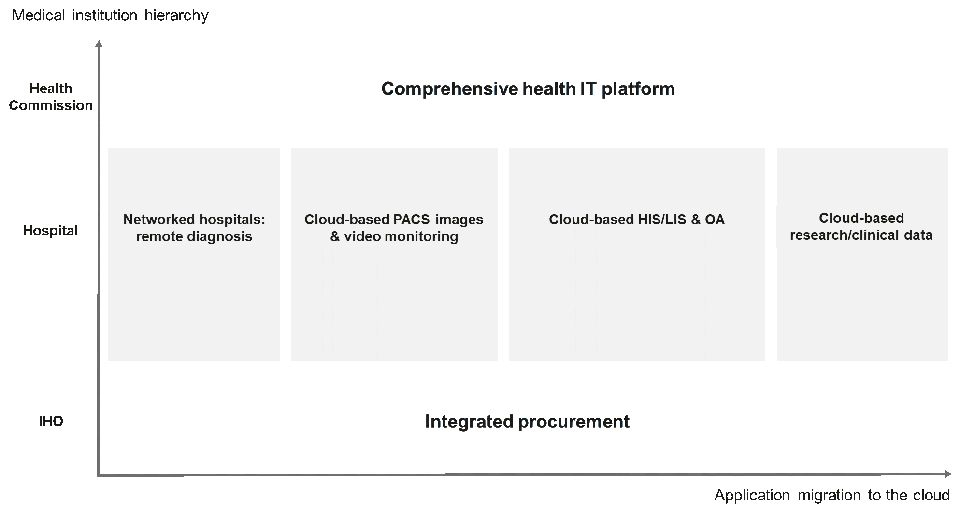
Figure 1: China's healthcare digitalization progress and needs
Carriers can deploy different solutions to address the above scenarios.
1. Top grade-A tertiary hospitals: Vertical integration that leverages applications and industry clouds
It is not easy for carriers to develop digitalization projects with top grade-A tertiary hospitals. First, top tier-3 hospitals have strong ICT capabilities and well-established IT systems. They can be digitalized quickly, and most of their fservices are provided by ISVs. Second, these ISVs deeply understand the pain points of hospitals and meet their customized needs for functionality and experience through application iteration. Third, although these hospitals invest heavily in digitalization, connectivity normally accounts for no more than 10% of investment. Therefore, carriers typically only provide resources such as private lines and equipment rooms, and their role is often one of being integrated.
To address this passive situation, carriers can seize the opportunity of application migration to the industry cloud by first focusing on fostering cloud+network services with a small number of customers, and then promoting them to more hospitals.
For example, in the digitalization project of a hospital in Guizhou Province, the hospital migrated the picture archiving and communication system (PACS) to the cloud between 2019 and 2020 to meet the classified protection compliance requirements of the Health Commission. The carrier worked with two PACS partners to provide cloud+network services for the hospital and other medical alliance members. The carrier also heeded the specifications of Guizhou Province Development and Reform Commission for a charging standard for the PACS imaging service and worked with ecosystem partners to jointly develop users through a revenue-sharing model. This model reduced the cost of using films in the radiology department and for expanding PACS storage capacity, while shortening waiting time for patients, giving them easy access to images for telemedicine and hospital transfer.
2. General tertiary hospitals: Focusing on localized "cloud + network + security" solutions as general integrators of digital infrastructure
The IT departments of general tertiary hospitals used to be effective in supporting hospital digitalization. However, the explosion in digital services is placing an increasing burden on IT departments. Therefore, hospitals began to raise demands for localized and specialized cloud+network services, which provided a window of opportunity for carriers to serve as general integrators.
For example, the largest grade-A tertiary hospital in a city in Shanxi Province has established a full set of IT systems, including a hospital IT network and integrated medical big data platform. The hospital's current digitalization project aims to build a dedicated cloud platform and make the hospital intelligent over the next five years. This requires security in five areas: cloud, cybersecurity, data, the core hospital network, and the migration process. The hospital chose a carrier rather than an ISV or public cloud vendor to implement the project. There were a few reasons for this choice:
1) In general prefecture-level cities, grade-A tertiary hospitals withwell-established IT systems are weakly covered by ISVs and public cloud vendors, whereas carriers have B2B key account managers and industry solution development teams, with advantages in providing localized pre-sales, in-sales, and post-sales services.
2) In general tertiary hospitals, existing digital talent cannot meet the needs of rapidly growing digital services. Given insufficient onsite ISV employees, the local self-construction and self-maintenance model no longer applies. With the development of intelligent hospitals, hospital networks, platform upgrades and cloud migration are urgently needed. These are exemplified by insufficient local equipment room space, high usage of hardware resources like servers, difficult integration and elasticity of hardware, and O &M workloads that increase by five to ten times to the virtualization and complexity of software. Hospital IT staff are increasingly overwhelmed.
3) Carriers provide localized, ubiquitously secure, integrated cloud-network-security solutions based on premium private lines to meet hospital needs for reliability assurance and the security isolation of important services. Carriers' cloud private line, network slicing, and graded protection solutions ensure end-to-end data reliability and security. Carriers' localized two-city, three-DC geo-redundancy and disaster recovery solutions developed in collaboration with specialized partners are highly regarded. Carriers also provide solutions such as three-route protection and single-node-free processes to ensure uncompromised total bandwidth and latency, even when individual routers are faulty.
4) Leasing rather than building the hospital network enables shared success. Hospitals only need to purchase services for the dedicated cloud platform, in-hospital core switches, and firewalls, greatly reducing the costs and burden of digital infrastructure planning, construction, and O &M. For carriers, connectivity accounts for a larger proportion of investment, making it easier for them to serve as general integrators.
3. IHOs and secondary hospitals: Building a digital infrastructure platform
Carriers are clearly more competitive in IHO digitalization projects. First, ISVs and public cloud vendors have limited involvement and investment in this market for a number of reasons, including the limited investment in digitalization and the standardized medical application requirements of county- and township-level hospitals. Second, IHOs have strict requirements on the reliability and security isolation of core services. Third, connectivity accounts for up to 30% of investment of IHO digitalization projects, making it easy for carriers to serve as general integrators. Therefore, carriers can build digital infrastructure platforms by focusing on localization.
As a pilot region for China's healthcare reform, Ningxia Province launched a county-level healthcare reform pilot project in 2019, aiming to develop a shared and unified digital IHO platform as the underlying infrastructure for the various IT systems of IHO members. In the future, township hospitals and community health service centers will be equivalent to departments of the municipal people's hospital, with whom medical resources will be shared, collaborative diagnosis performed, and electronic medical records acquired remotely. Patients will no longer have to go through repeated registration. They will be able to obtain prescriptions through teleconsultations, and receive examinations and pick up medicines locally. An IHO in Ningxia consists of a secondary hospital and more than a dozen community and township hospitals. The IHO's digital infrastructure project involves equipment room upgrades, network migration, cloud private lines, and cloud resources. One carrier won the bid exclusively.
Many secondary hospitals are IHO leaders. For example, the largest county-level secondary hospital in Anhui Province is both a member of a close medical alliance led by a municipal-level hospital and the leader of an IHO joined by ten township health centers. This hospital is a crucial part of the carrier's efforts to promote IHO digitalization. However, the digitalization progress of different IHO members varies greatly, which means the digitalization project of this hospital is more suitable for individual development beyond the IHO.
II. Practices of carriers outside China: Cloud-based access and connecting the unconnected
Globally, carriers are also making strategic adjustments and exploring opportunities in healthcare digitalization. The healthcare industry varies by region, and digitalization progress varies greatly. Healthcare digitalization projects around the world are using unique business models. Two examples are given below:
1. Renowned private hospital: Infrastructure-based vertical integration
Healthcare digitalization in some Southeast Asian countries, such as Malaysia and Thailand, are similar to China in terms of progress and projects. In February 2021, the Malaysian government proposed the Malaysian Digital Economy Blueprint (MyDIGITAL) to boost the country's digital transformation. This blueprint involves a cloud-first strategy, with 80% of public data migrated to the cloud by the end of 2022. A leading carrier in the country is playing a crucial role in implementing this national cloud strategy and digital infrastructure construction.
A renowned private healthcare hospital in Malaysia has the typical need for migrating its hospital information system (HIS) to cloud, while also requiring better value-added digital services, including data security, storage and backup, reliability assurance, and disaster recovery. The hospital's IT department also expects their O &M burden to be reduced through asset-light operations and one-stop services.
Similar to the example of the grade-A tertiary hospital in Shanxi, China, thehospital in Malaysia has also chosen a leading carrier to undertake its digitalization project. There are three reasons for this choice: First, the partnership is well-established, as the carrier has provided private line services for hospitals for a long time. Second, the carrier is constructing Malaysia's sovereign cloud, so it is the preferred choice for supporting the cloud migration of public health data. Third, the carrier's localized, integrated cloud-network-security solution meets the hospital's needs.
2. Hospitals in the initial stages of digitalization: Connecting the unconnected with cross-border cloud resources
In countries like Uganda and Pakistan, where healthcare digitalization is still in its early stages, many hospitals are yet to be informatized and still rely on paper to share medical information. However, carriers still have business opportunities in these markets. They can focus on strengthening connectivity, improving telecom infrastructure, and leveraging cross-border cloud resources.
For example, Uganda's healthcare industry is in the process of being informatized, with about 300 hospitals covering only half of all households capital city. The COVID-19 pandemic has boosted the country's need for healthcare digitalization, including connectivity coverage, fast provisioning, service visibility and assurance, and simplified O &M.
Against a blue ocean of industry digitalization, one Ugandan carrier is adopting a new strategy and embracing cloud transformation. On the network side, the carrier is using private lines to connect more hospitals and provide a visible and guaranteed private line experience for hospitals. It also provides differentiated services for typical use cases such as hospital interconnections, remote consultation, video monitoring, and online skills training, giving more homes and remoter areas access to medical resources through networks. On the cloud side, as Uganda does not yet have public cloud resources and carriers cannot yet deploy their own clouds, the carrier is taking advantage of its cross-border network, leveraging cross-border cloud resources and multi-cloud interconnection services planned by the group.
The development of healthcare digitalization projects requires both strategic determination and investment, as well as new mindsets and approaches. While exploring business opportunities, carriers must gain deep insights into industry needs, quickly develop solutions, and define appropriate business models. Huawei will work with carriers to innovate and grow, and support carriers in upgrading and deploying cloud and networks. The collaboration between carriers and Huawei will help the healthcare industry realize data-driven, intelligent operations, and enable carriers to develop a competitive edge in the market and share the benefits of cloud and networks.
Trends. Insights. Innovation.
Learn about our privacy policy
Please check your email
We have sent an activation email to your subscription email. Please click the activation link in the email to complete the subscription.
You have submitted your subscription!
Failed to subscribe.
Please contact us at: website@huawei.com
Thanks for subscribing.
